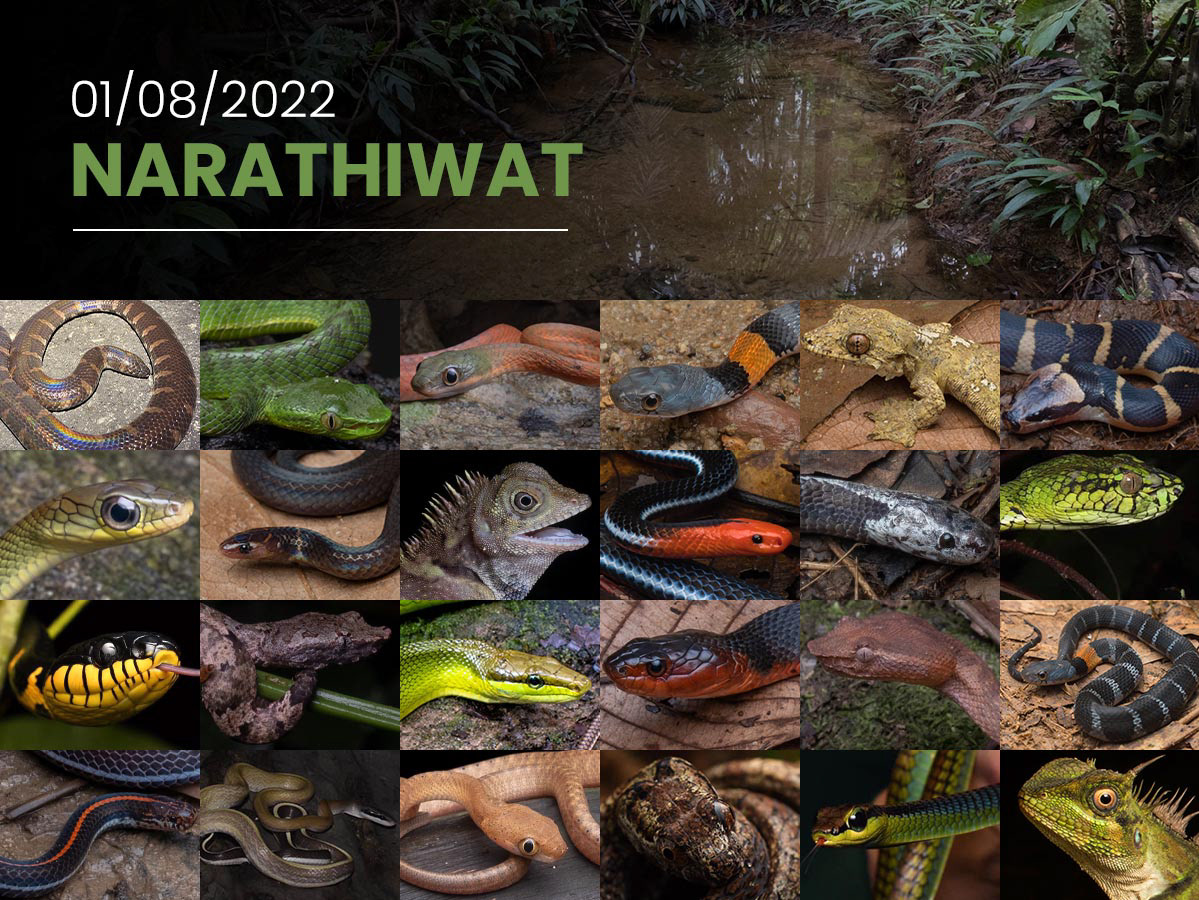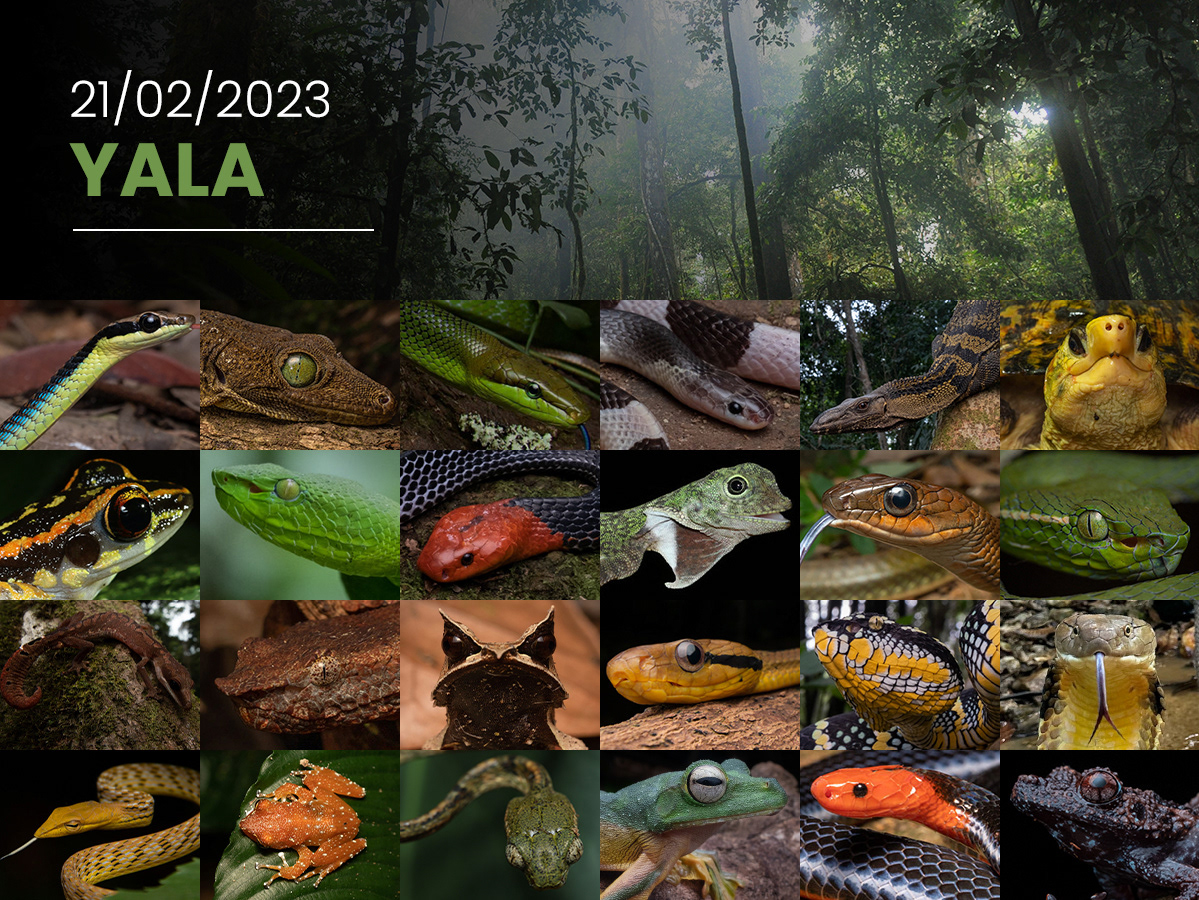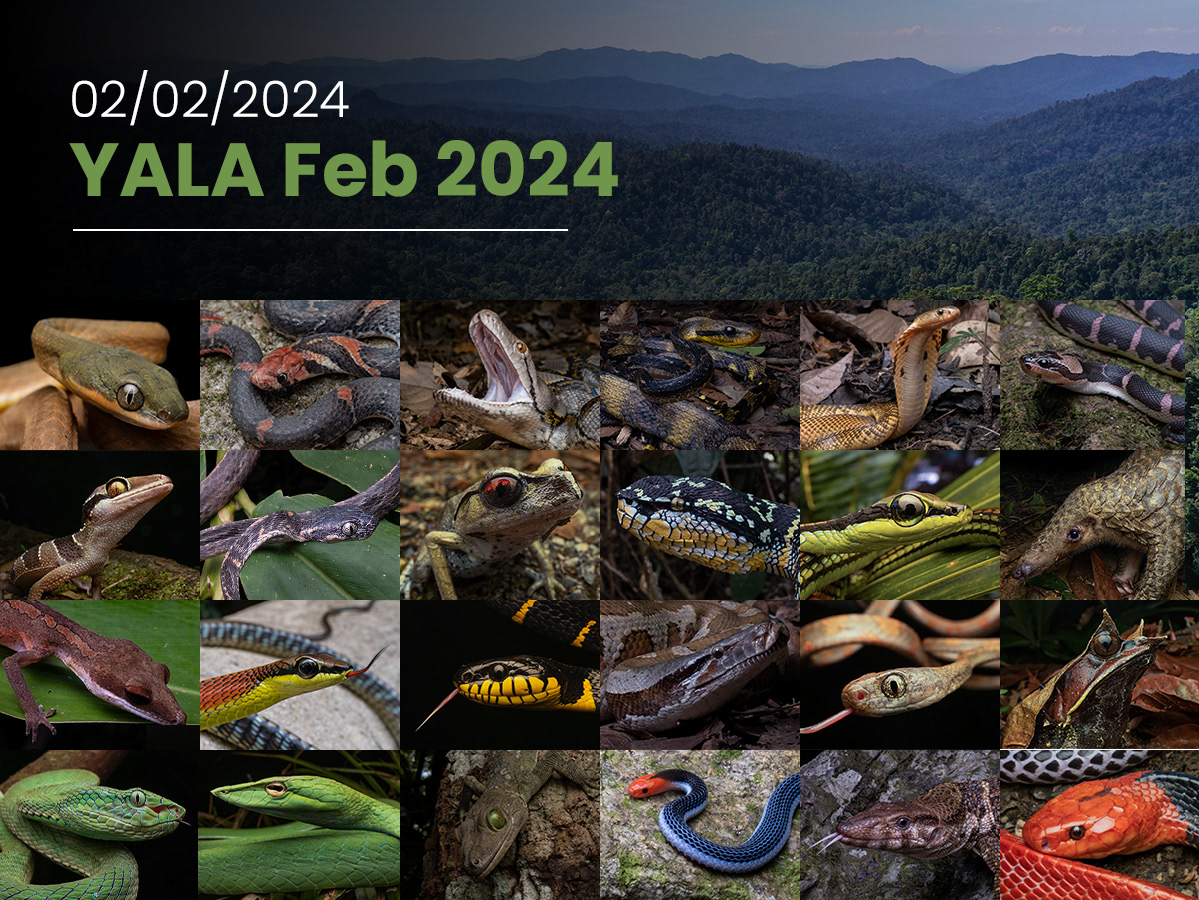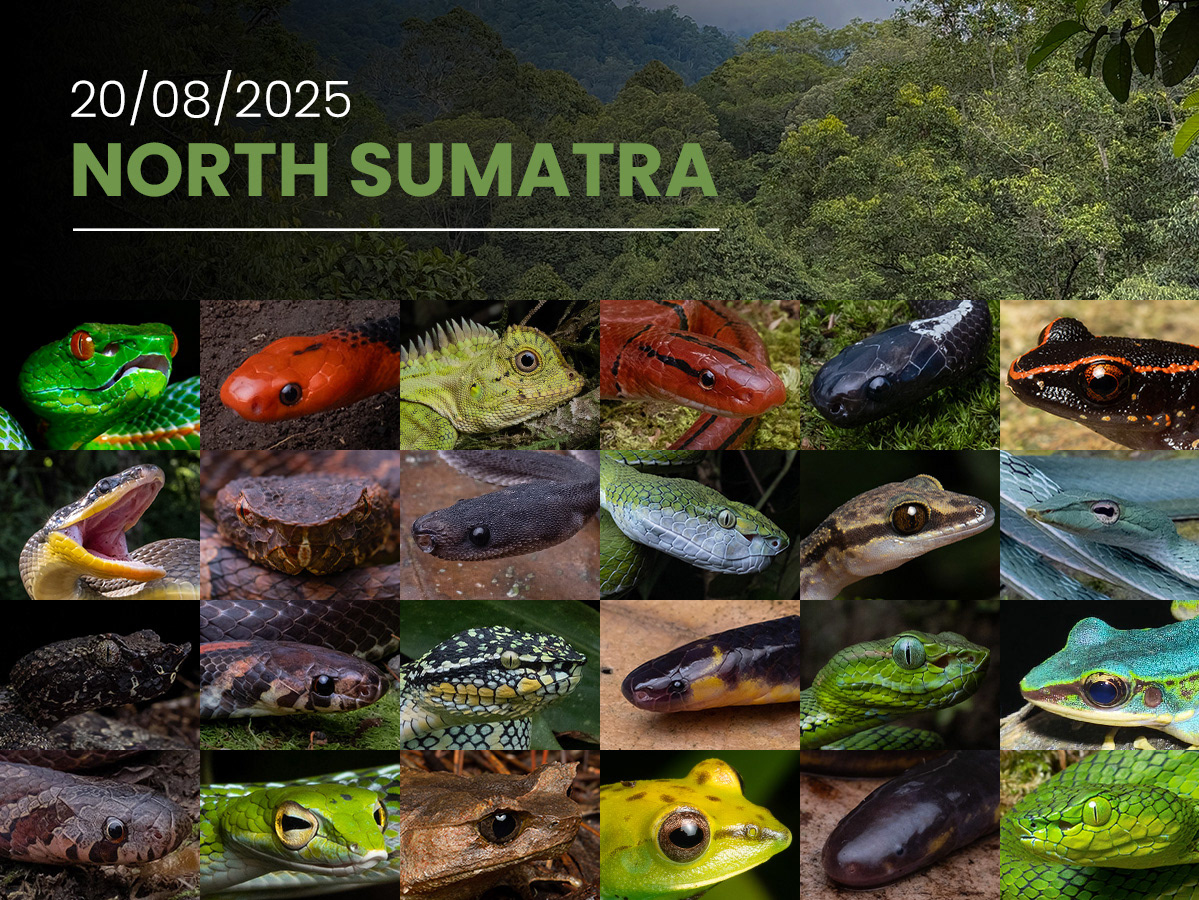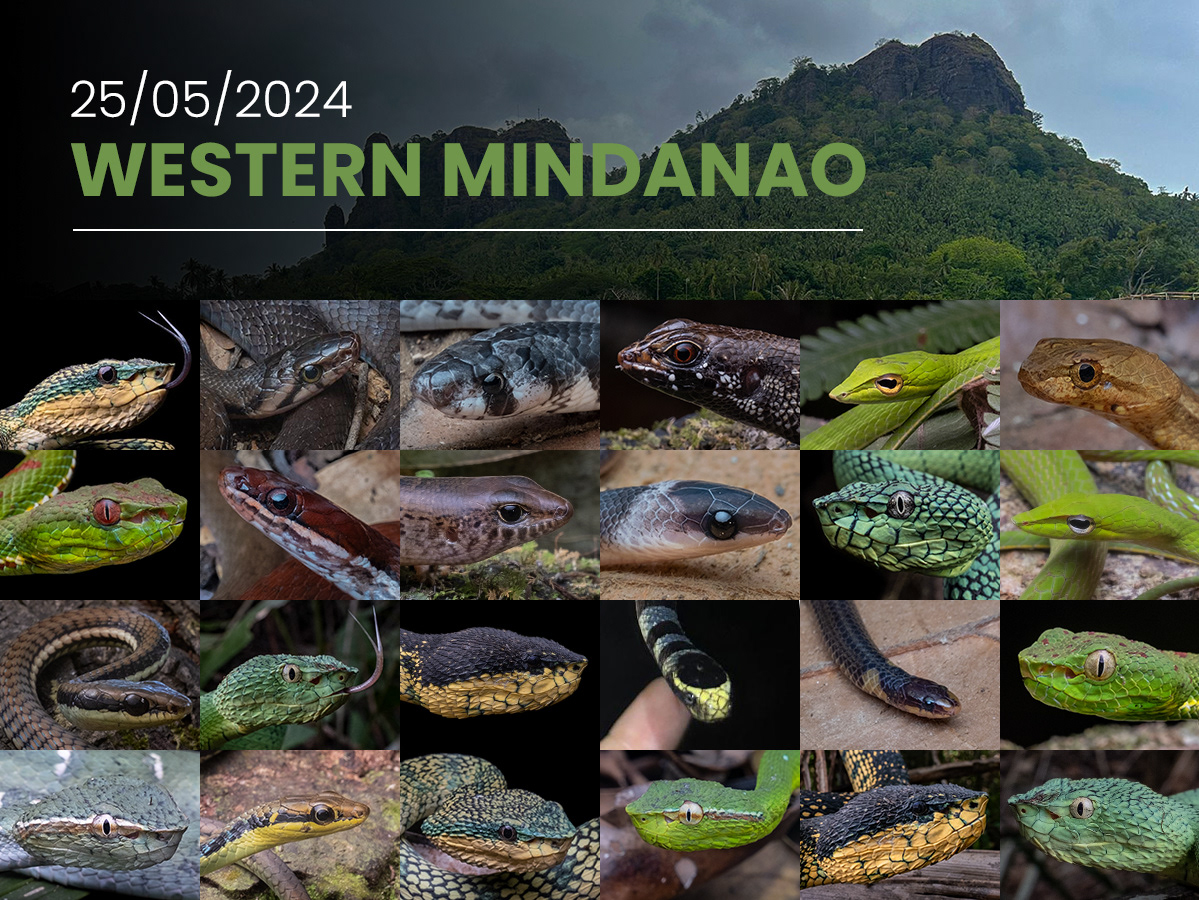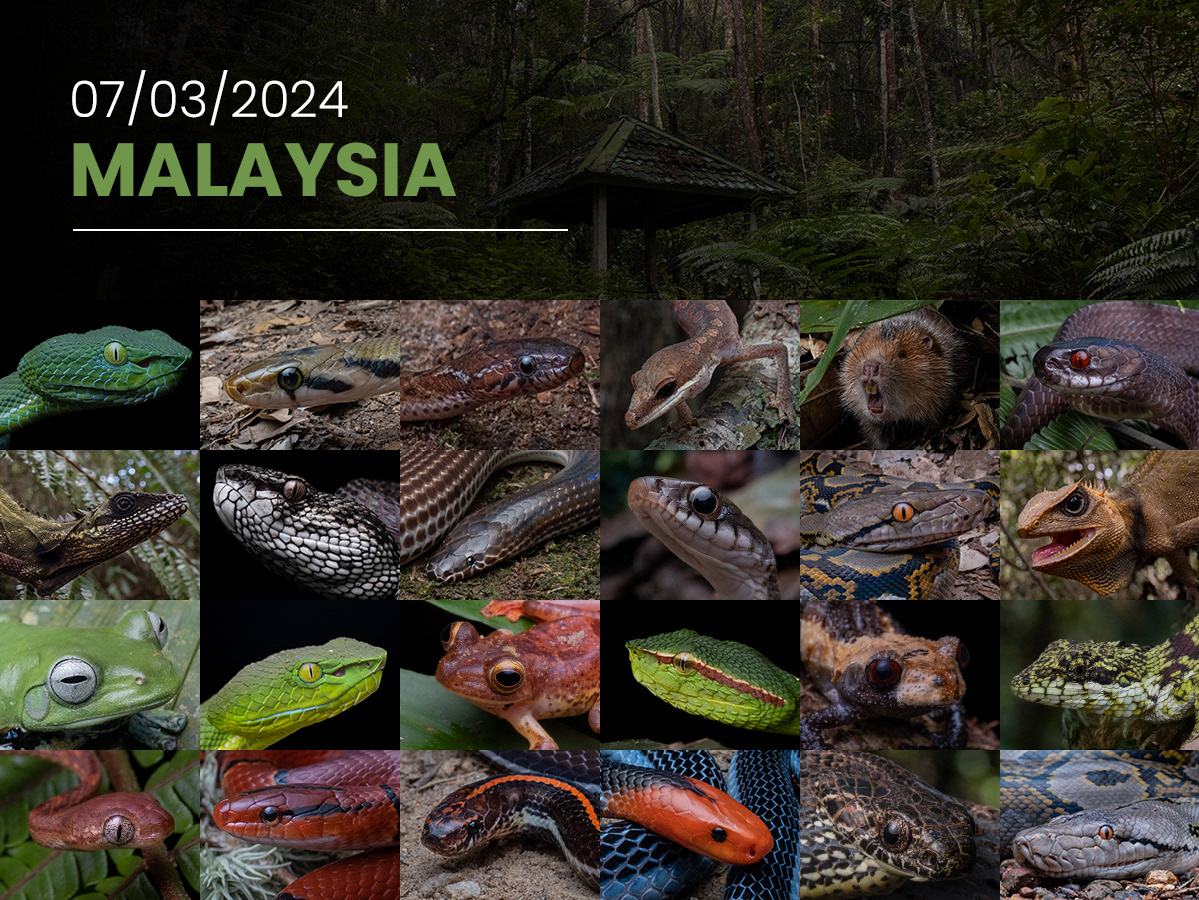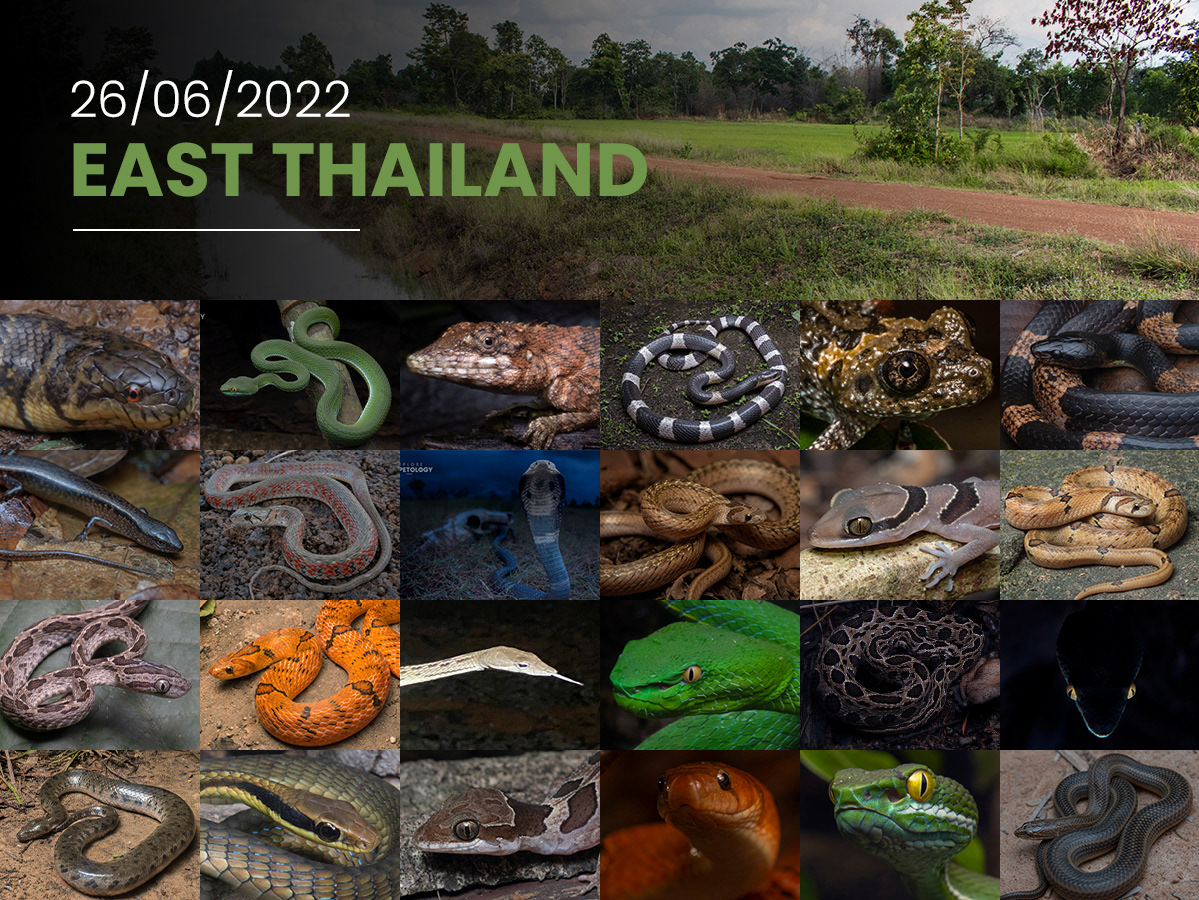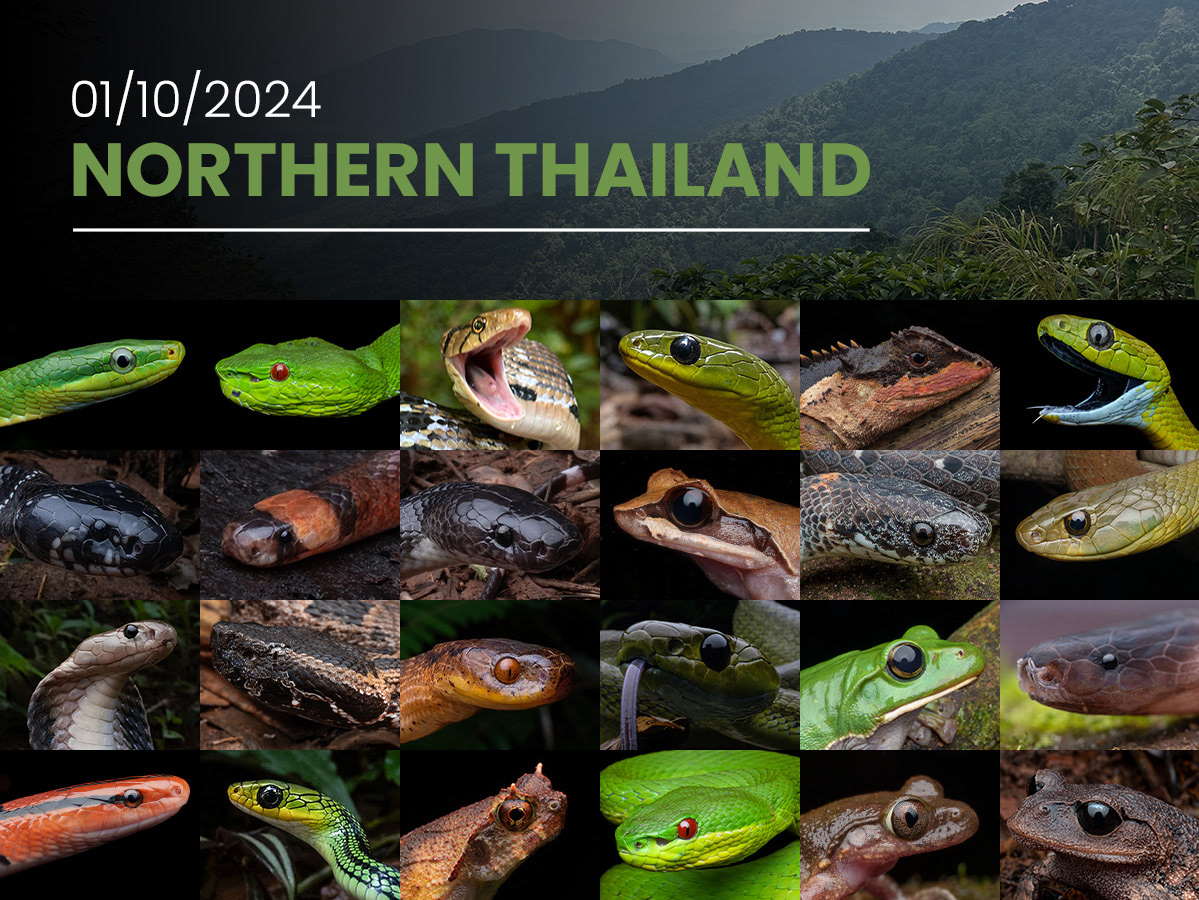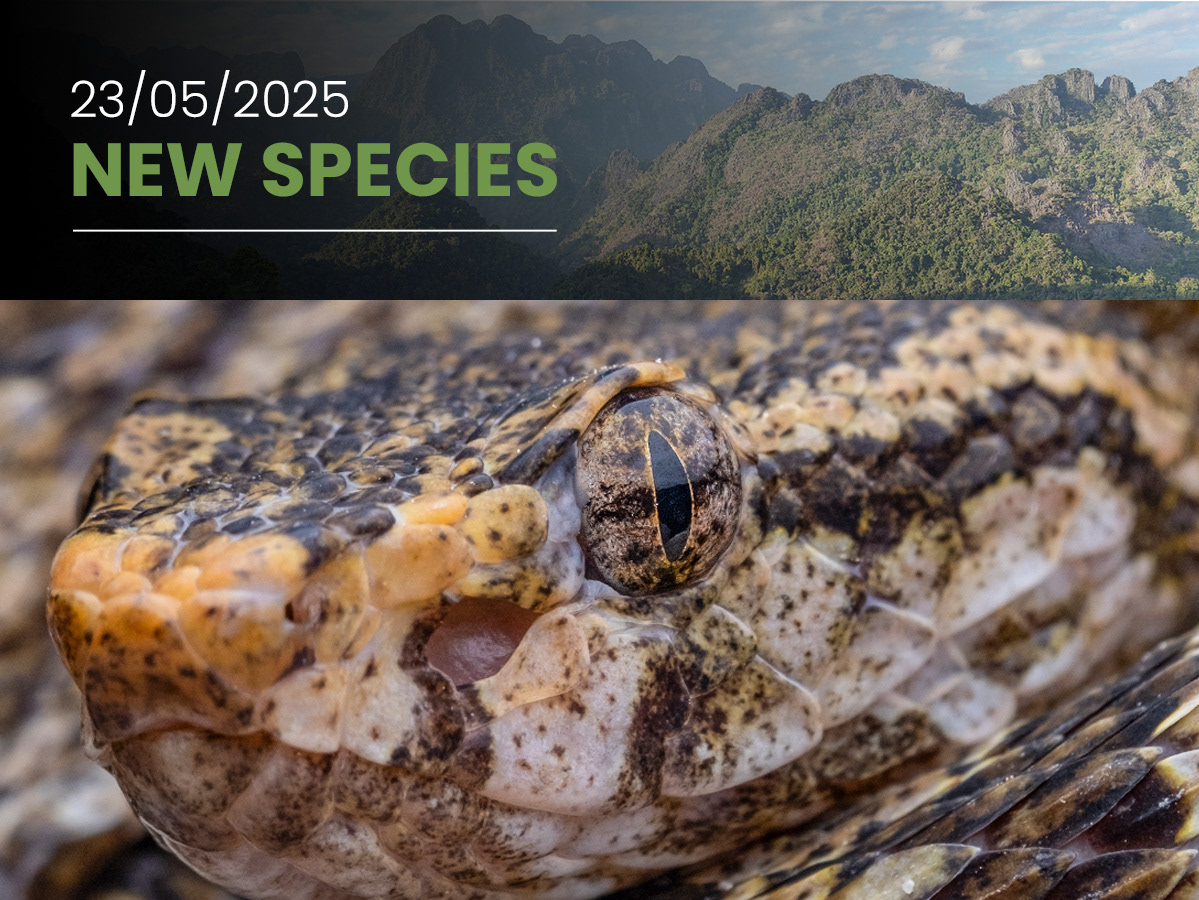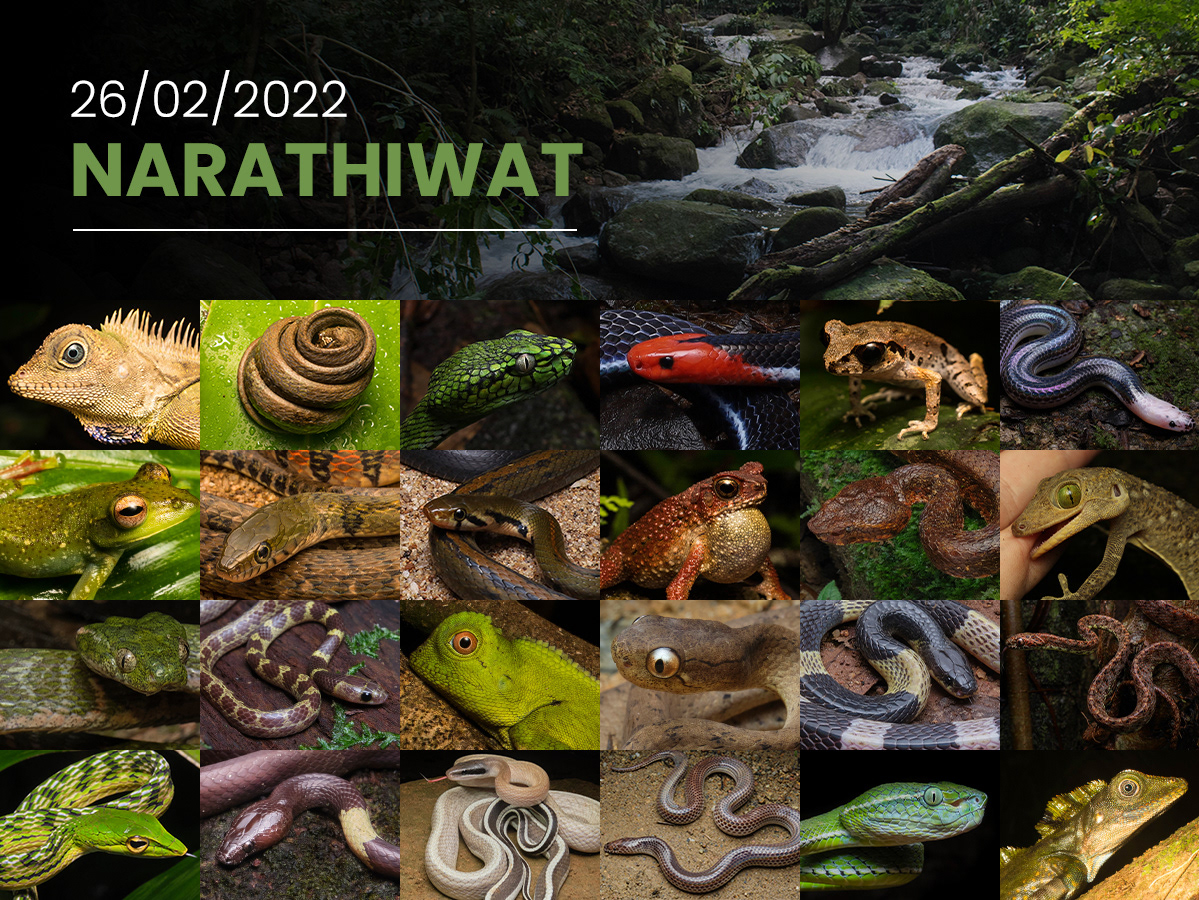For our second group herping expedition, we once again returned to Southern Thailand. However, this time it would be a road trip spanning 11 nights across 5 different locations, specifically targeting iconic species at each location.
The trip began on Phuket Island, where our key targets would be Wagler’s pit viper (Tropidolaemus wagleri) and Phuket pit viper (Trimeresurus phuketensis). Thus, after a brief introductory talk and a late lunch, we geared up and headed out into the field for the first night of the trip.

Bone app the teeth!
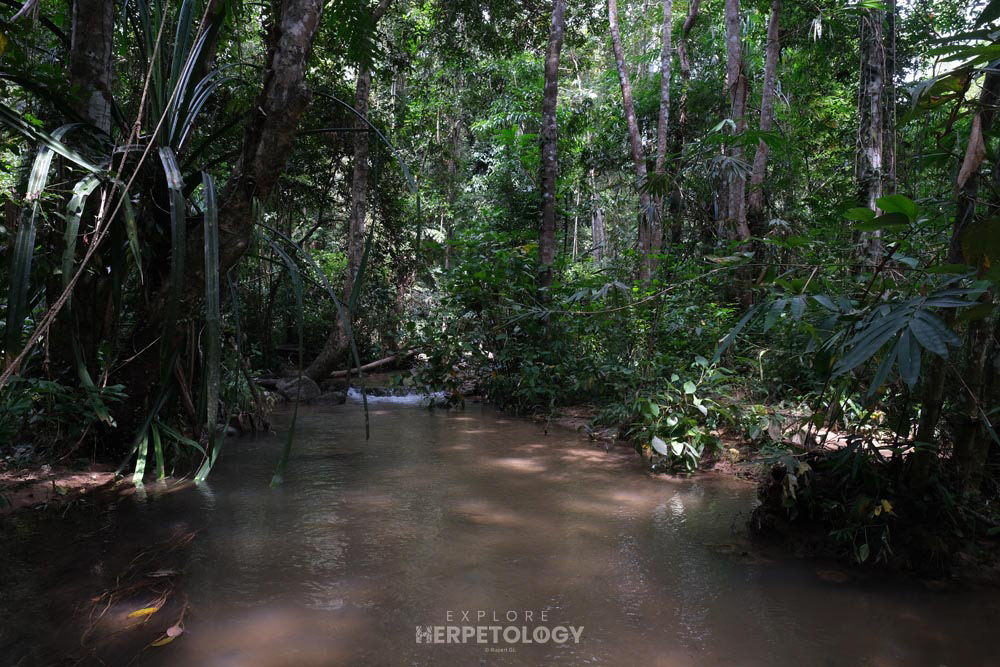
Phuket jungle habitat
Within the first 5 minutes of walking, we found a young female Wagler’s pit viper (Tropidolaemus wagleri) which was very high up a tree, a large Asian vine snake (Ahaetulla prasina) and surprisingly a male Phuket pit viper (Trimeresurus phuketensis) - crossing the concrete steps right in front of us.
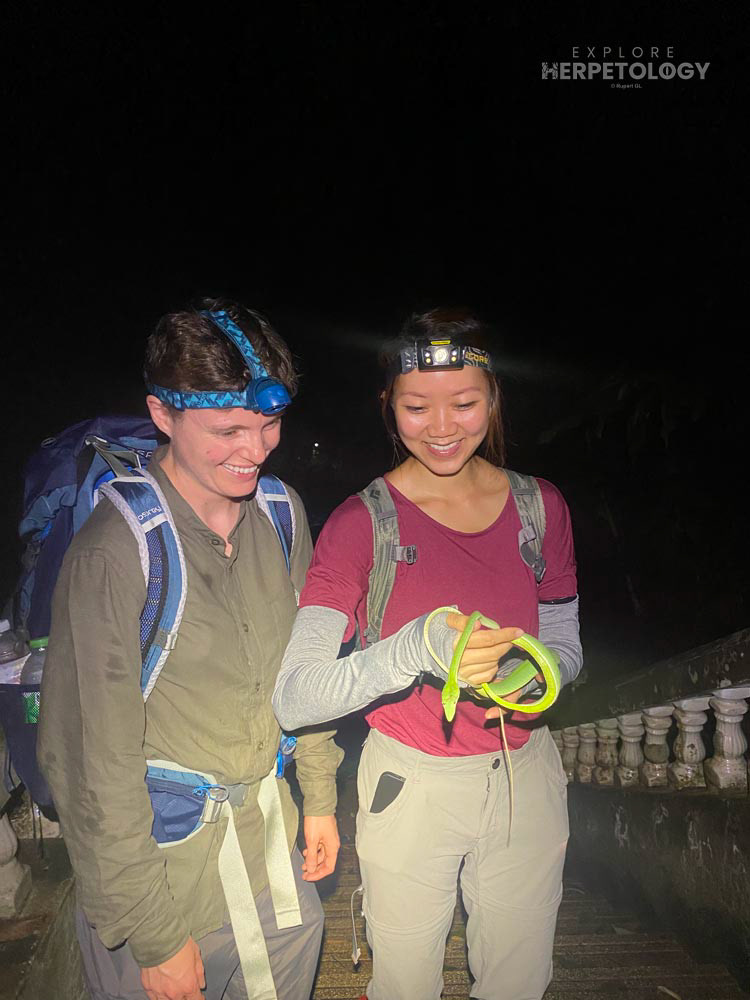
Adult female Ahaetulla prasina (Oriental vine snake)
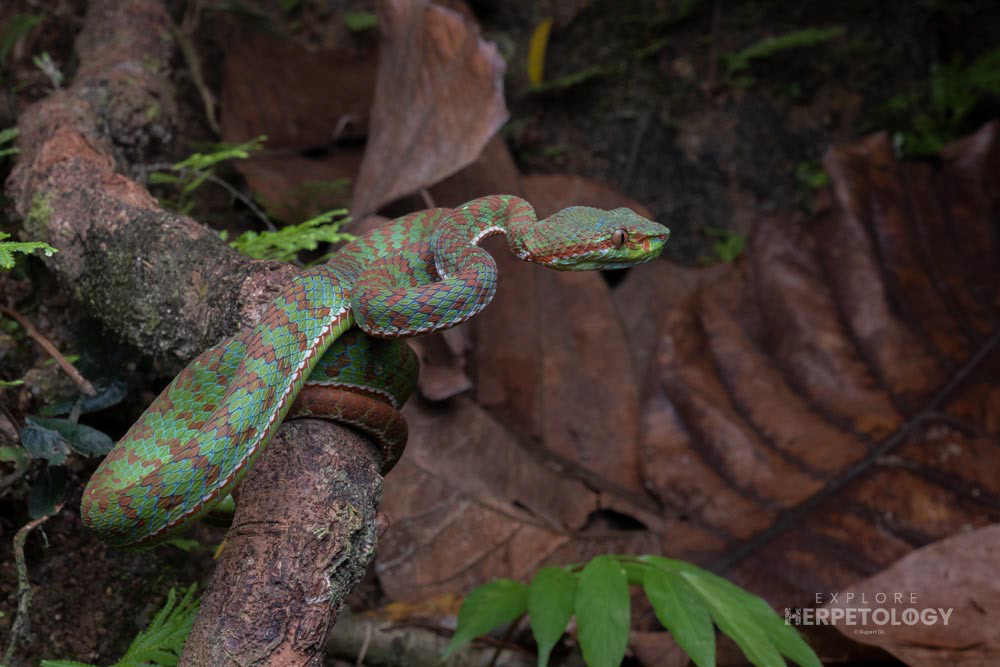
Adult male Trimeresurus phuketensis (Phuket pit viper)
The fun did not stop here, as minutes later we caught both a triangle keelback (Xenochrophis trianguligerus) and a young reticulated python (Malayopython reticulatus). Once we were done taking photos of these two snakes, Phakawat walked a few meters away and spotted a lovely adult female Wagler’s pit viper (Tropidolaemus wagleri), meaning we had found both our key targets in the first 30 minutes of searching. We also found a cute Kuhl’s gliding gecko (Gekko kuhli) one bush over from the Wagler’s.
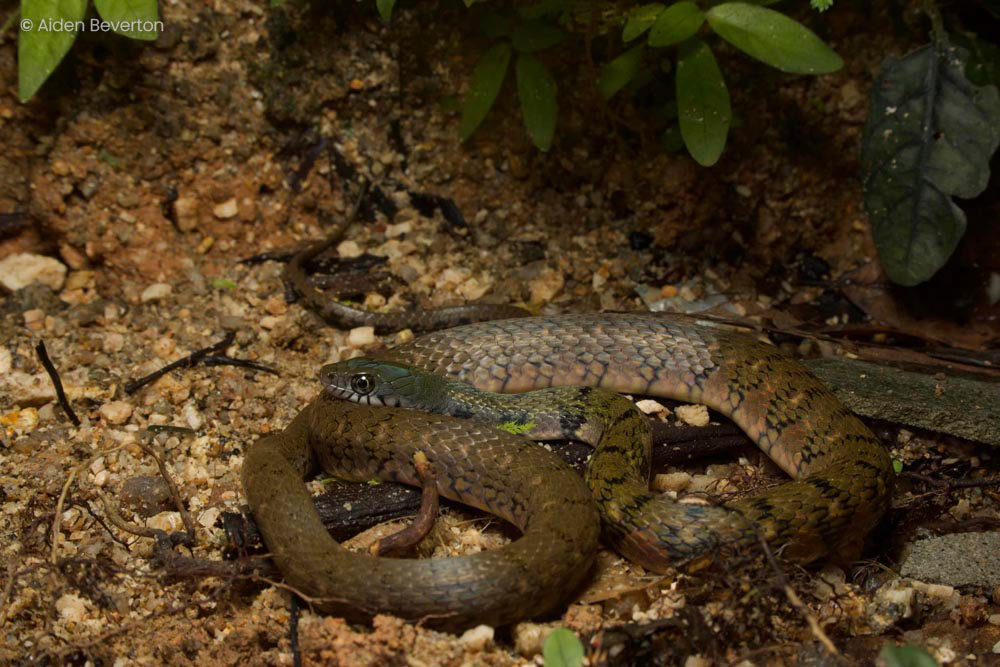
Triangle keelback (Xenochrophis trianguligerus)
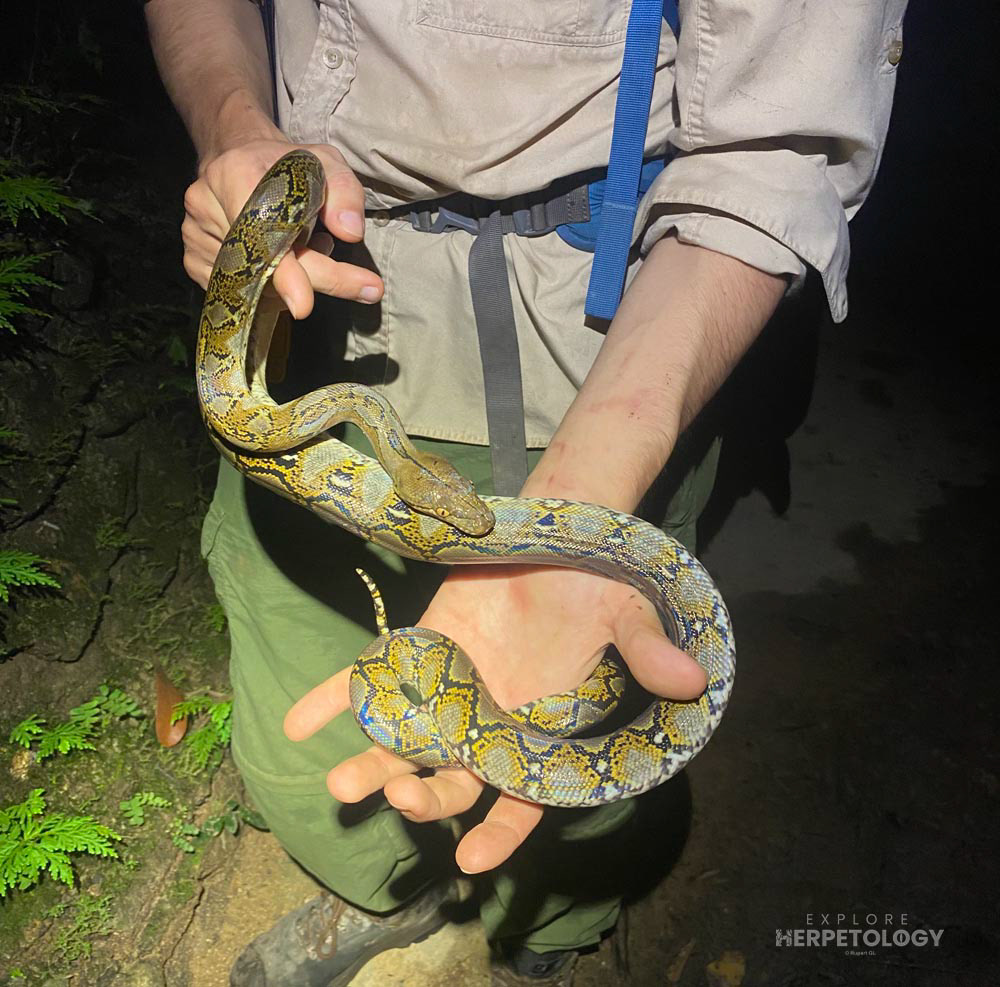
Subadult Malayopython reticulatus (Reticulated python)
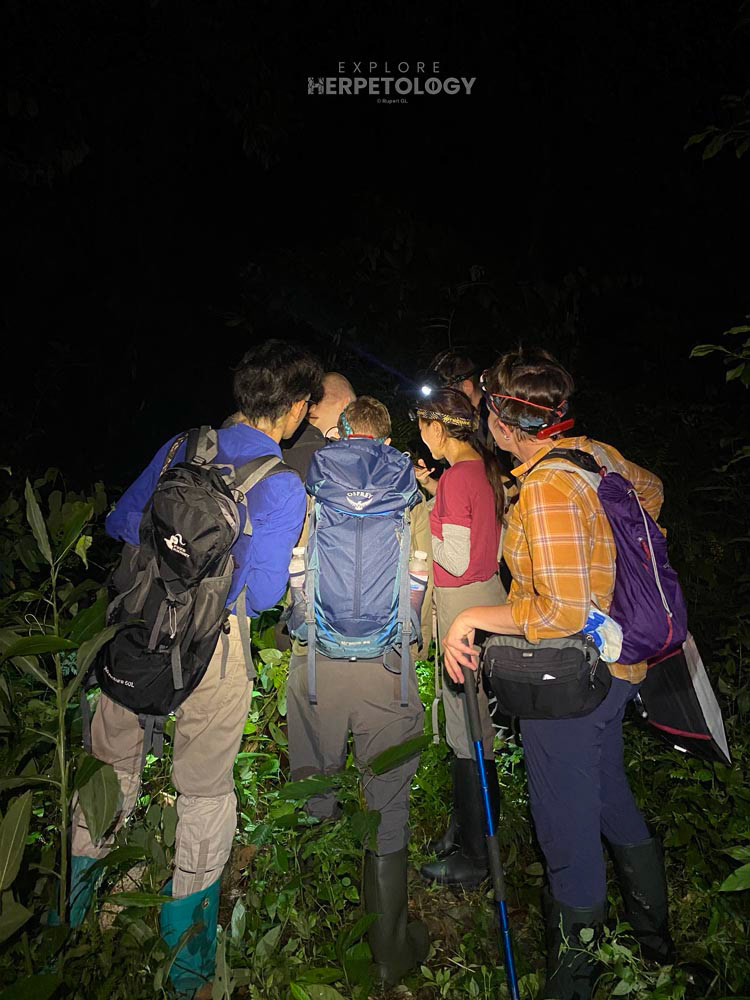
Gecko gathering
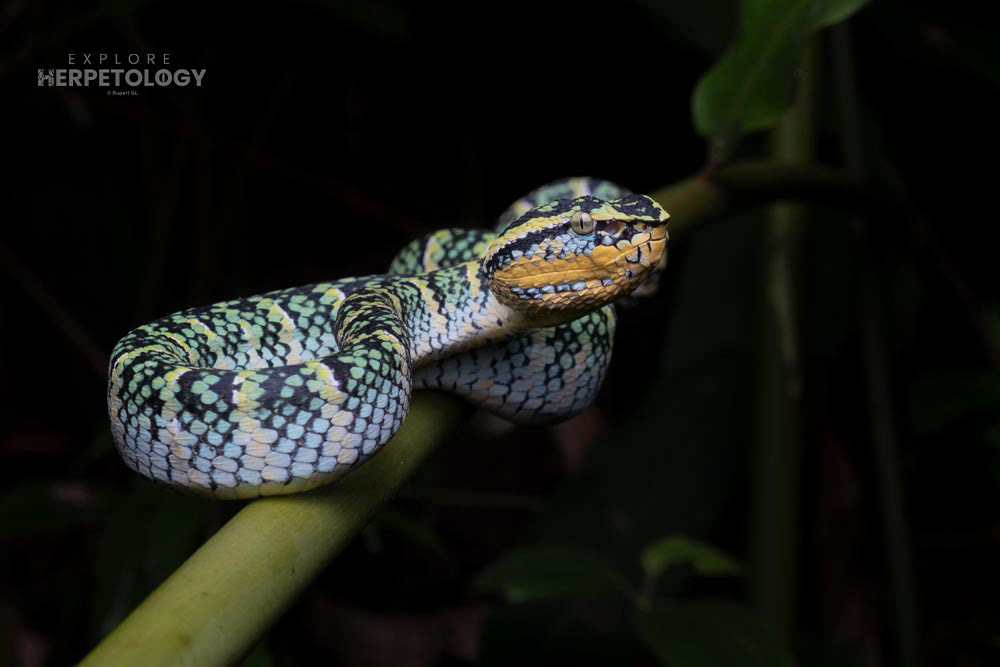
Female Tropidolaemus wagleri (Wagler's pit viper)
Further up the trail, we found a sleeping juvenile white-bellied rat snake (Ptyas fusca), and a little further up our first Malayan krait (Bungarus candidus) of the trip. This individual was deep in slough, hence the bluish tinge.
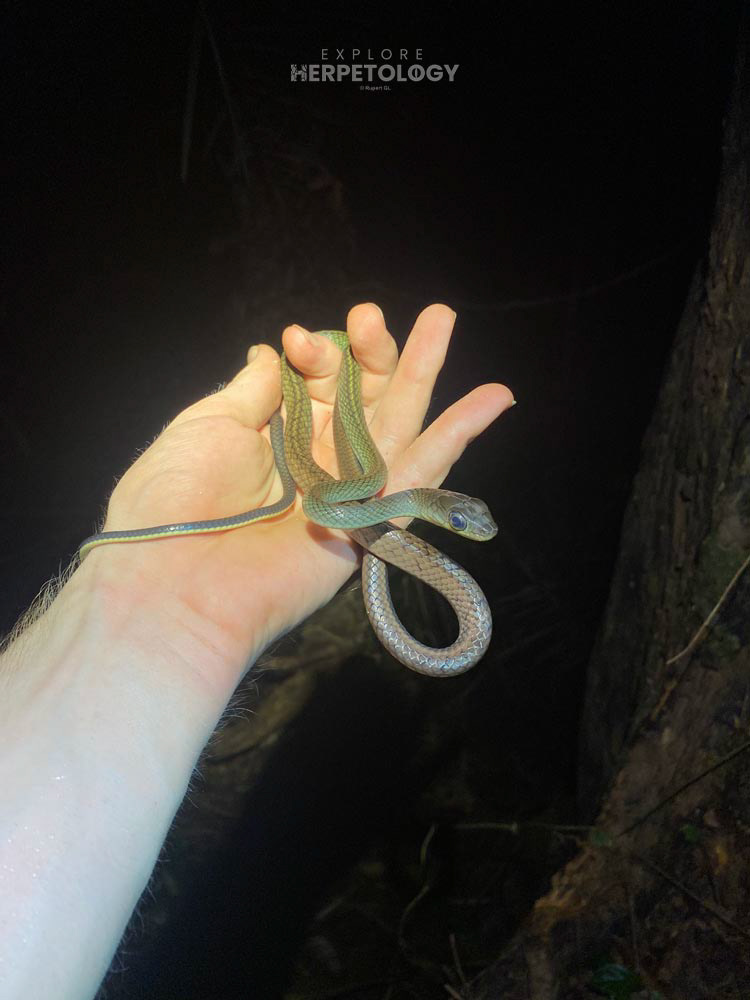
Juvenile Ptyas fusca (White-bellied rat snake)
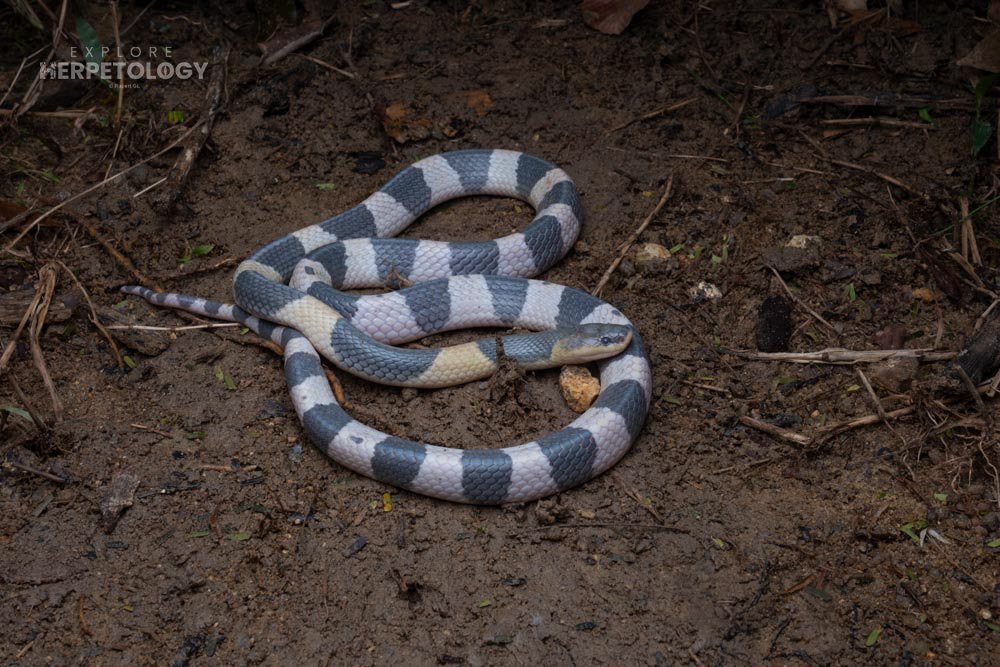
Bungarus candidus (Malayan krait)
After this initial frenzy, we did not see any more snakes for a while. In the meantime, we encountered a few other interesting herps, including Oldham’s bent-toed gecko (Cyrtodactylus oldhami), large-tubercle bent-toed gecko (Cyrtodactylus macrotubercalus) and a super cool Smith’s litter toad (Leptobrachium smithii).

Oldham’s bent-toed gecko (Cyrtodactylus oldhami)
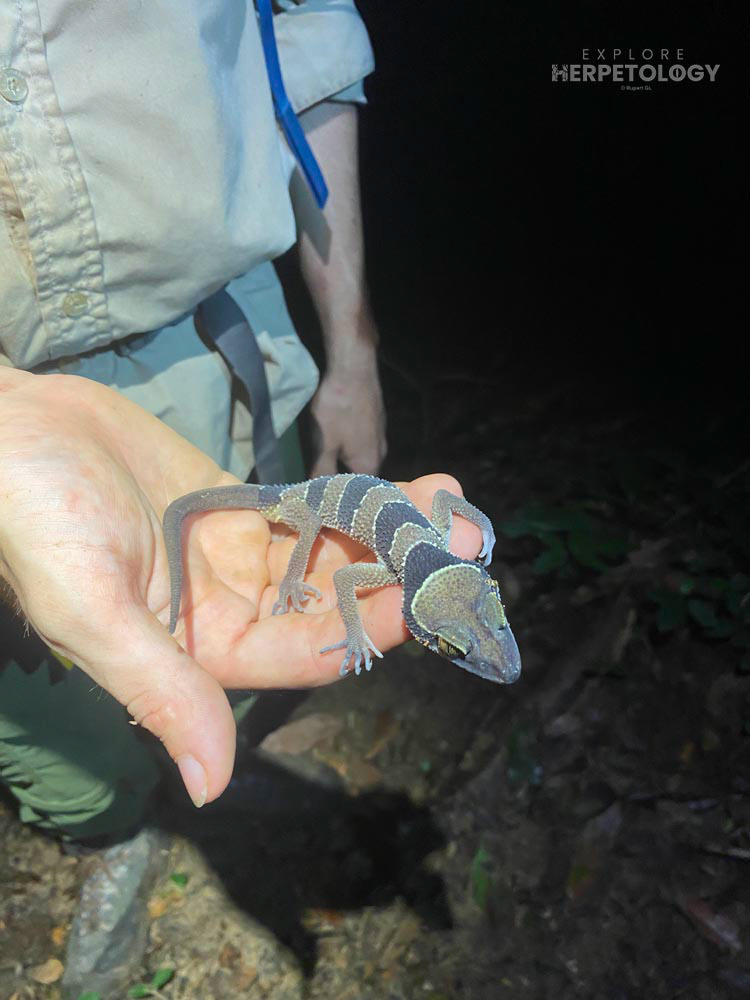
Large-tubercle bent-toed gecko (Cyrtodactylus macrotubercalus)
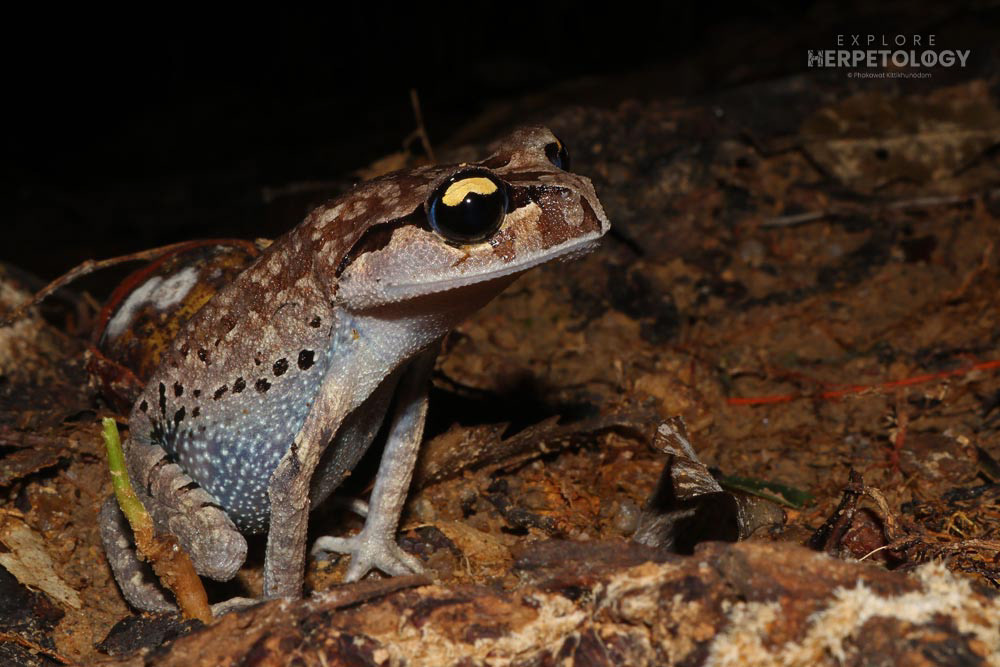
Smith’s litter toad (Leptobrachium smithii)
The next snake we found was yet another new species for the night, a juvenile mock viper (Psammodynastes pulverulentus), followed by an adult female Phuket pit viper (Trimeresurus phuketensis). The very last snake we saw on the first walk of the trip was the most special, a juvenile purple kukri snake (Oligodon purpurascens), a first of the year for us. This took us to 9 species of snake on the first night, a sensational start.
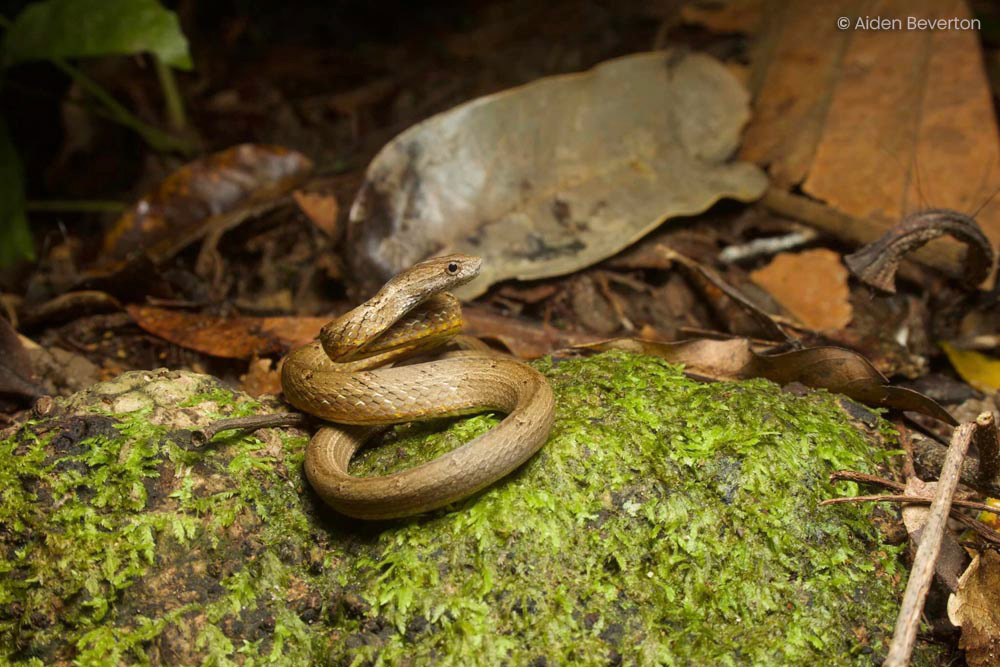
Mock viper (Psammodynastes pulverulentus)
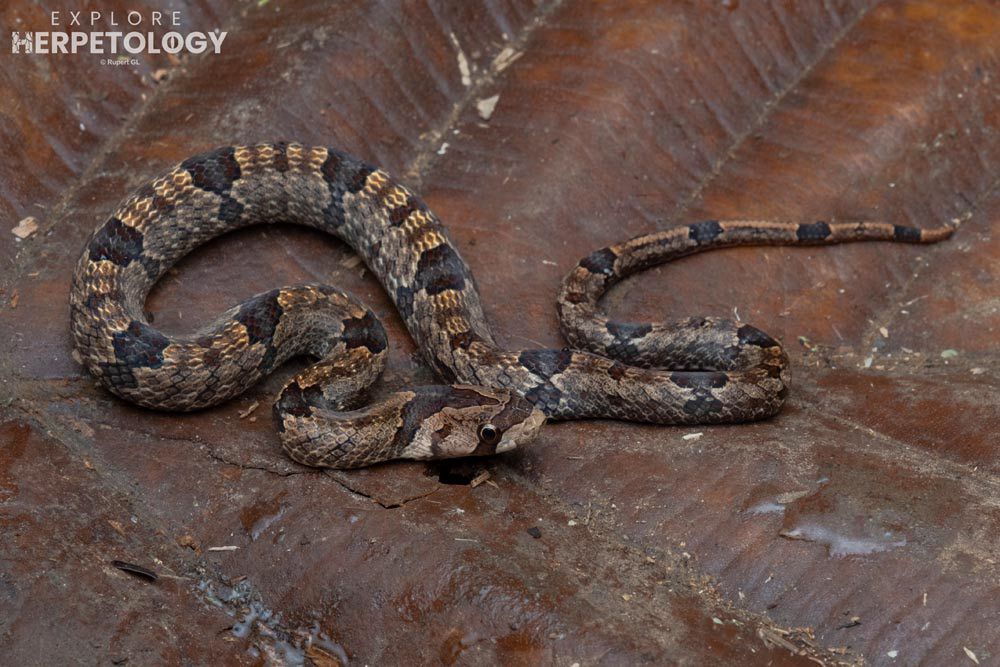
Juvenile Purple kukri snake (Oligodon purpurascens)
The next day, we went for an extremely sweaty daytime hike. No snakes were seen, but there were many gliding lizards (Draco sp.), sun skinks (Eutropis macularia and Eutropis multifasciata) and forest crested lizards (Calotes emma) around, as well as some Phuket day geckos (Cnemaspis phuketensis) which avoided capture. The best observation was our first and only Cambodian gliding gecko (Gekko tokehos) of the trip.
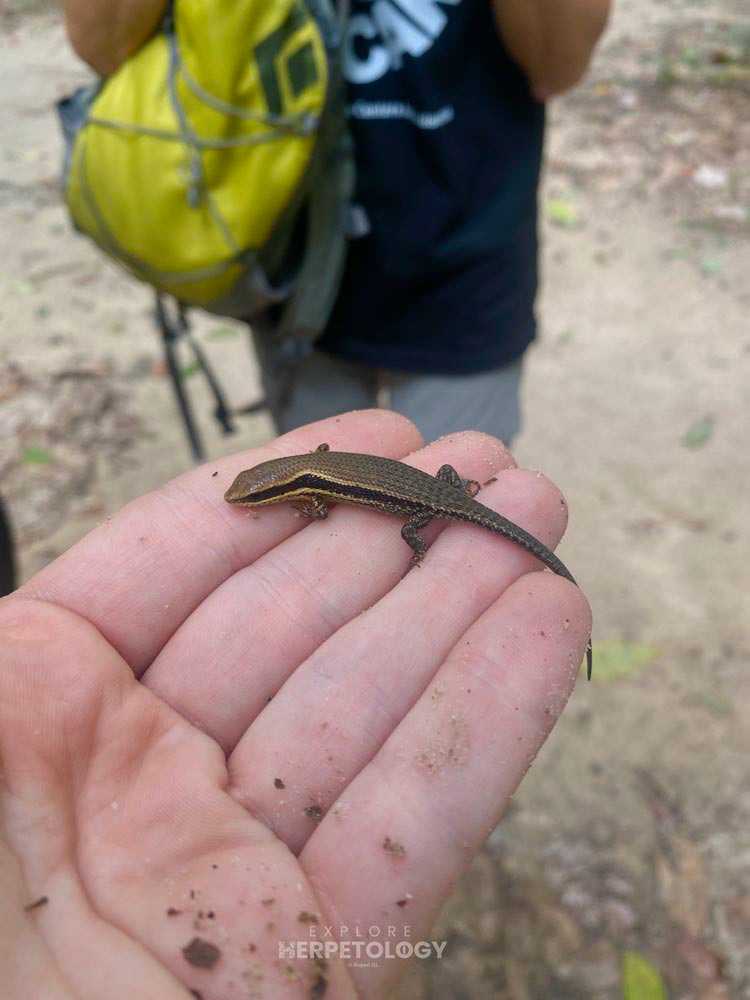
Eutropis macularia
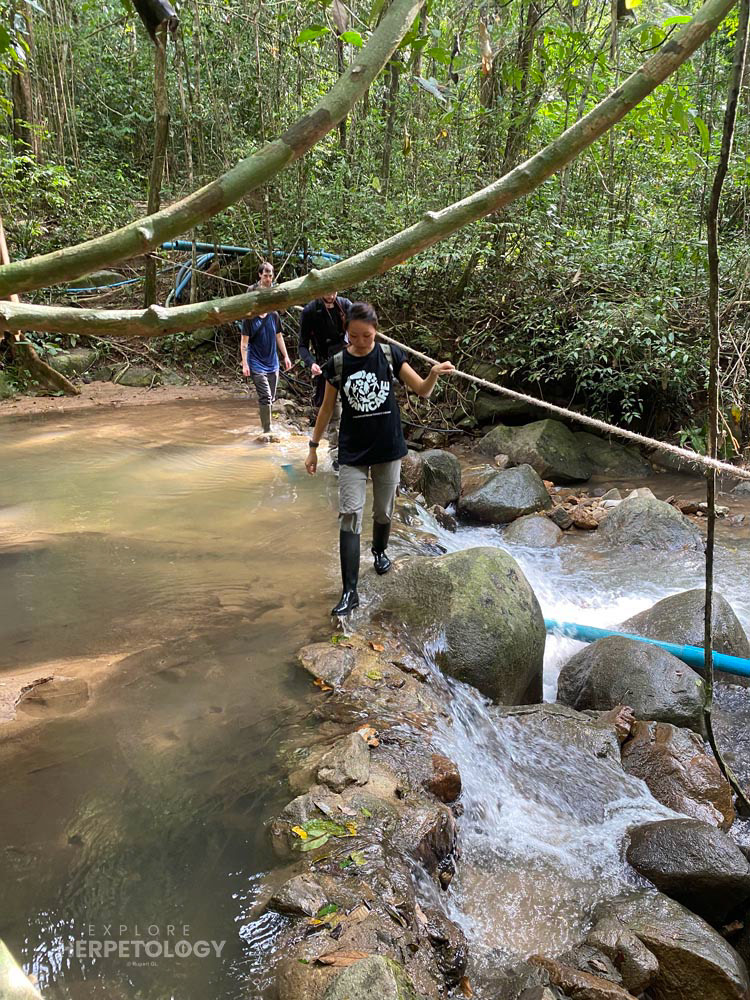
River crossing
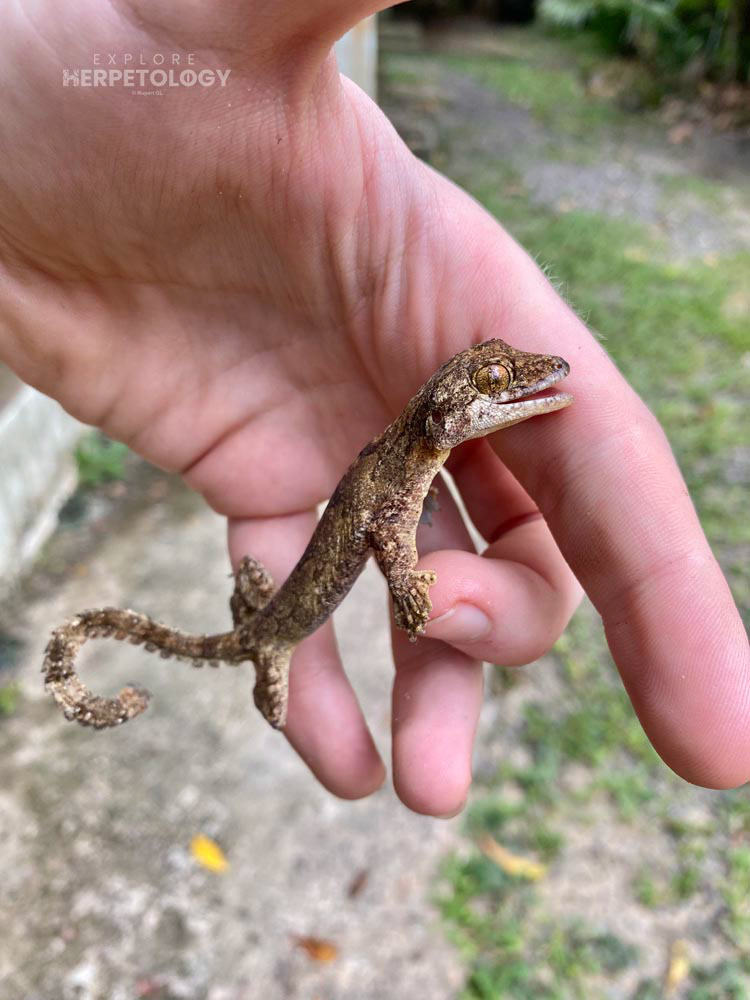
Cambodian gliding gecko (Gekko tokehos)
After dinner, we went to a forest area adjacent to where we walked on the first evening and quickly found a couple more Asian vine snakes (Ahaetulla prasina) and a new adult Wagler’s pit viper (Tropidolaemus wagleri) female high up a tree. The first snake within photography distance was a male Phuket pit viper (Trimeresurus phuketensis) which we left in-situ. Following this, we walked to a small temple where a large Wagler’s pit viper (Tropidolaemus wagleri) had been seen the previous day. She was not there anymore, but instead we were greeted by another unbelievable encounter - a male Phuket pit viper (Trimeresurus phuketensis) consuming a four-lined tree frog (Polypedates leucomystax) on the steps to the temple.
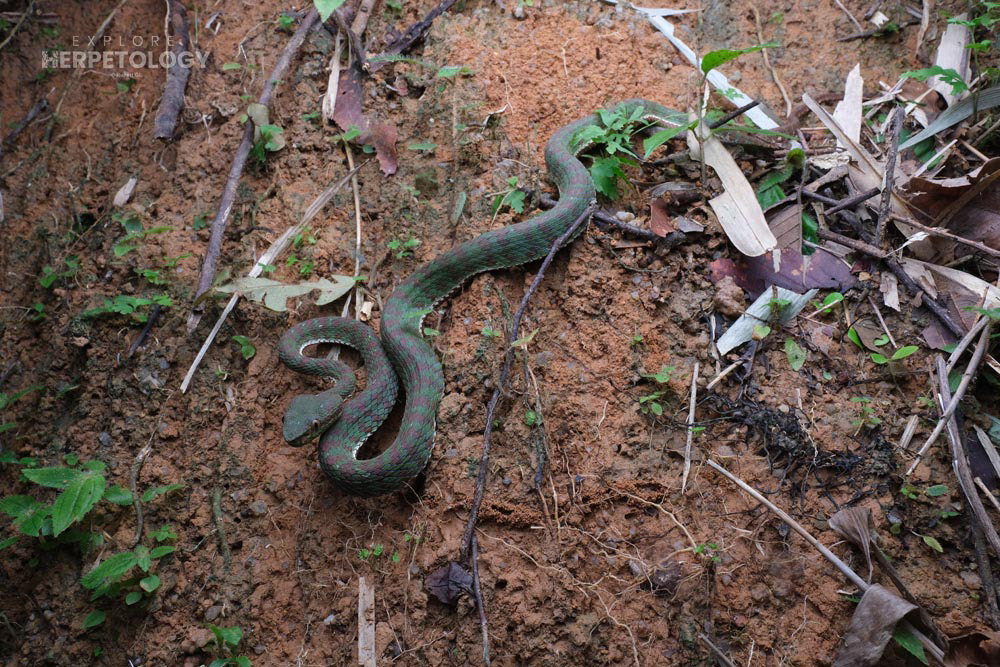
male Phuket pit viper (Trimeresurus phuketensis)
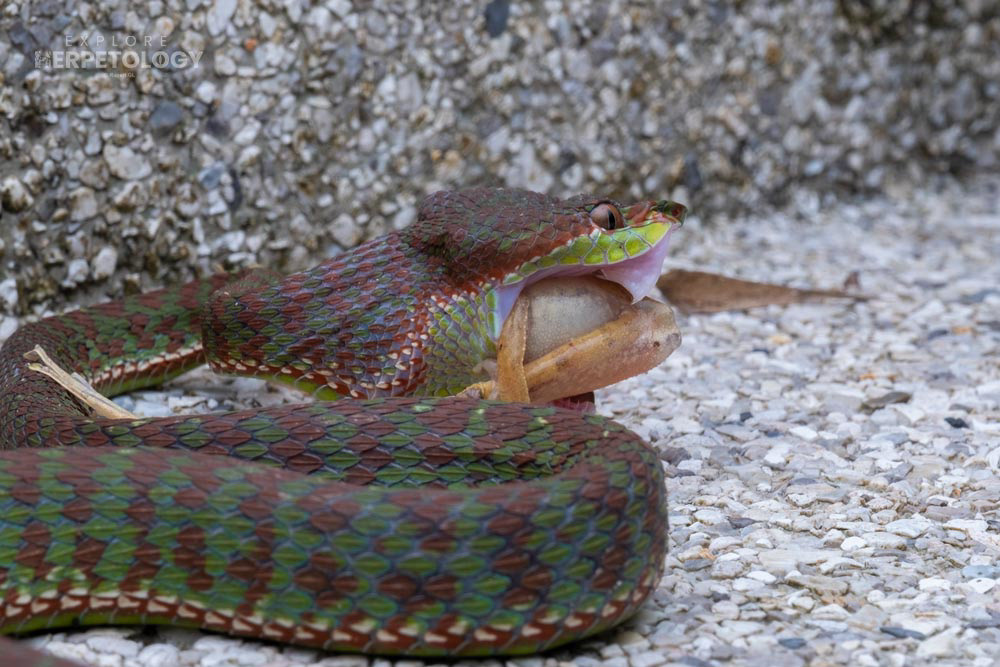
Phuket pit viper (Trimeresurus phuketensis) predating on a four-lined tree frog (Polypedates leucomystax)
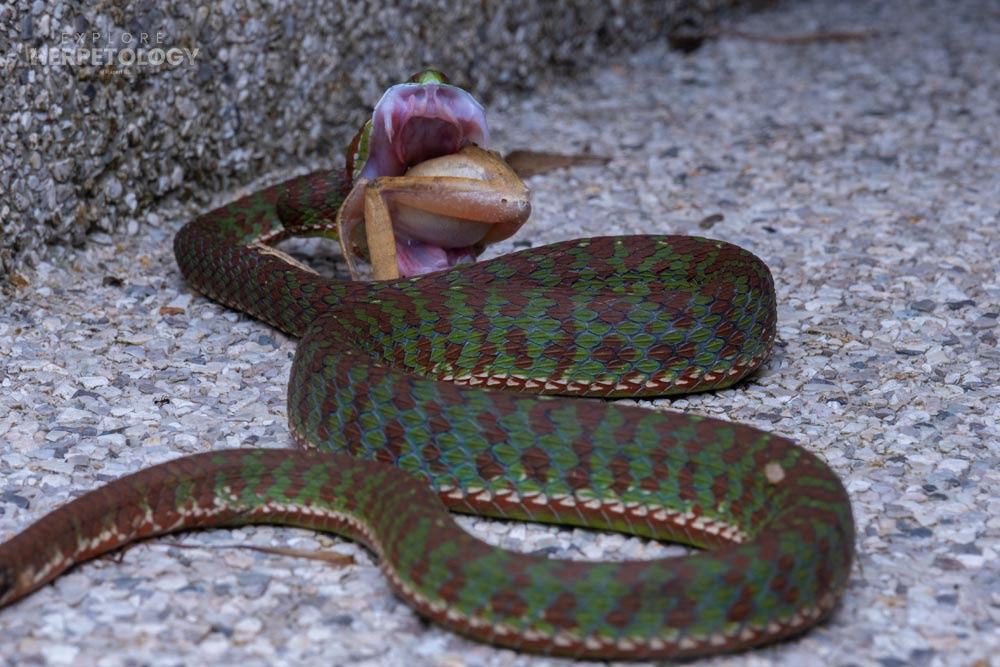
Phuket pit viper (Trimeresurus phuketensis) predating on a four-lined tree frog (Polypedates leucomystax)
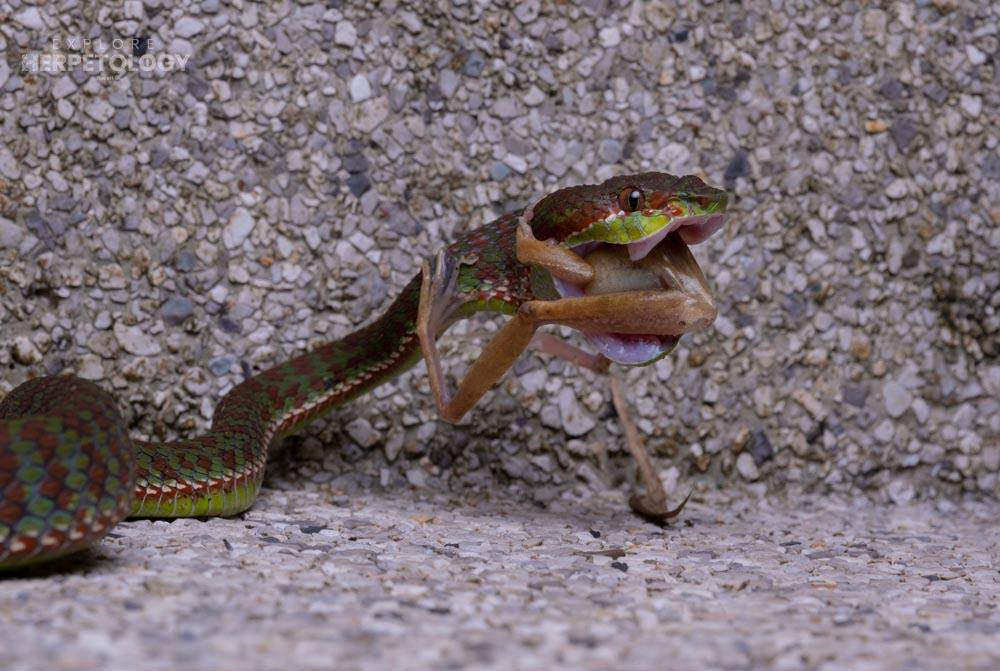
Phuket pit viper (Trimeresurus phuketensis) predating on a four-lined tree frog (Polypedates leucomystax)
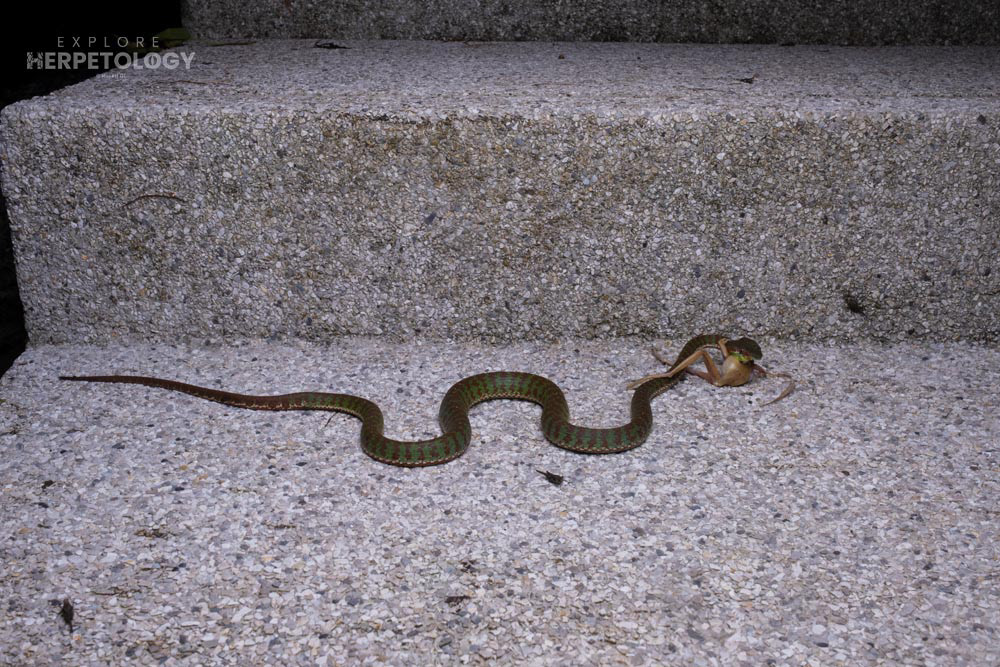
Phuket pit viper (Trimeresurus phuketensis) predating on a four-lined tree frog (Polypedates leucomystax)
We found a few more repeat species of snake, including our first male Wagler’s pit viper (Tropidolaemus wagleri), an adult mock viper (Psammodynastes pulverulentus), another juvenile white-bellied rat snake (Ptyas fusca) and one more male Phuket pit viper (Trimeresurus phuketensis).
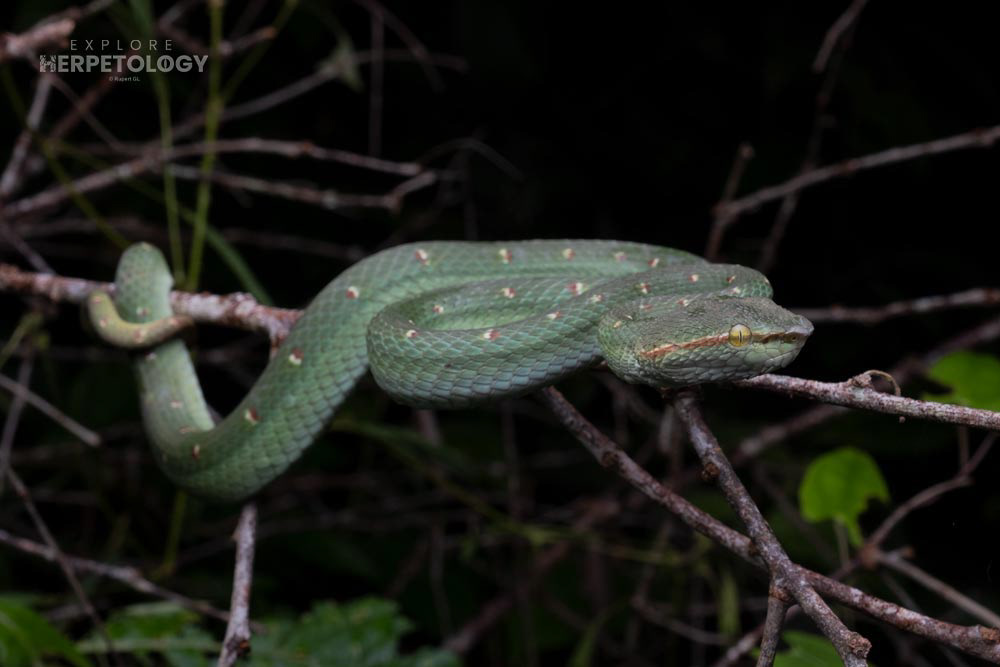
Male Wagler’s pit viper (Tropidolaemus wagleri)
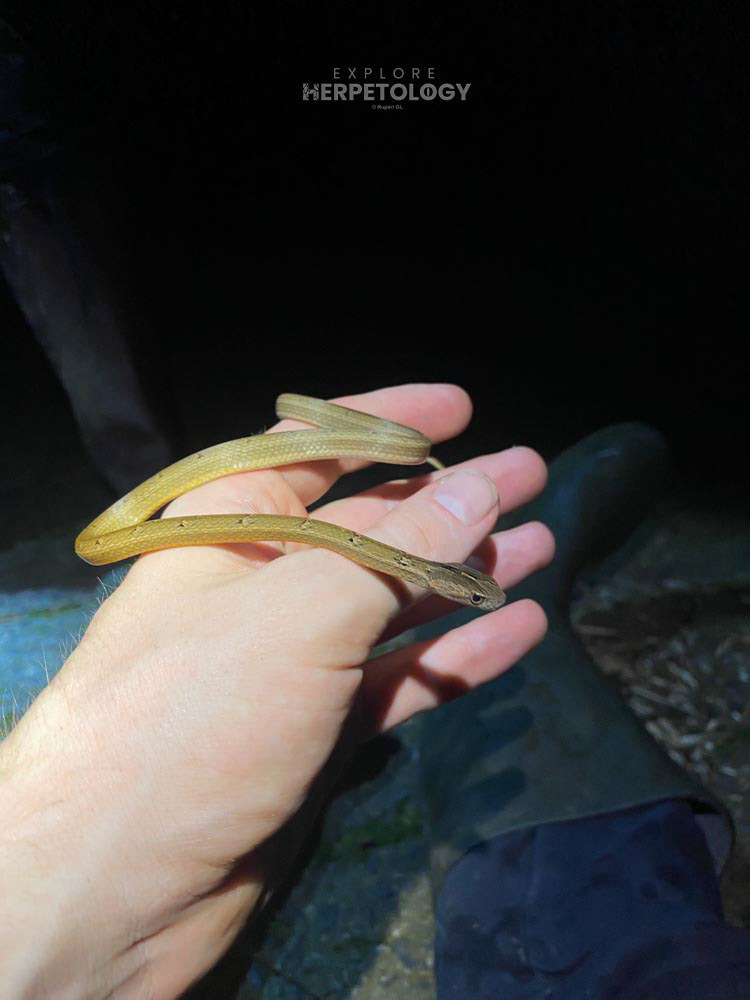
Mock viper (Psammodynastes pulverulentus)
The only new snake species for the night was a striped morph Malayan bridle snake (Lycodon subannulatus), although we did find a rare bent-toed gecko (Cyrtodactylus cf. brevipalmatus) - a first in the area for us.
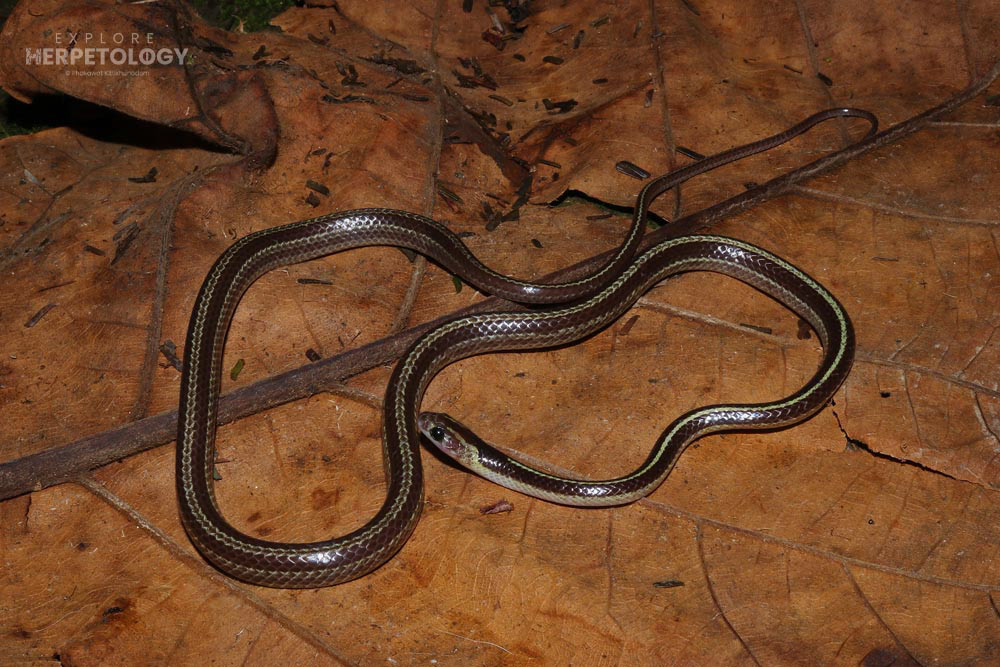
Malayan bridle snake (Lycodon subannulatus)
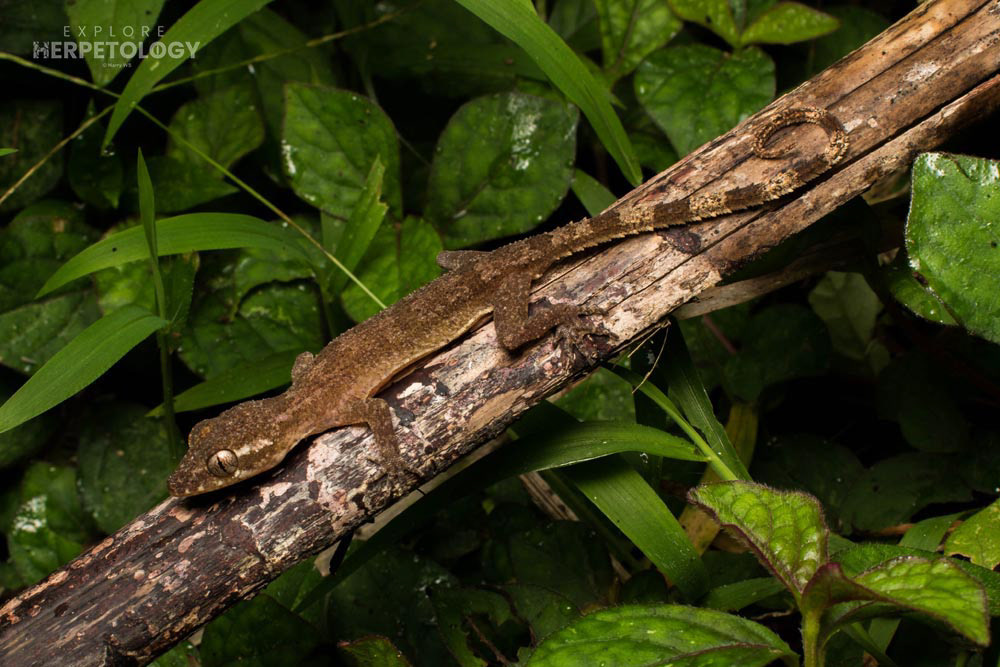
Cyrtodactylus cf. brevipalmatus
Although sad to leave the ever-productive Phuket, our next destination was packed with exciting plans, and we were welcomed by an Asian vine snake (Ahaetulla prasina) crossing the path as we arrived.
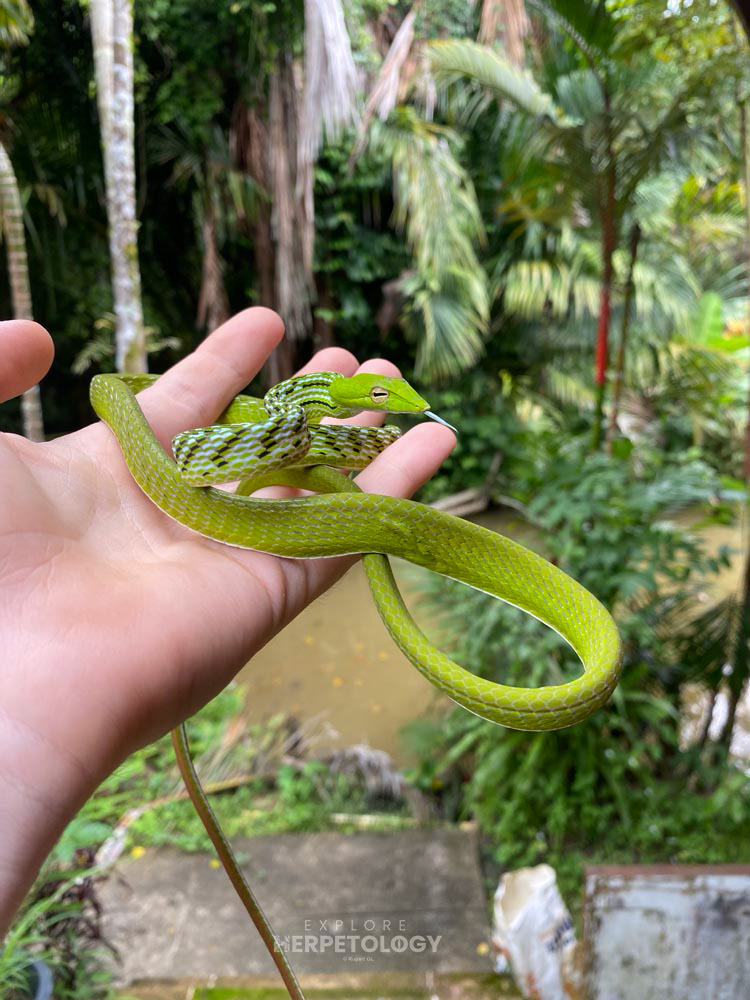
Asian vine snake (Ahaetulla prasina)
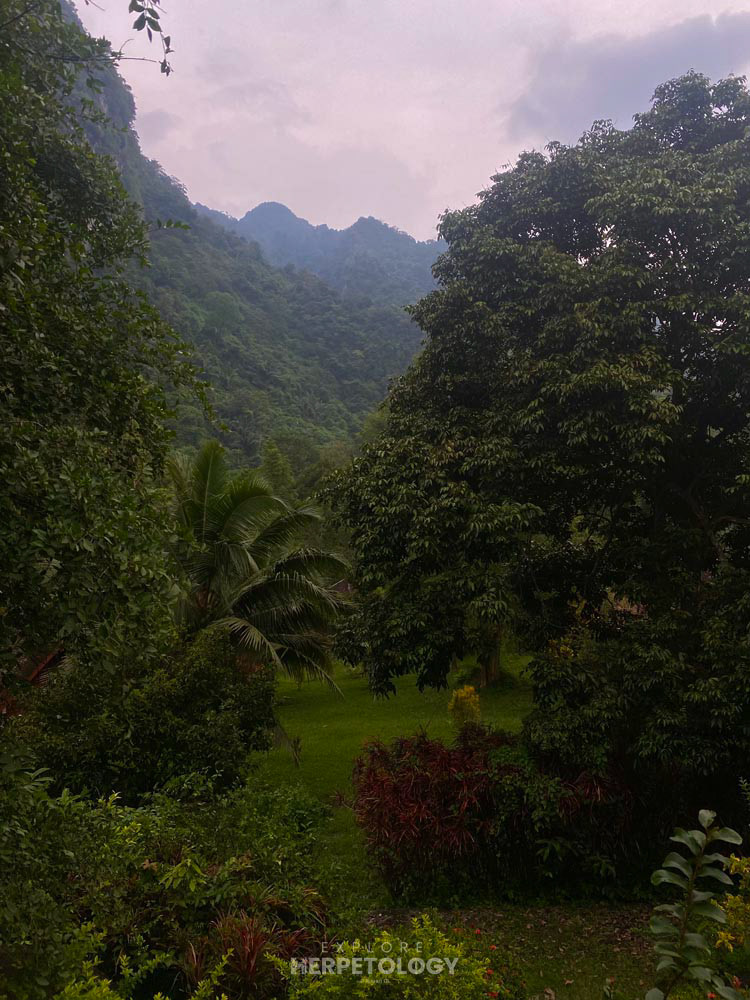
Home for the next 3 nights
The first snake found at nightfall was not one we expected, a huge Ridley’s cave racer (Elaphe taeniura), spotted sleeping in a tree by Christina. The next snake, an equally massive mangrove cat snake (Boiga melanota), was much more expected. Of course, more Asian vine snakes (Ahaetulla prasina) were spotted sleeping.
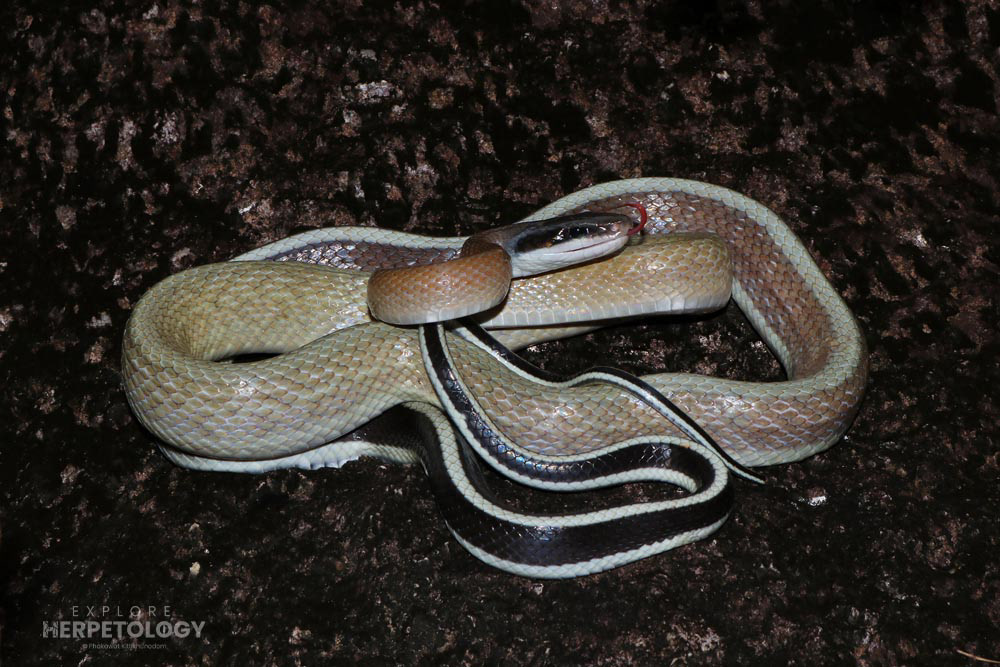
Ridley’s cave racer (Elaphe taeniura)
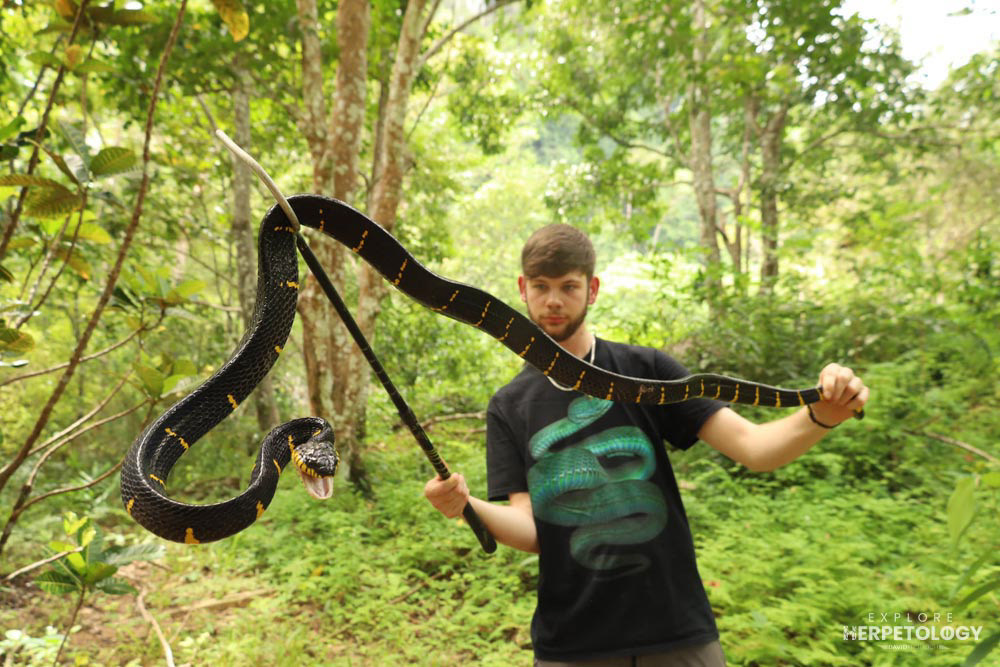
Aiden with the first Mangrove cat snake (Boiga melanota)
We changed location after these observations and instantly road cruised a big Malayan krait (Bungarus candidus). Upon arrival at our new spot, we quickly found two new geckos for the trip, a zebra-tailed bent-toed gecko (Cyrtodactylus zebraicus) and four-striped bent-toed geckos (Cyrtodactylus quadrivirgatus), as well as multiple individuals of the beautiful pit viper (Trimeresurus venustus) - our main target species in the area.
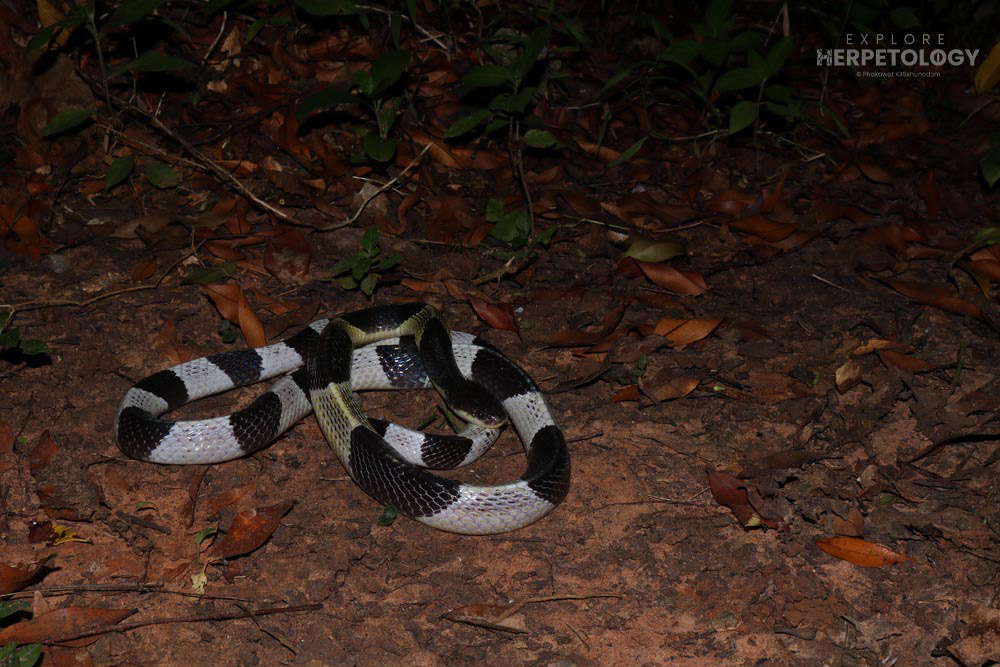
Malayan krait (Bungarus candidus)
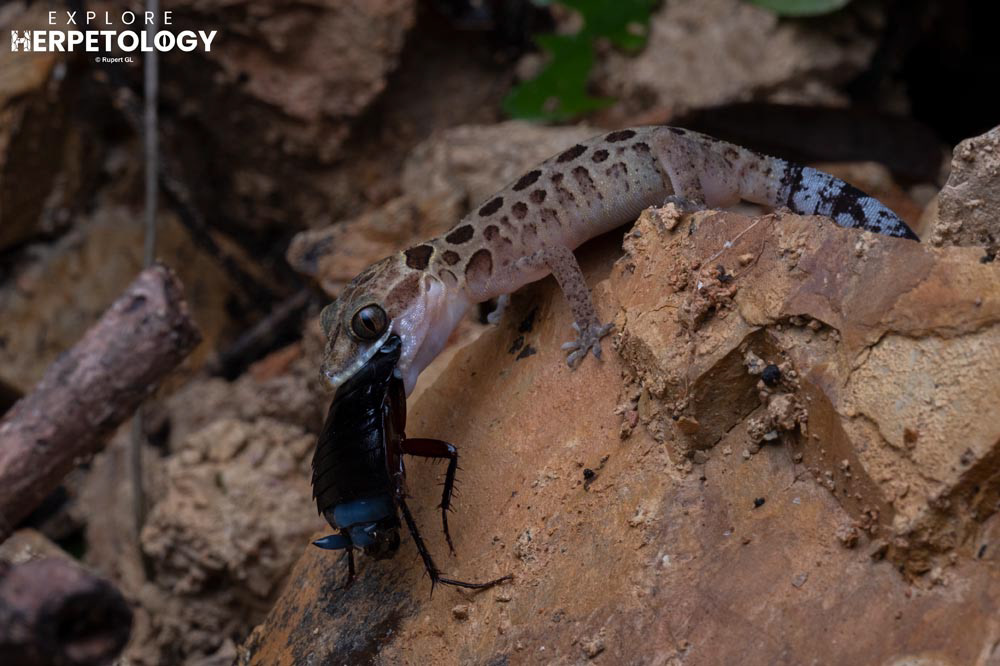
Zebra-tailed bent-toed gecko (Cyrtodactylus zebraicus)
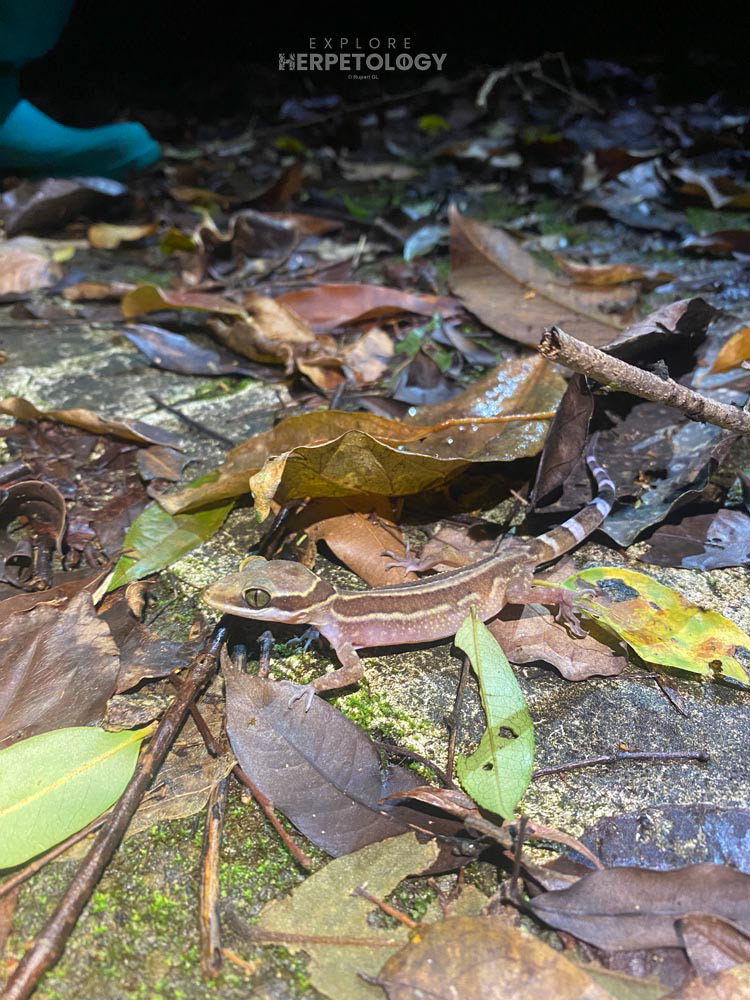
Four-striped bent-toed geckos (Cyrtodactylus quadrivirgatus)
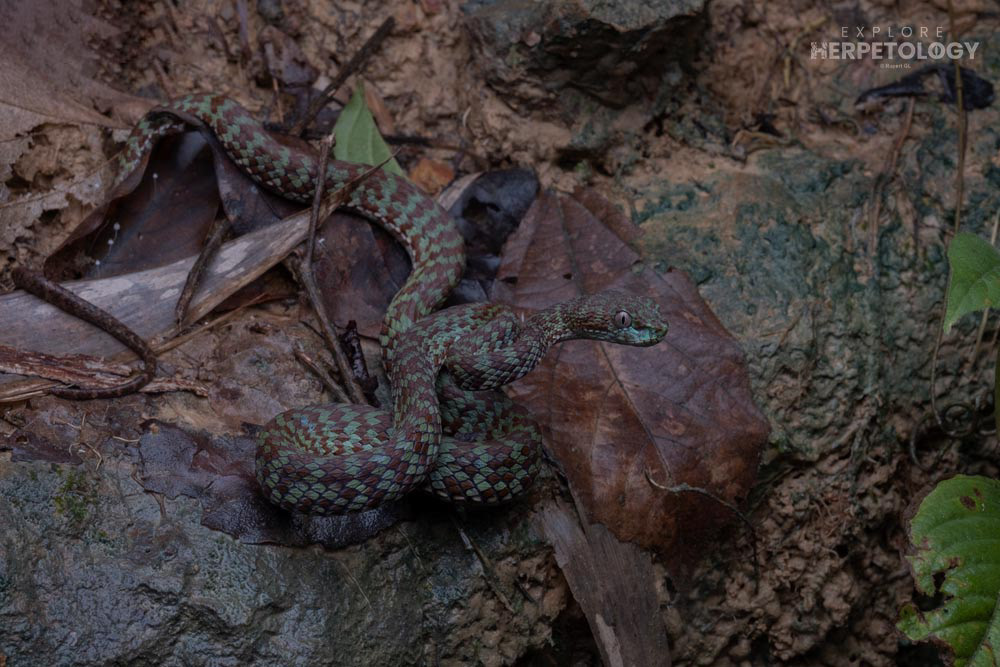
Beautiful pit viper (Trimeresurus venustus)
This walk was surprisingly productive for snakes and we ended up finding several more species, starting with a juvenile Laotian wolf snake (Lycodon laoensis), two painted bronzebacks (Dendrelaphis pictus), a mock viper (Psammodynastes pulverulentus) and lastly a sub-adult dog-toothed cat snake (Boiga cynodon).
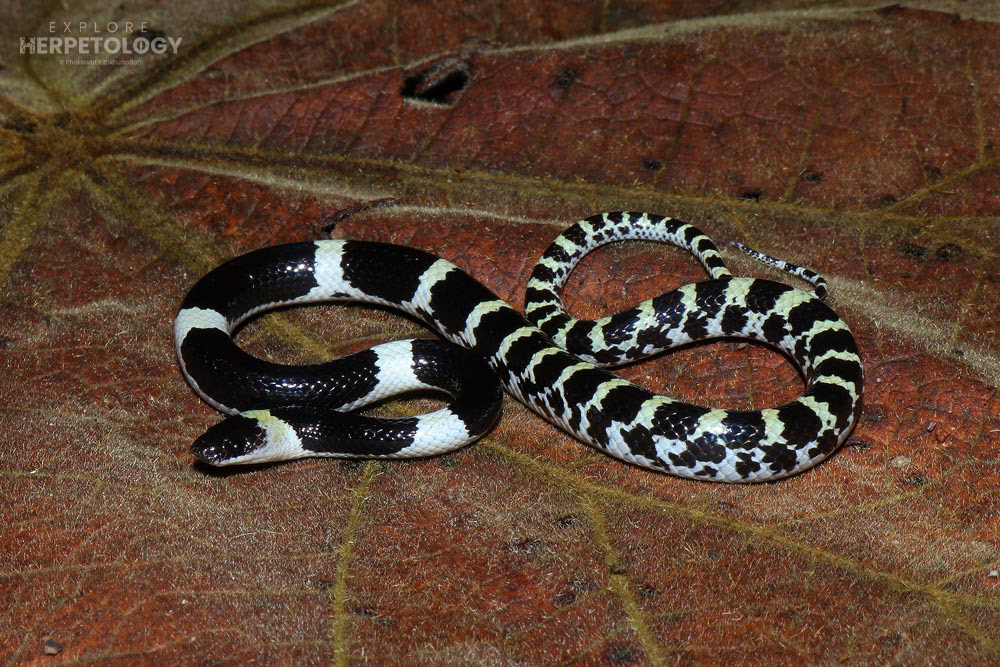
Laotian wolf snake (Lycodon laoensis)
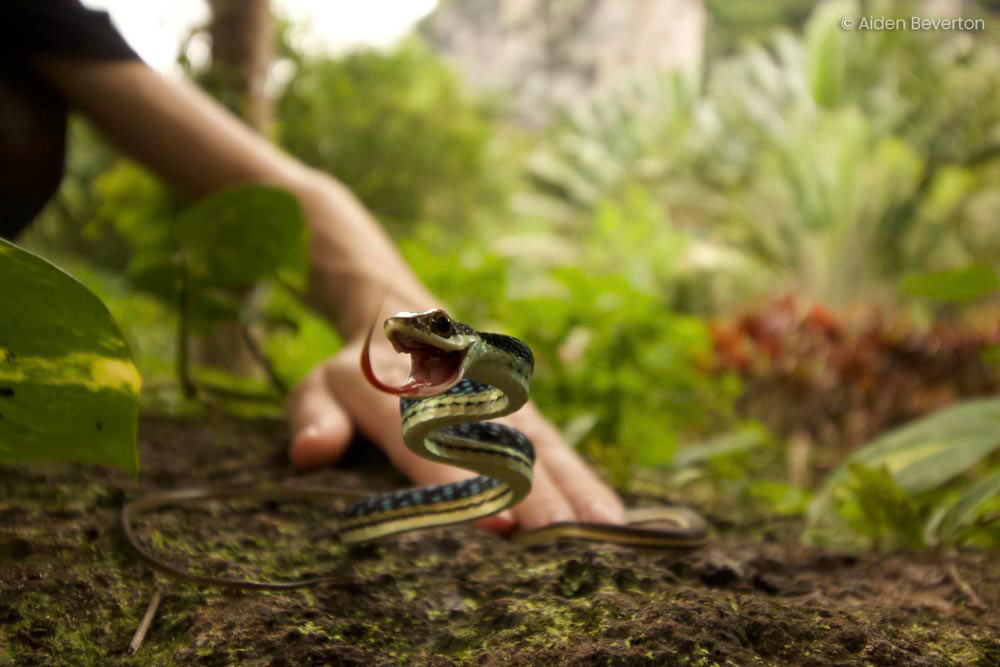
Painted bronzeback (Dendrelaphis pictus)
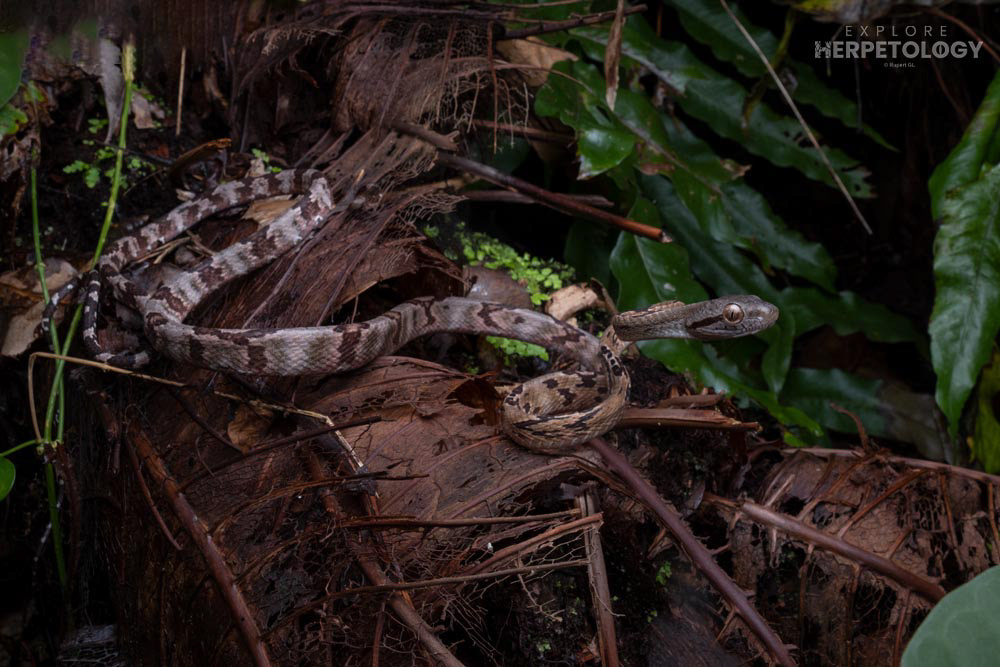
Dog-toothed cat snake (Boiga cynodon)
The fourth day of the trip got off to a great start when I caught an ornate flying snake (Chrysopelea ornata) while walking from my bungalow to the restaurant for breakfast.
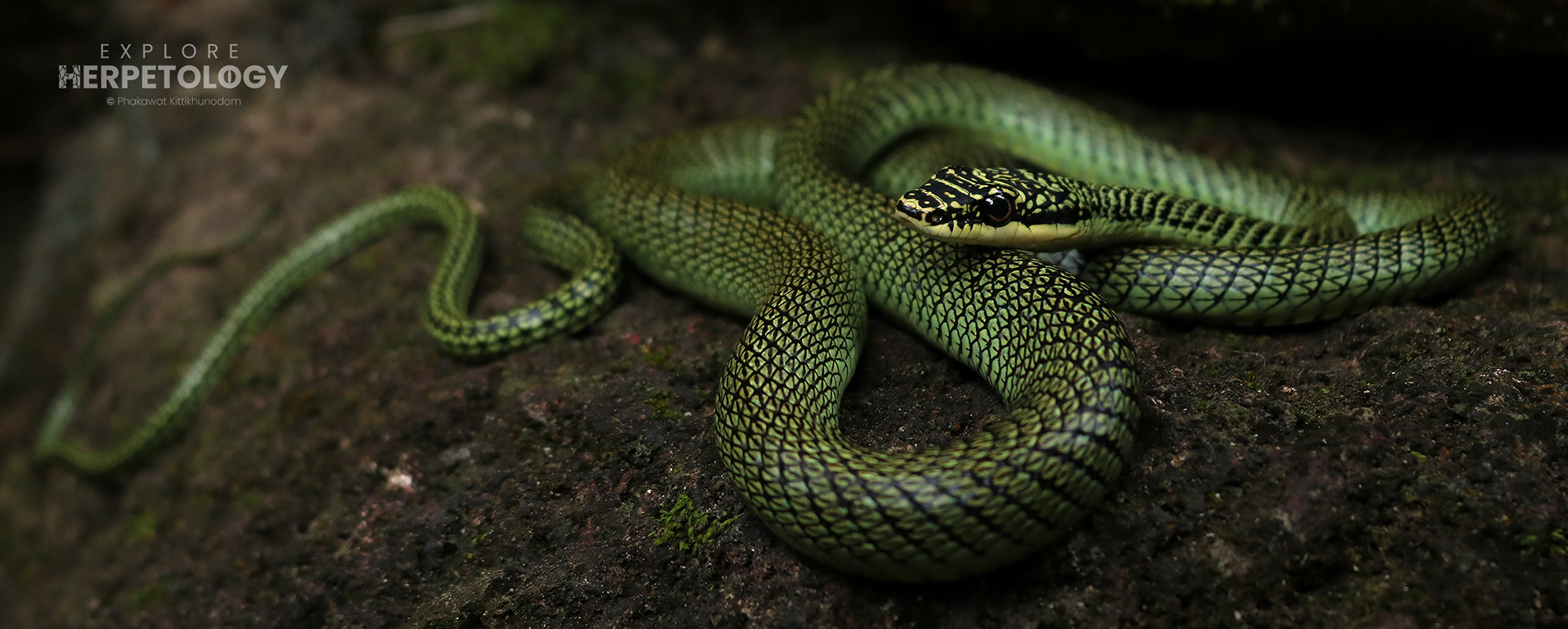
Ornate Flying Snake (Chrysopelea ornata)
For an afternoon walk, we ventured to a shaded limestone karst valley which I had seldom explored in the past. Amongst the rocks, we found a chanard’s rock gecko (Cnemaspis chanardi) and a clouded monitor (Varanus nebulosus), but disaster struck when torrential rain caused us to seek cover. While looking for a good place to hide, I stumbled across possibly the most unexpected herp of the trip, an elongated tortoise (Indotestudo elongata).

Chanard’s rock gecko (Cnemaspis chanardi)
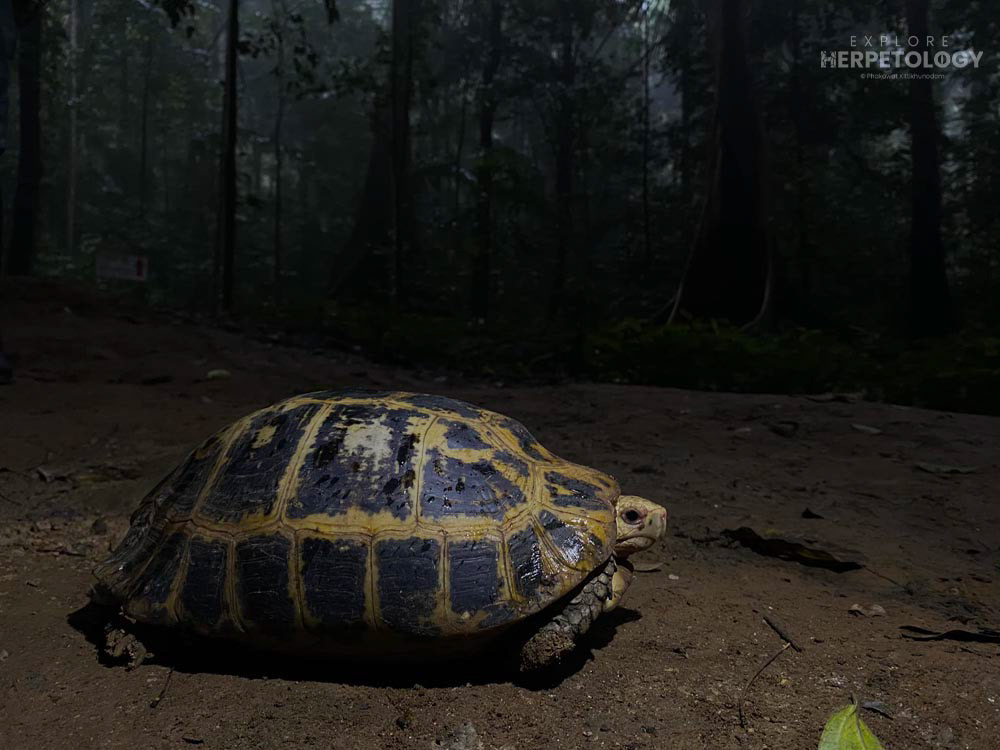
Elongated tortoise (Indotestudo elongata)
After an intense first few days, there were a lot of tired people in the group and we were up super early the next day, so we did a much shorter night walk. We encountered 5 new beautiful pit viper (Trimeresurus venustus) individuals and a few repeat species from the previous evening.
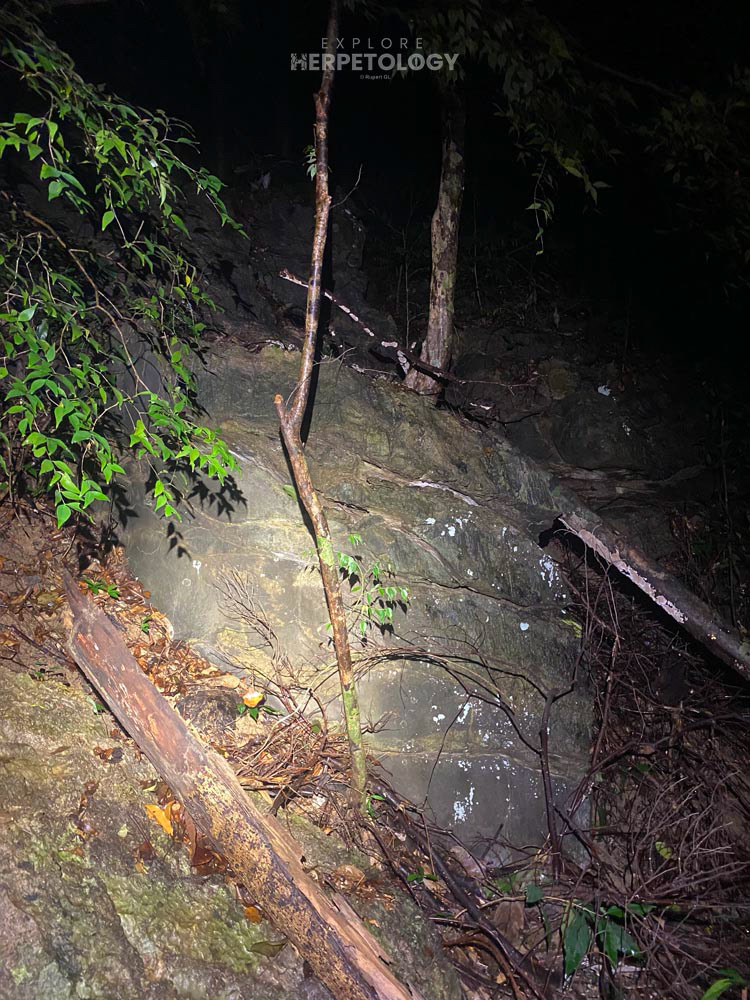
Beautiful pit viper (Trimeresurus venustus)
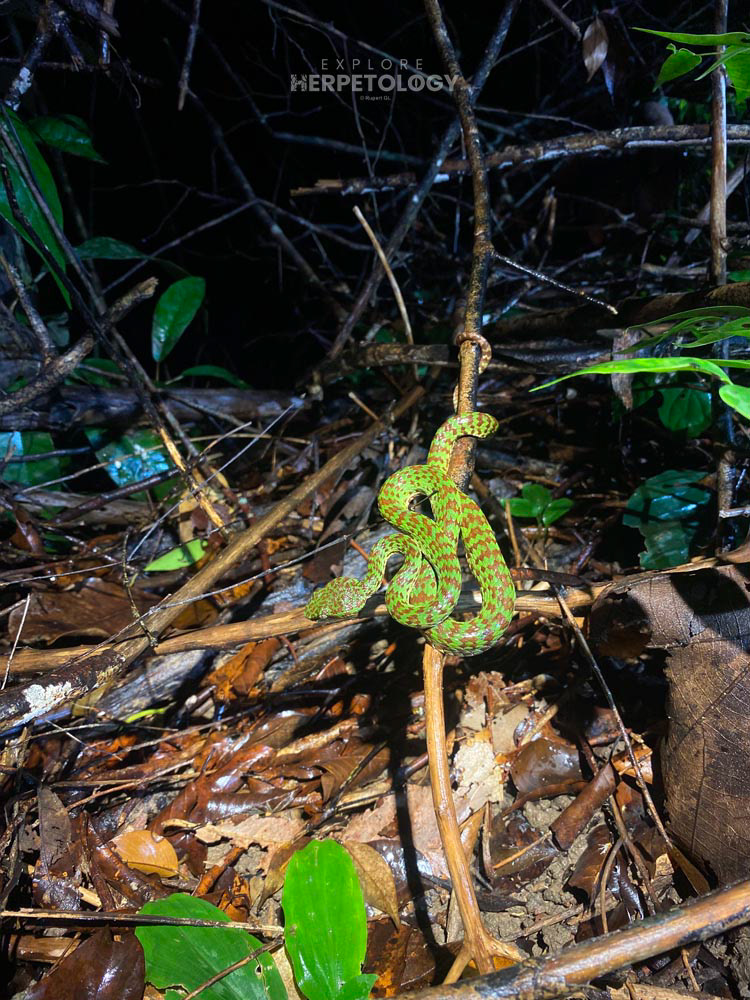
Beautiful pit viper (Trimeresurus venustus) in-situ
For our last full day in Krabi, we were awake at 7am to drive to the pier where we were getting a boat from. The boat took us through the mangroves in search of our next big target, the mangrove pit viper (Trimeresurus purpureomaculatus). Eventually, we found an adult individual stretched on some roots above the water, and Harry also caught a Schneider's bockadam (Cerberus schneiderii) which came up for air in a small pool.
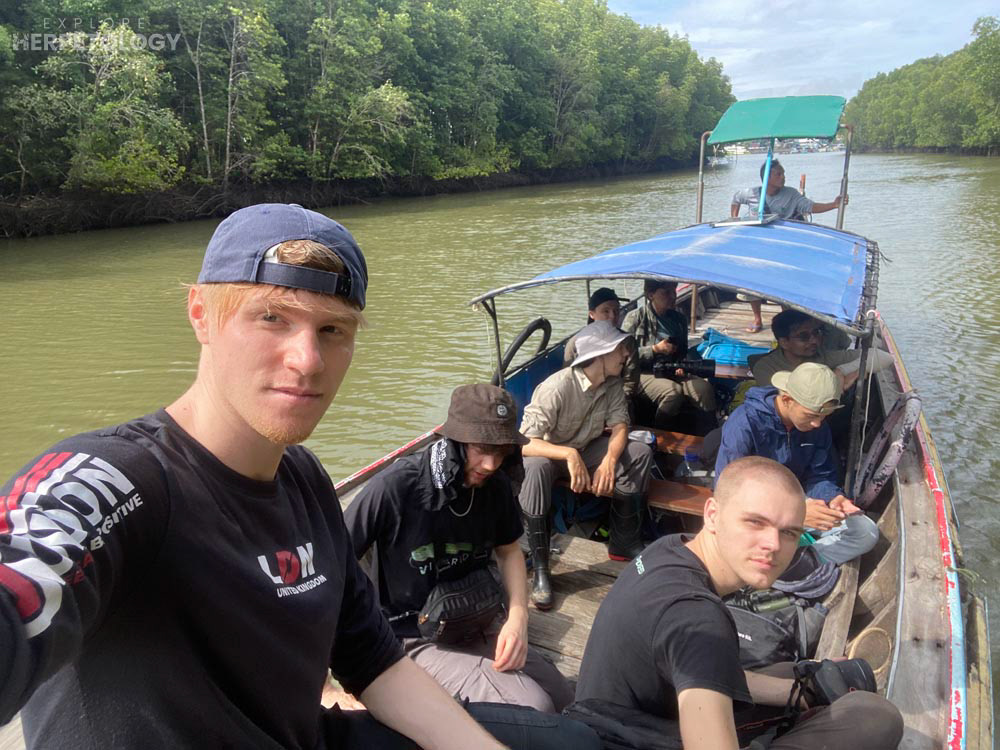
I'm on a boat m...
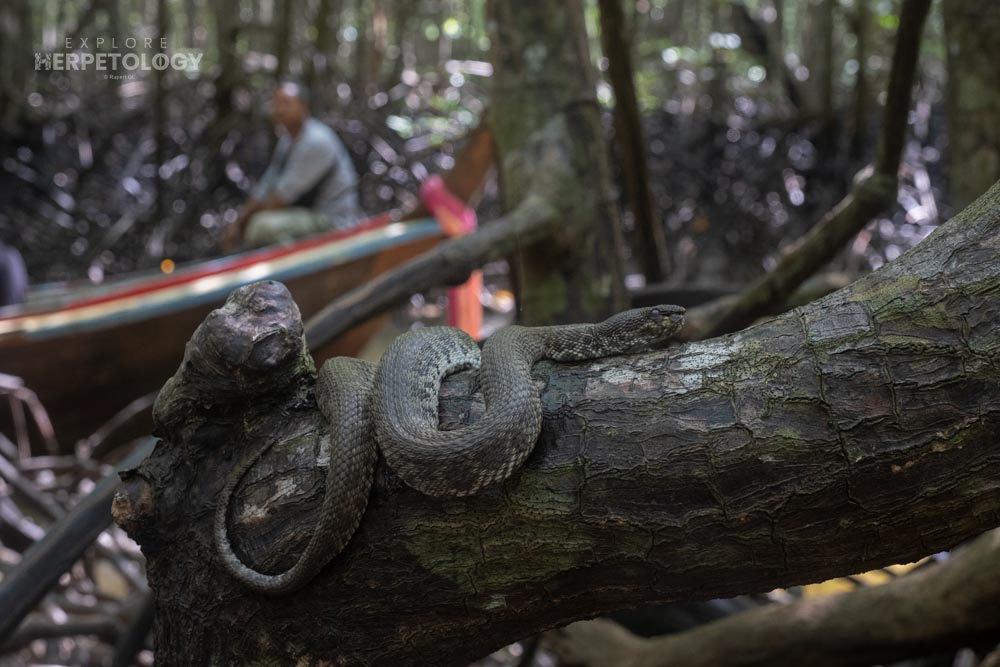
Mangrove pit viper (Trimeresurus purpureomaculatus)
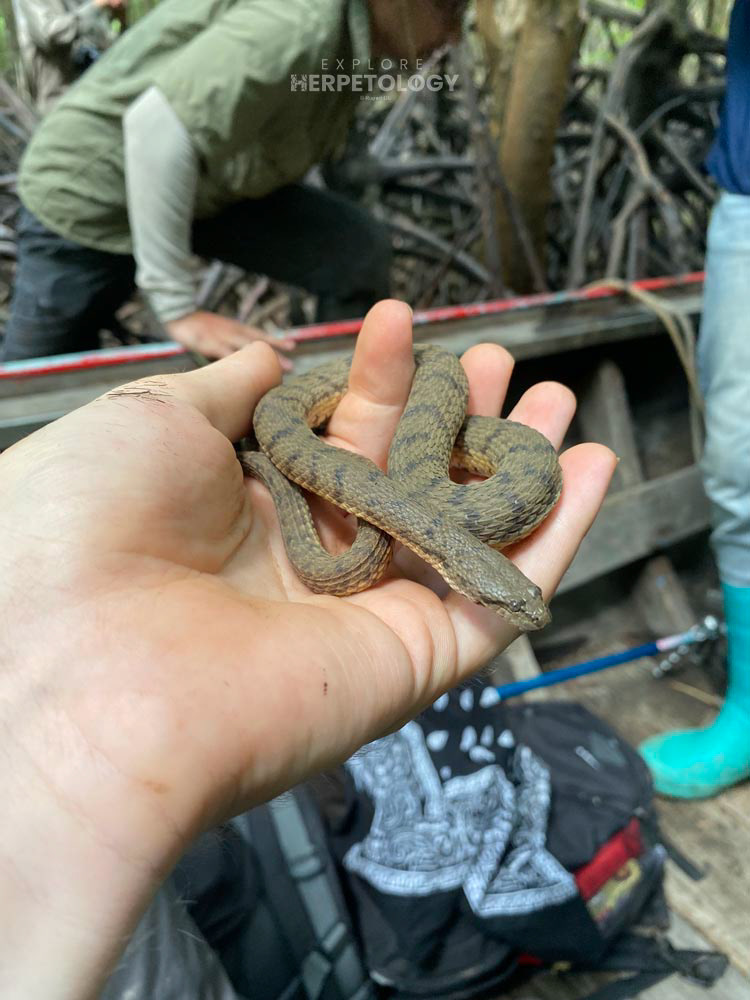
Schneider's bockadam (Cerberus schneiderii)
Things got even better on the drive back to our accommodation when we road-cruised an awesome monocled cobra (Naja kaouthia) around midday. Cobras are extremely secretive snakes which are very rarely found while herping, so this was a fantastic surprise encounter.
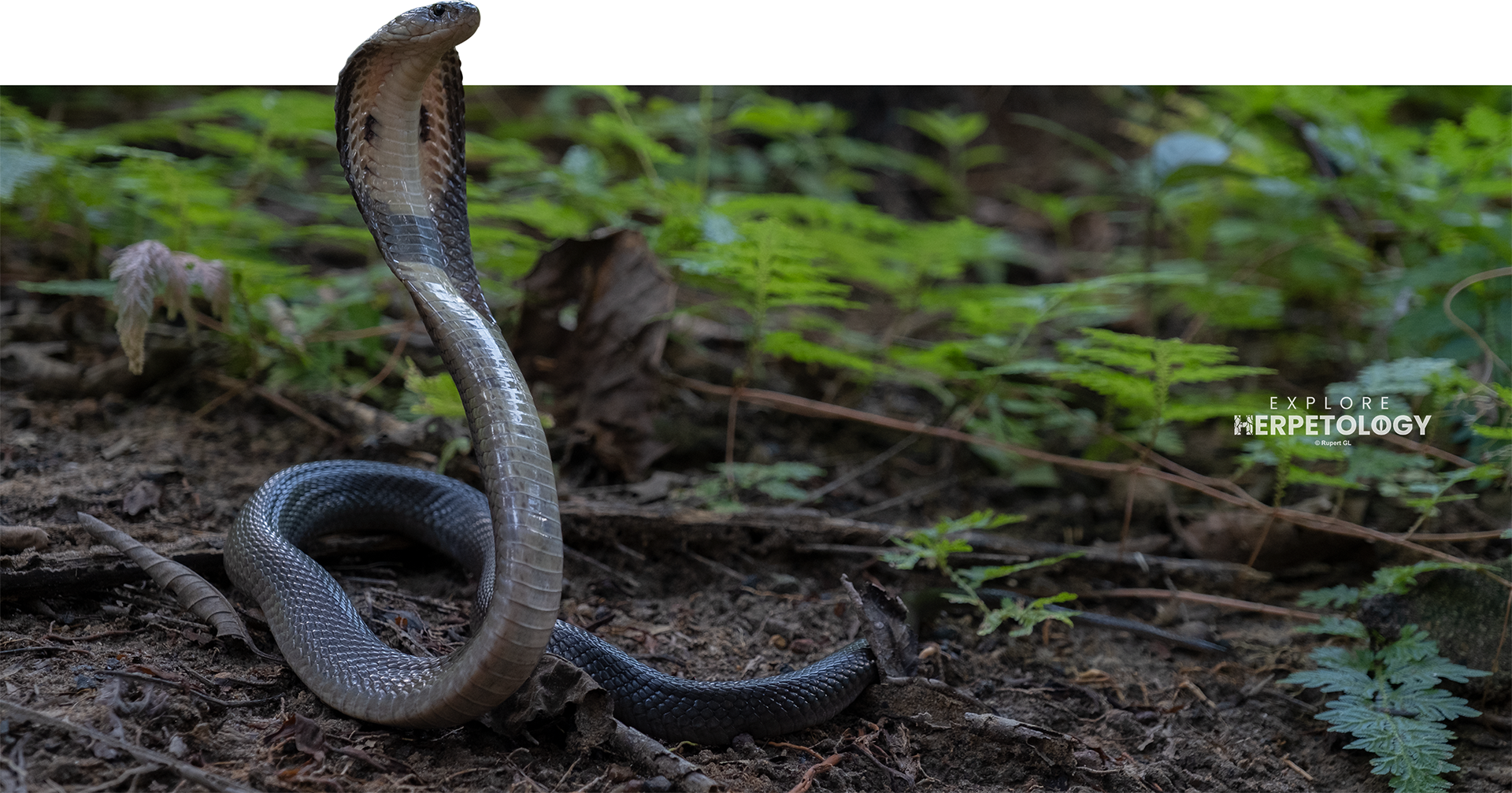
Monocled cobra (Naja kaouthia)
We returned to our resort for another surprise, as the owner had just caught a big reticulated python (Malayopython reticulatus) on a rescue call in the local village and brought it to us.
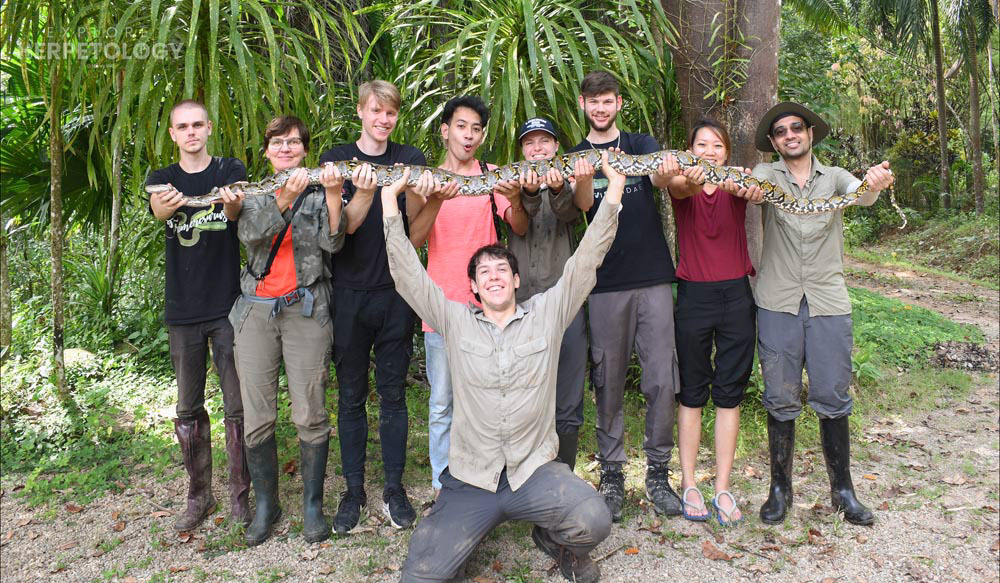
Reticulated python (Malayopython reticulatus)
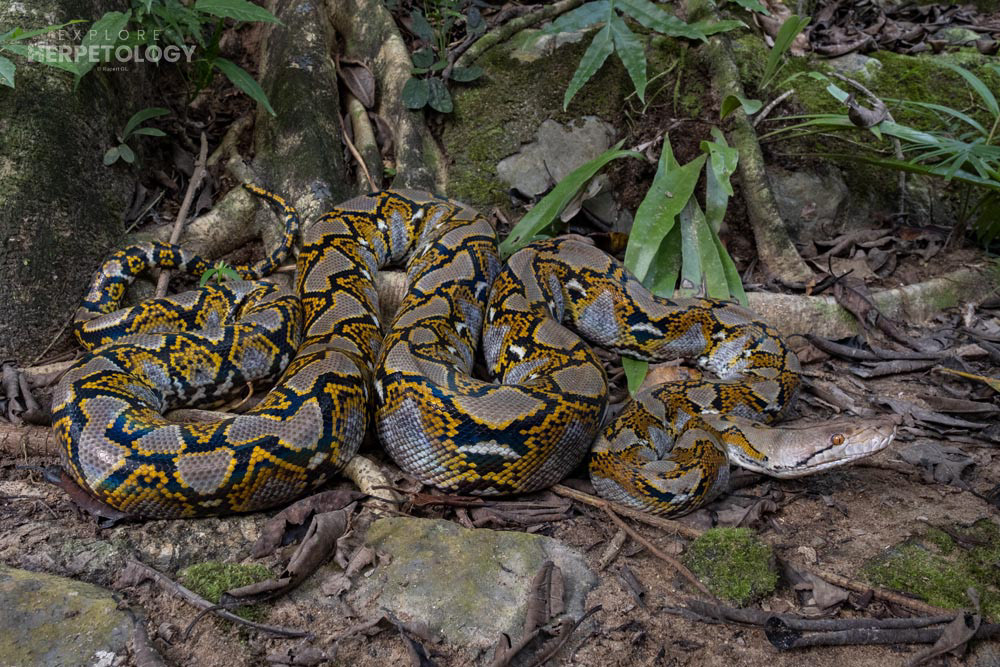
Reticulated python (Malayopython reticulatus)
This was our scheduled ‘evening off’ to give people a chance to rest while having drinks and getting to know each other better. However, those who stayed up late could not resist going for a quick walk around our resort. We only found one snake but it was yet another unbelievable encounter, an aberrant ‘spotted’ morph mangrove cat snake (Boiga melanota) - something we are unlikely to ever see again.
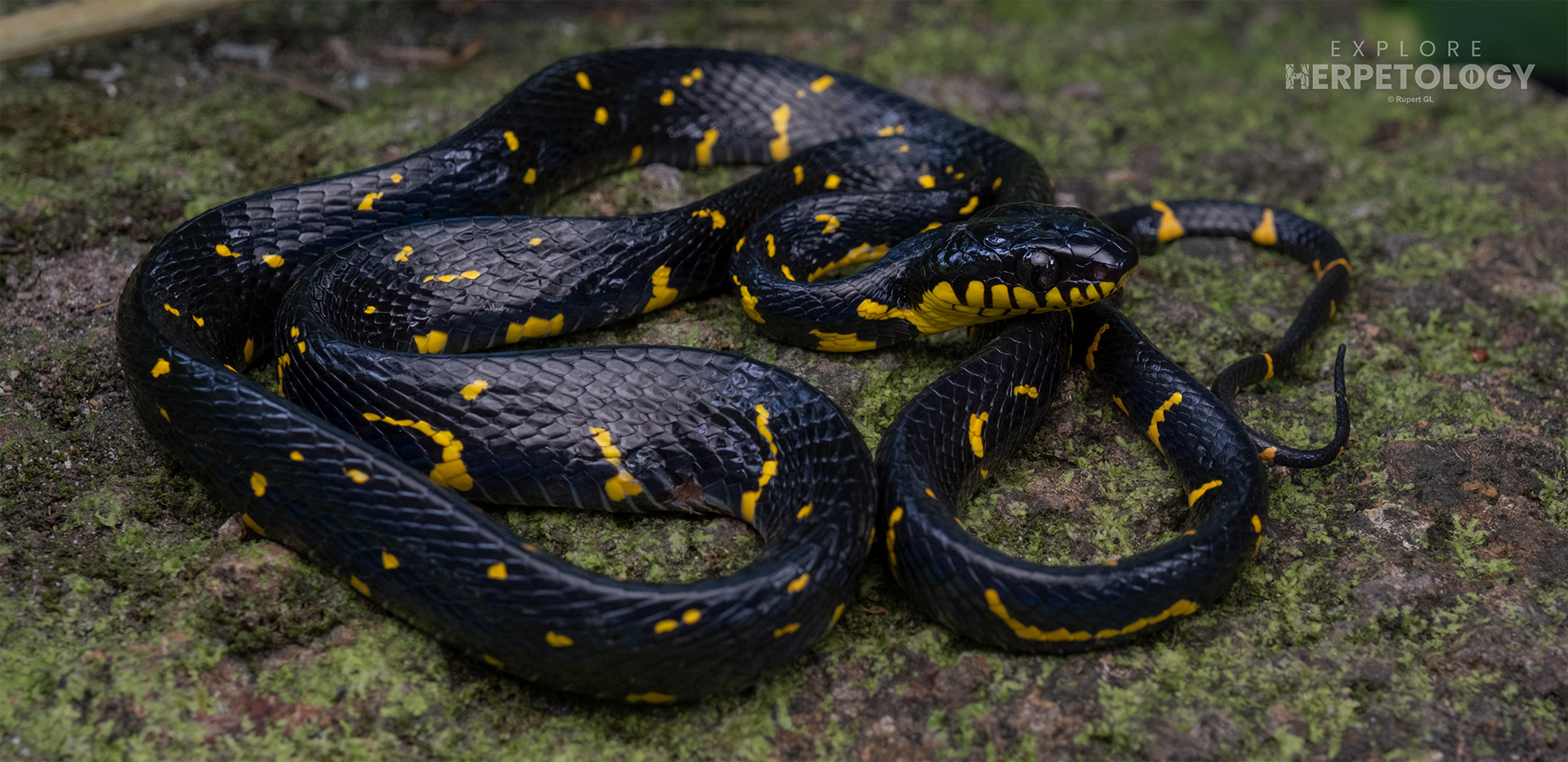
Aberrant ‘spotted’ morph Mangrove cat snake (Boiga melanota)
After these exciting three days in Krabi, we made the short drive south to Trang province, where we would be spending the following 2 nights and target 3 different species of viper. On the drive over, we saw a large radiated rat snake (Coelognathus radiatus) crossing the road.
The first snake we found was our first target viper, a small Malayan pit viper (Calloselasma rhodostoma). Trang is undoubtedly the best place in Thailand to observe this species, although we only saw 2 individuals that night. Another common species in the area is the Malayan vine snake (Ahaetulla mycterizans), of which we observed several while they rested.
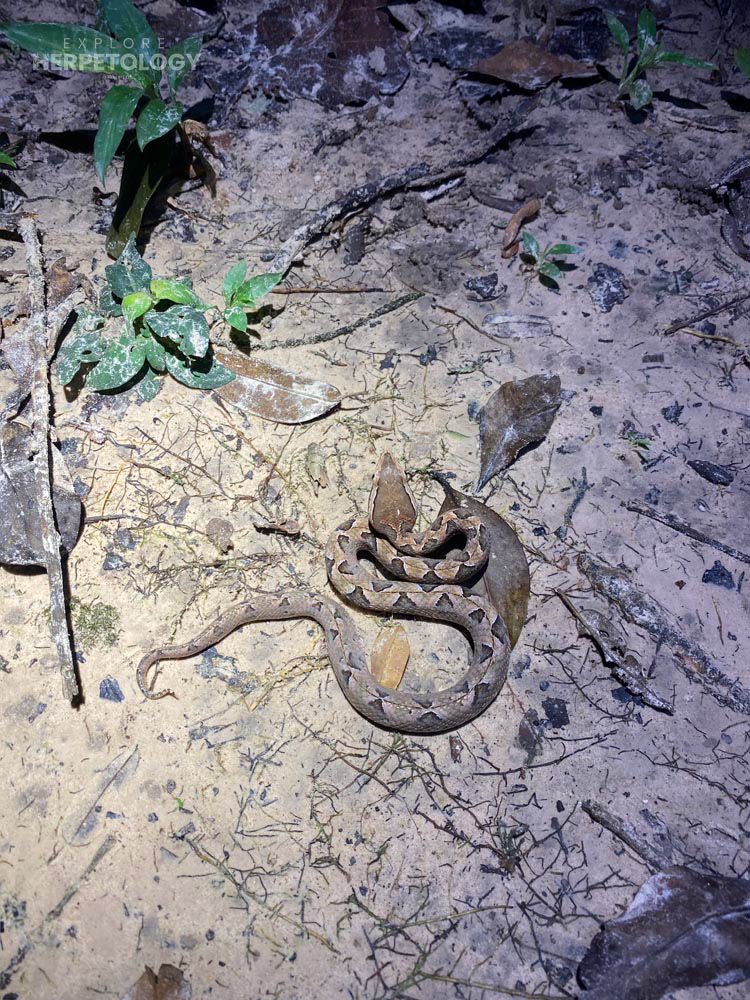
Malayan pit viper (Calloselasma rhodostoma)
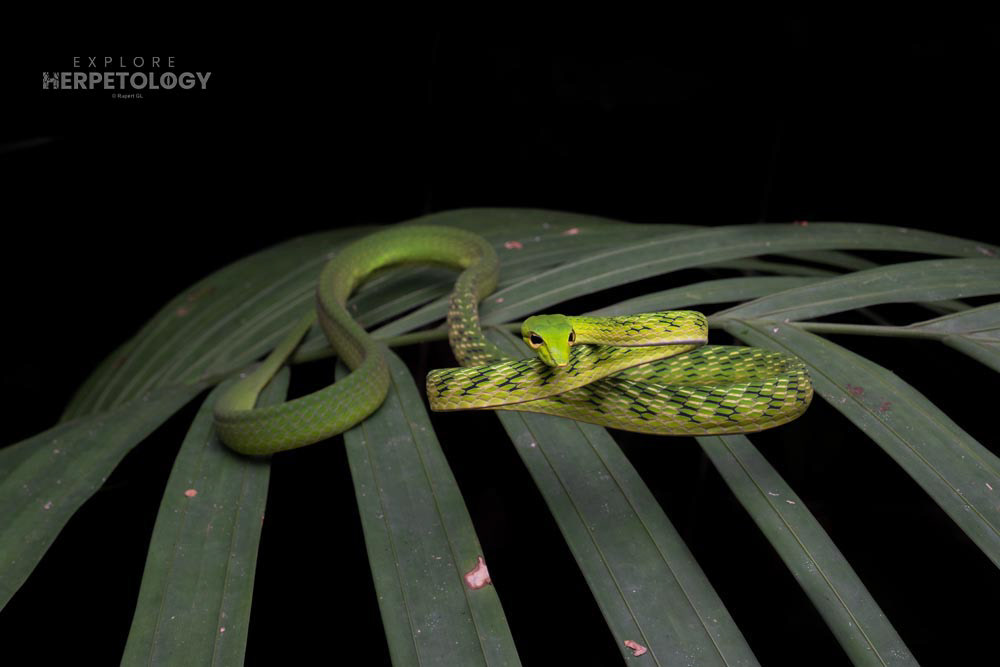
Malayan vine snake (Ahaetulla mycterizans)
Following on from this, we found a mangrove cat snake (Boiga melanota) and another 2 new species of snake for the trip, starting with a juvenile female of the southern form white-lipped pit viper (Trimeresurus cf. albolabris). This complex is primarily distributed in more central/northern parts of Thailand, but there are isolated populations concentrated in Trang and surrounding areas which we always try to target when in their range. The second new species was a Siamese red-necked keelback (Rhabdophis siamensis) which David spotted sleeping on some low vegetation, another cool species which one can easily miss while herping in the south.
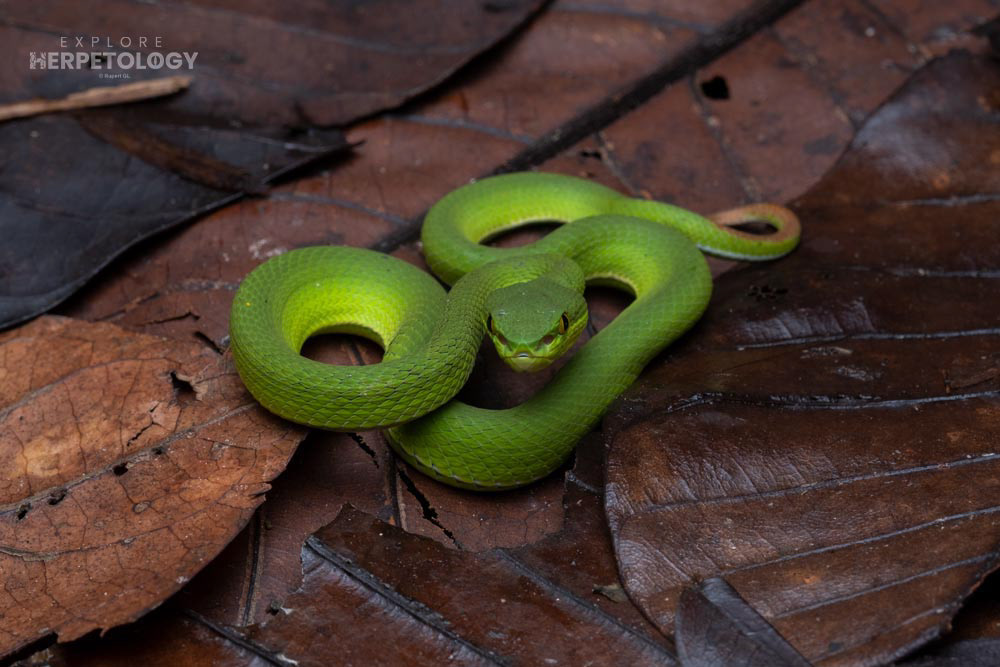
White-lipped pit viper (Trimeresurus cf. albolabris)
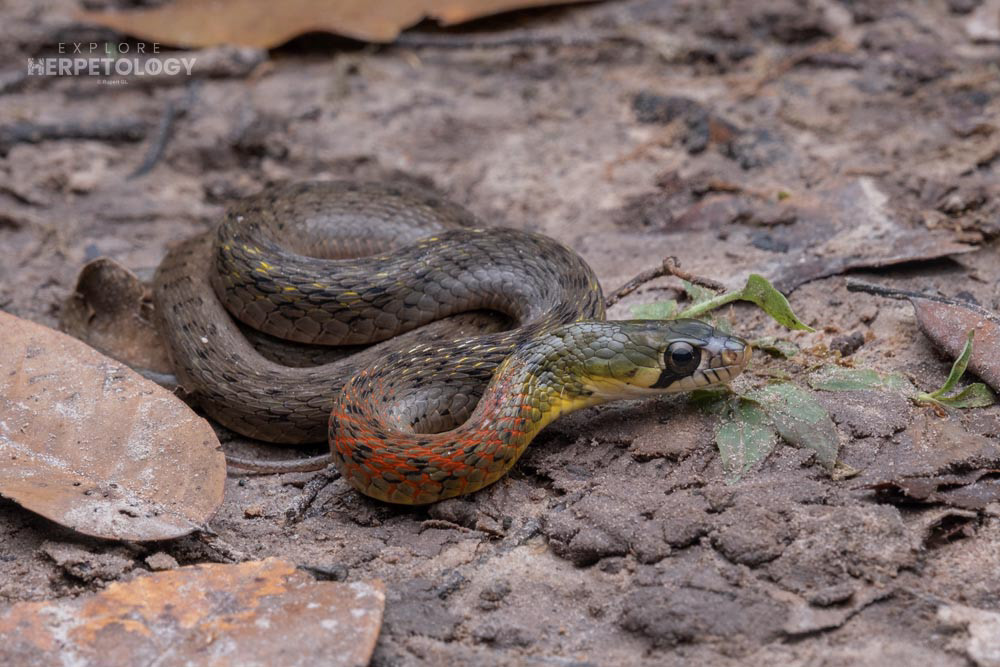
Siamese red-necked keelback (Rhabdophis siamensis)
For the second night in Trang, we ventured into mature tropical rainforest in the Khao Banthad mountain range for an exciting evening of herping. Snakes were difficult to come by, as is often the case in such good habitat, but we ended up with several impressive species.
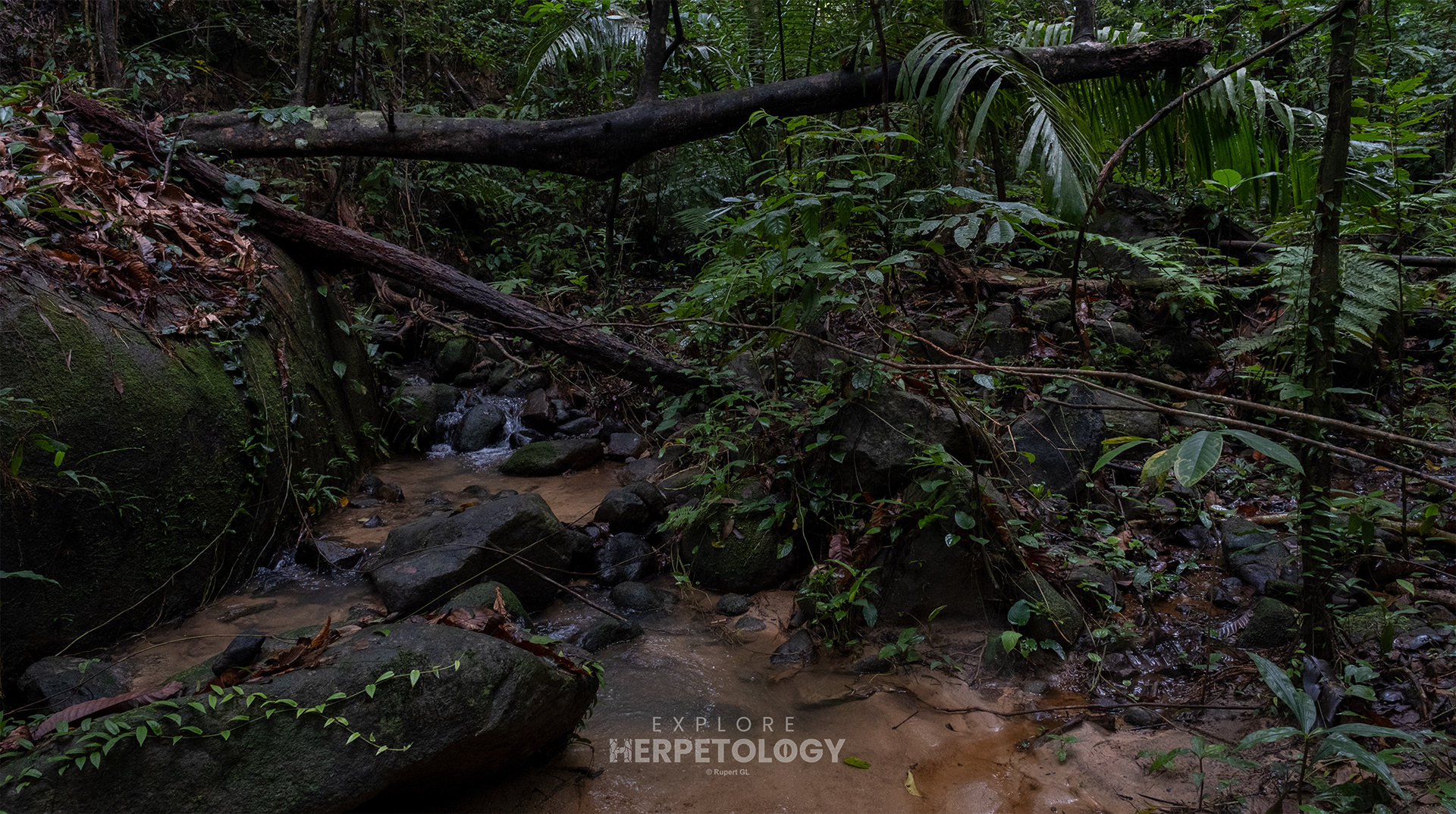
We found our first Bengkulu cat snakes (Boiga bengkuluensis) of the trip, both a hatchling and a heavily gravid adult female which we were very gentle with. While our group was taking some photos of the adult Boiga bengkuluensis, I spotted a young Malayan banded wolf snake (Lycodon subcinctus) crawling past us on some rocks.
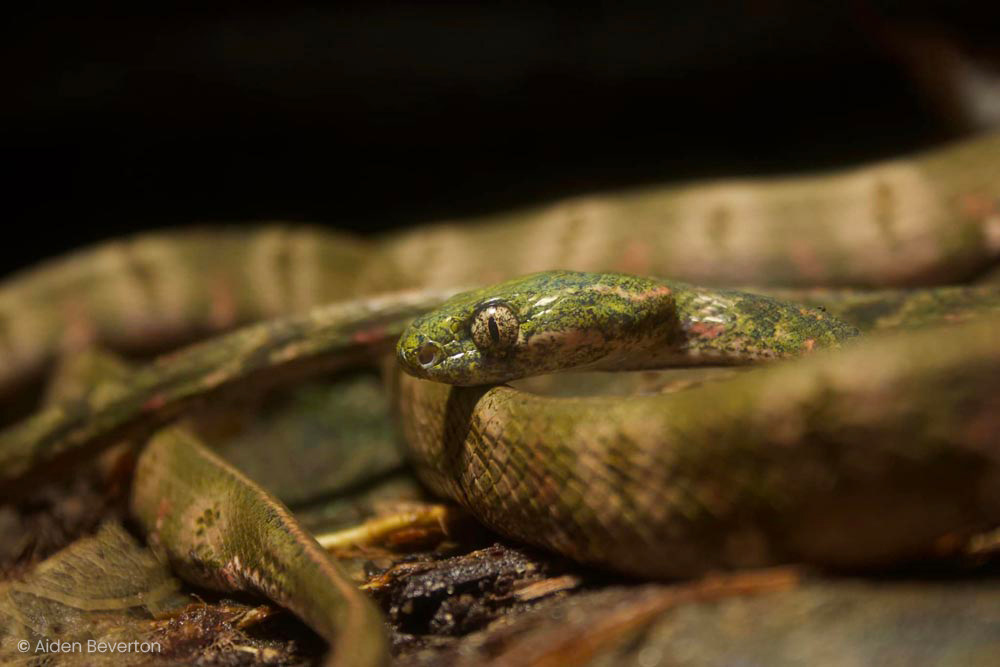
Bengkulu cat snakes (Boiga bengkuluensis)
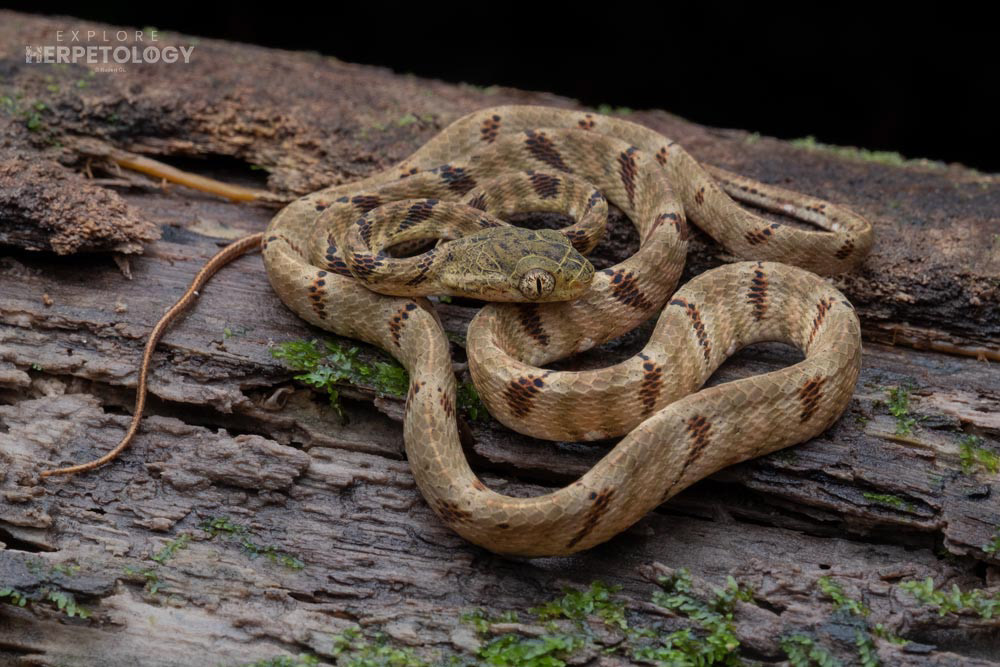
Juvenile Bengkulu cat snakes (Boiga bengkuluensis)
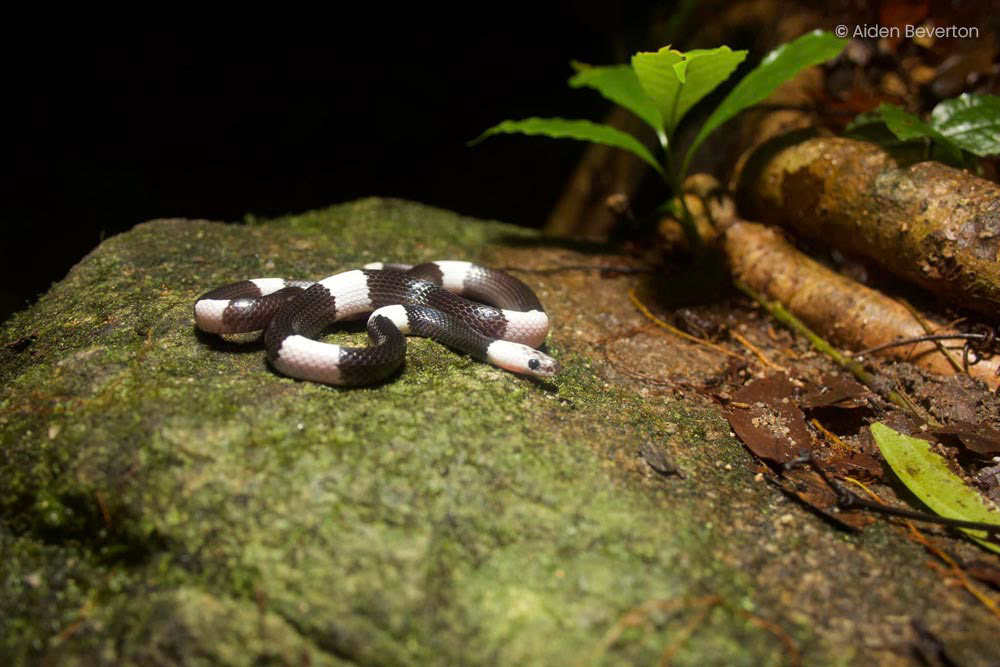
Malayan banded wolf snake (Lycodon subcinctus)
After a couple hours, we finally found our target viper for that particular forest area, the lowland form of the Sabah pit viper (Trimeresurus sabahi/fucatus). Shortly after, I caught a dusky/slender wolf snake (Lycodon albofuscus).
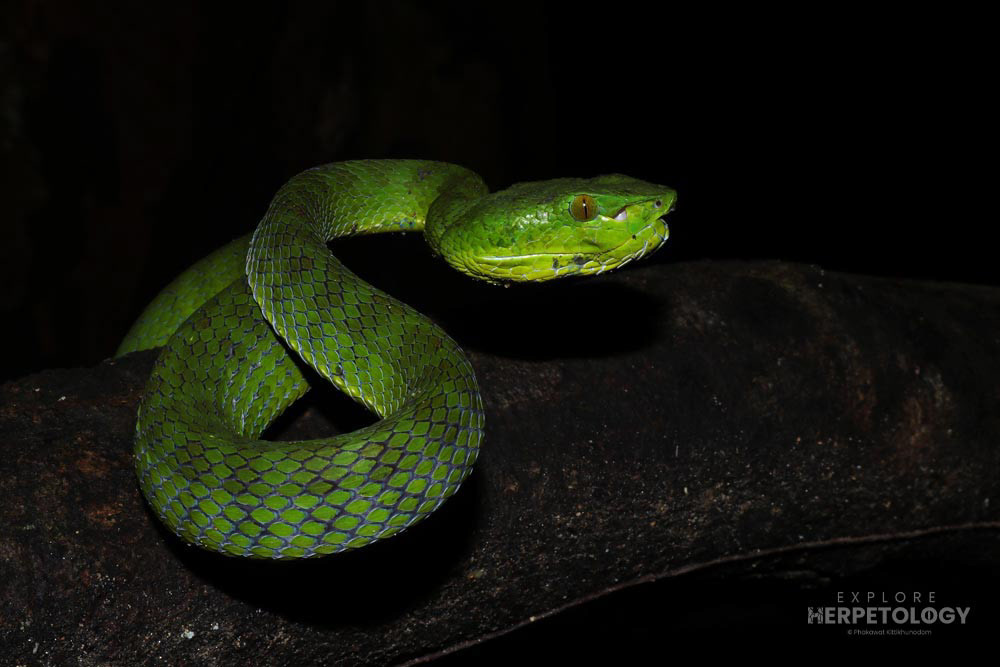
Sabah pit viper (Trimeresurus sabahi/fucatus)
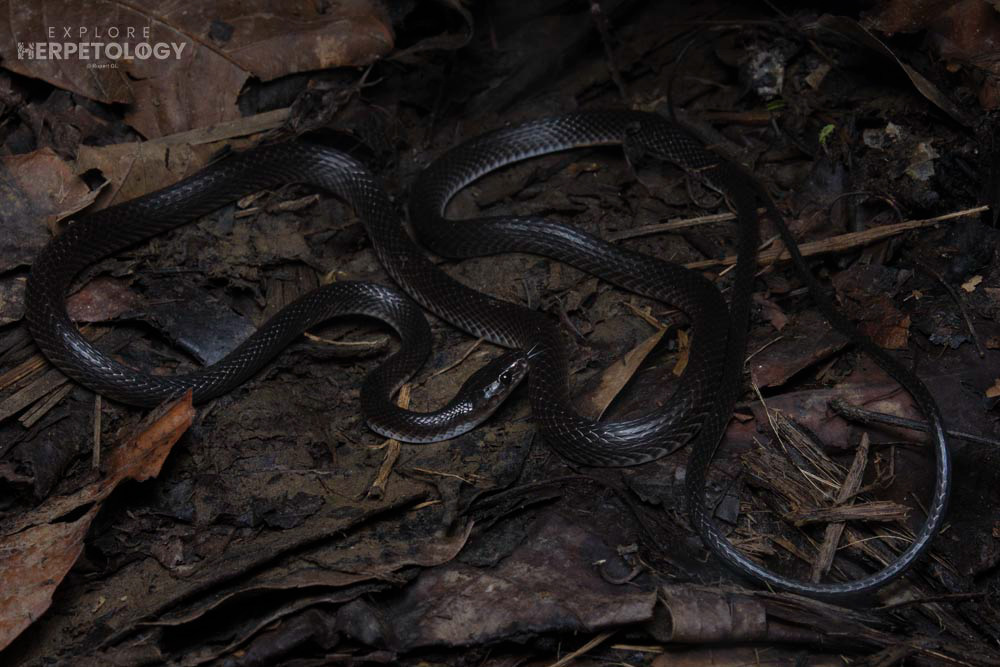
Dusky/slender wolf snake (Lycodon albofuscus)
A really special non-snake observation that evening was a Supachai’s caecilian (Ichthyophis cf. supachaii). Additional encounters included Hendrickson’s litter frog (Leptobrachium hendricksonii), a Blandford’s flying lizard (Draco blandfordi), a Malayan vine snake (Ahaetulla mycterizans) and Kumpol’s day gecko (Cnemaspis kumpoli).
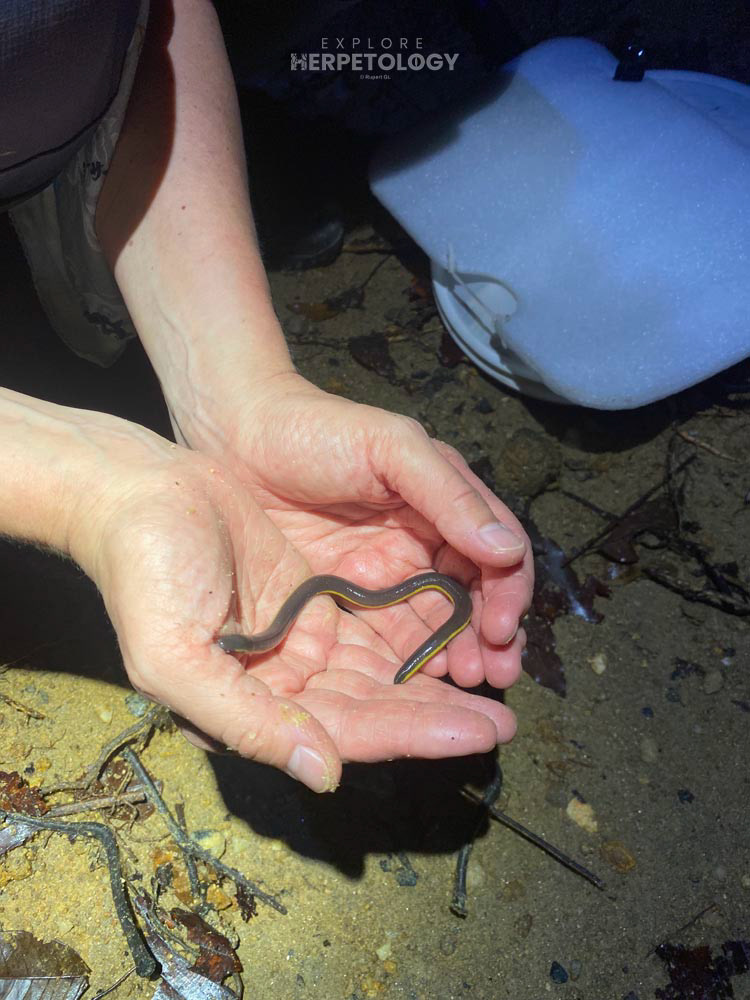
Supachai’s caecilian (Ichthyophis cf. supachaii)
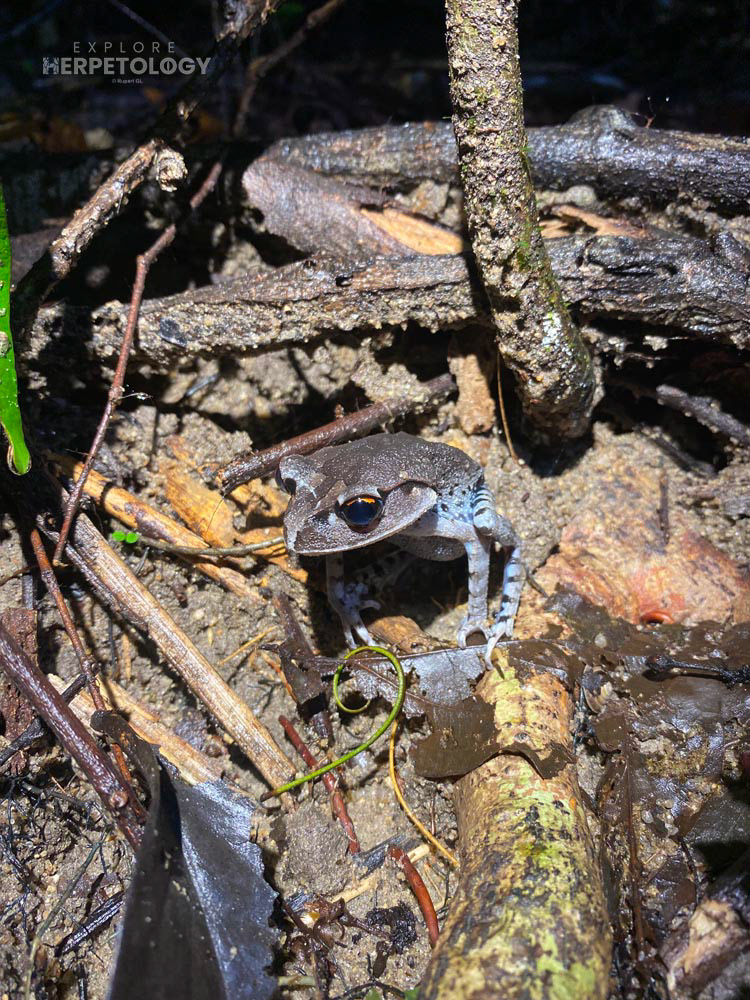
Hendrickson’s litter frog (Leptobrachium hendricksonii)
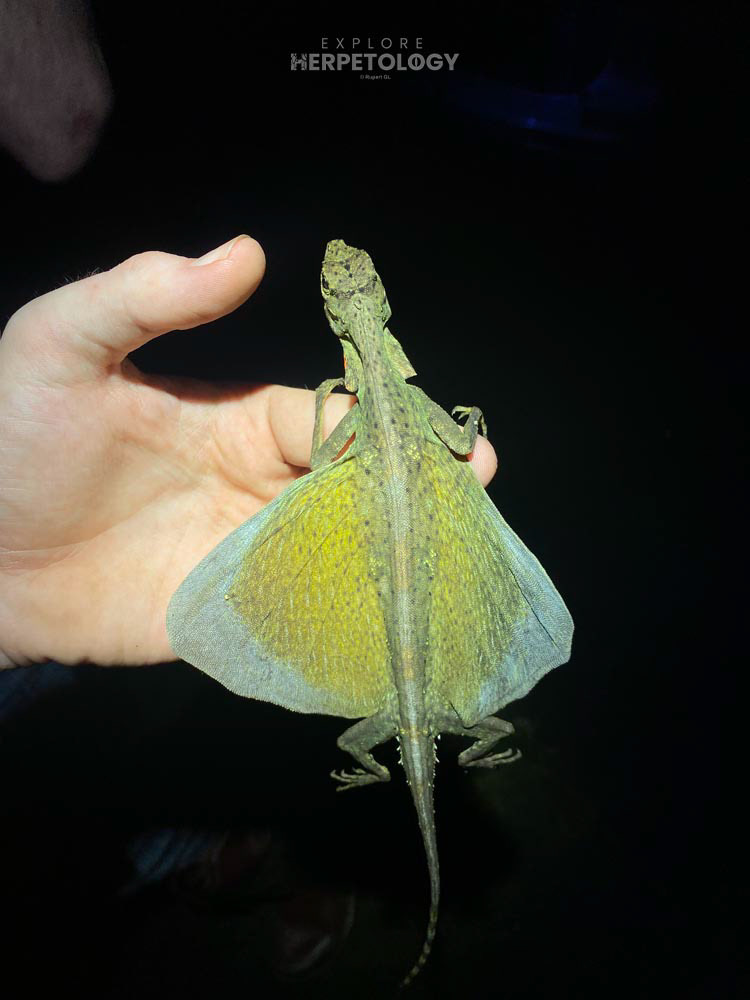
Blandford’s flying lizard (Draco blandfordi)
Now it was on to Satun province, undoubtedly the area that our team were most highly anticipating. Snakes are notoriously difficult to find here, but the incredible biodiversity and potential for rare species makes this area an absolute must.
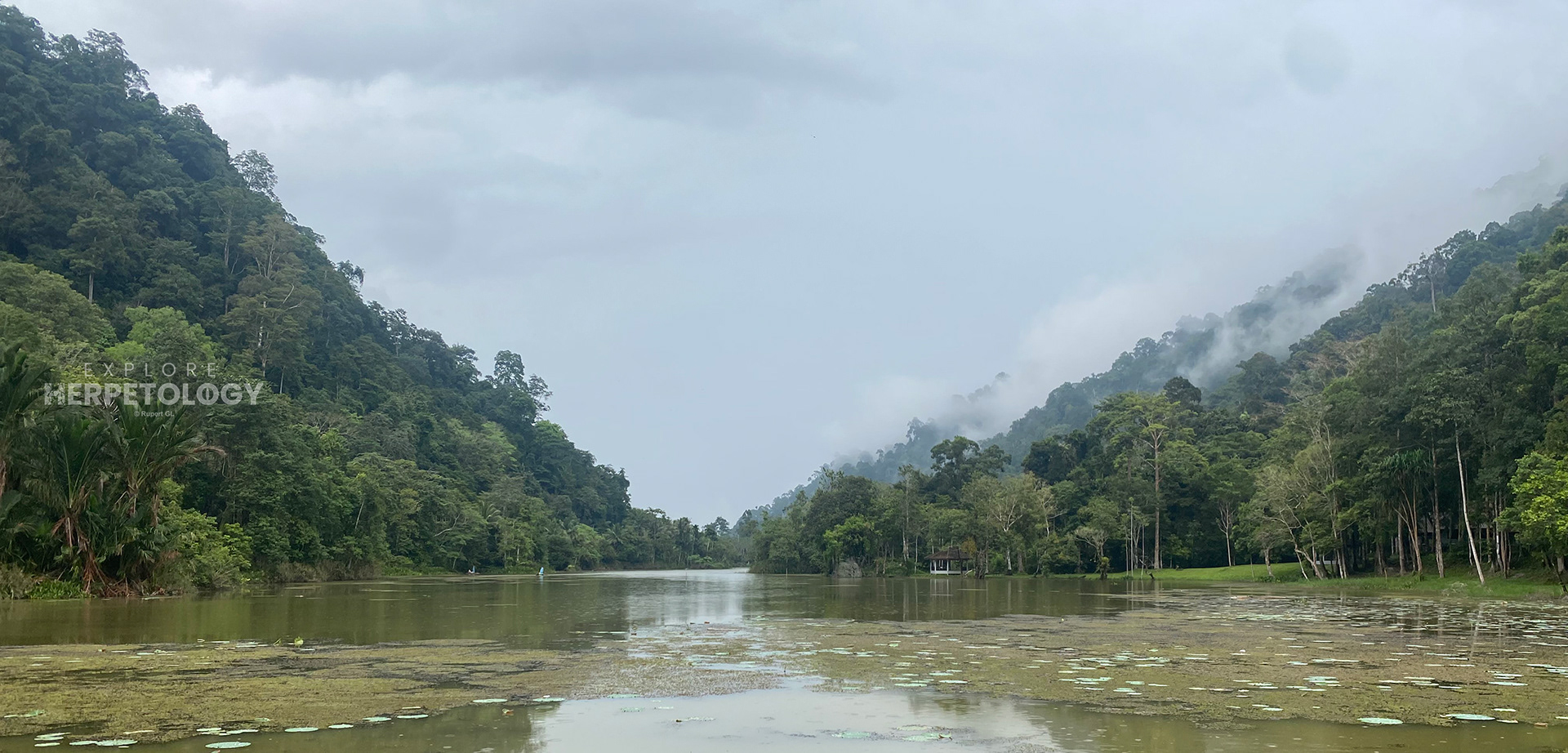
Indeed, we only found two snakes on the first night, a ~3 meter long white-bellied rat snake (Ptyas fusca) and a mangrove cat snake (Boiga melanota). This did not matter though, as lizards totally stole the show. First, we found an adult male and adult female Abbott’s angle-headed lizard (Gonocephalus abbotti) sleeping on the same sapling, an extremely rare and special agamid - this was the first time seeing an adult male for our whole team. Next, we found two adult male great angle-headed lizards (Gonocephalus grandis), along with a couple beautiful armored horned lizards (Acanthosaura armata). Possibly the most impressive lizard of all was a truly giant water monitor (Varanus salvator) which was found sleeping in a hole near a stream, which David managed to retrieve. Another non-snake reptile from our first night in Satun was a pair of enigmatic leaf turtles (Cyclemys enigmatica).
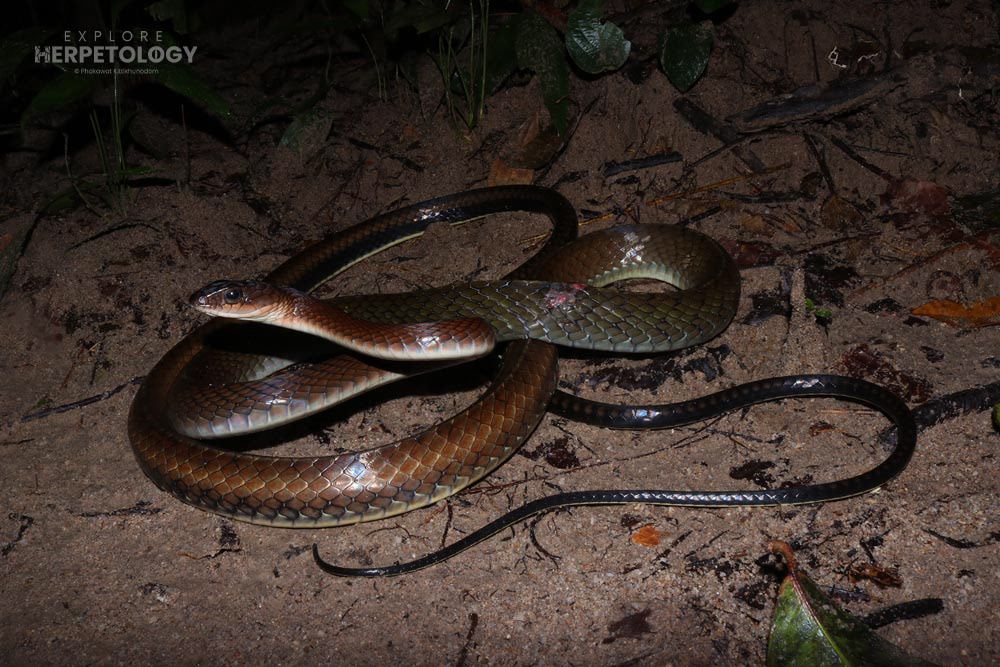
White-bellied rat snake (Ptyas fusca)
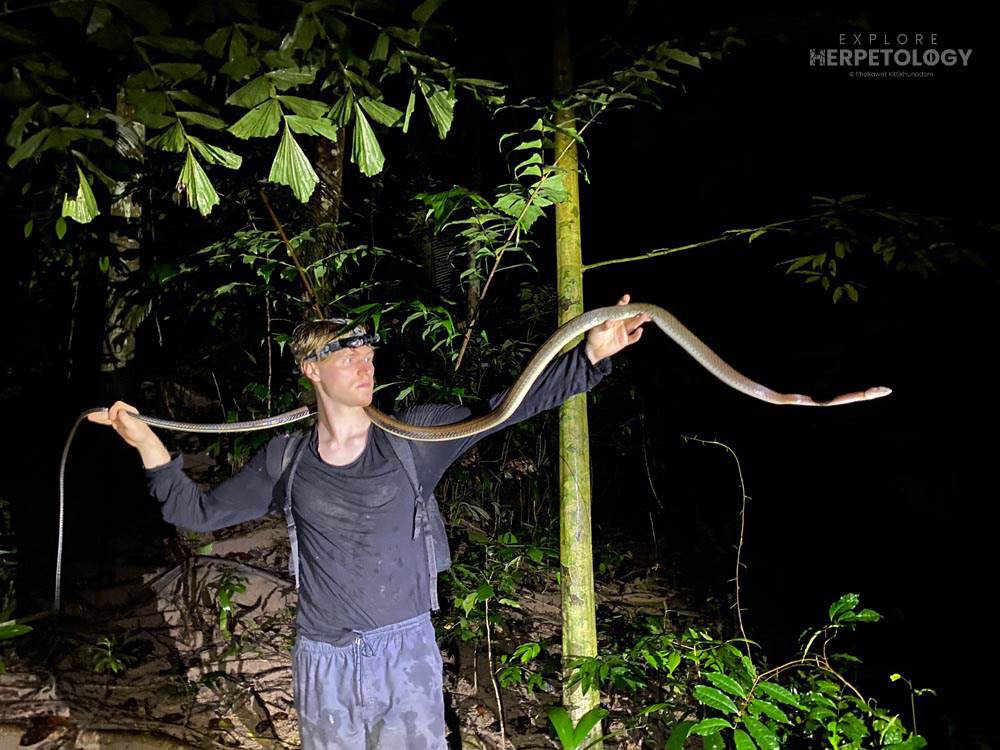
White-bellied rat snake (Ptyas fusca)
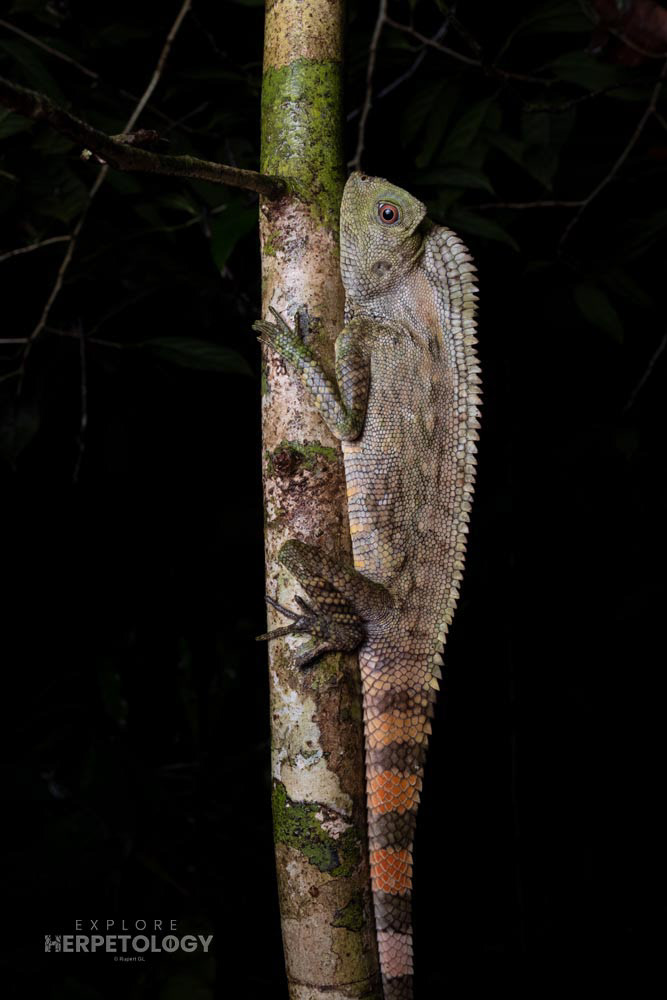
Female Abbott’s angle-headed lizard (Gonocephalus abbotti)
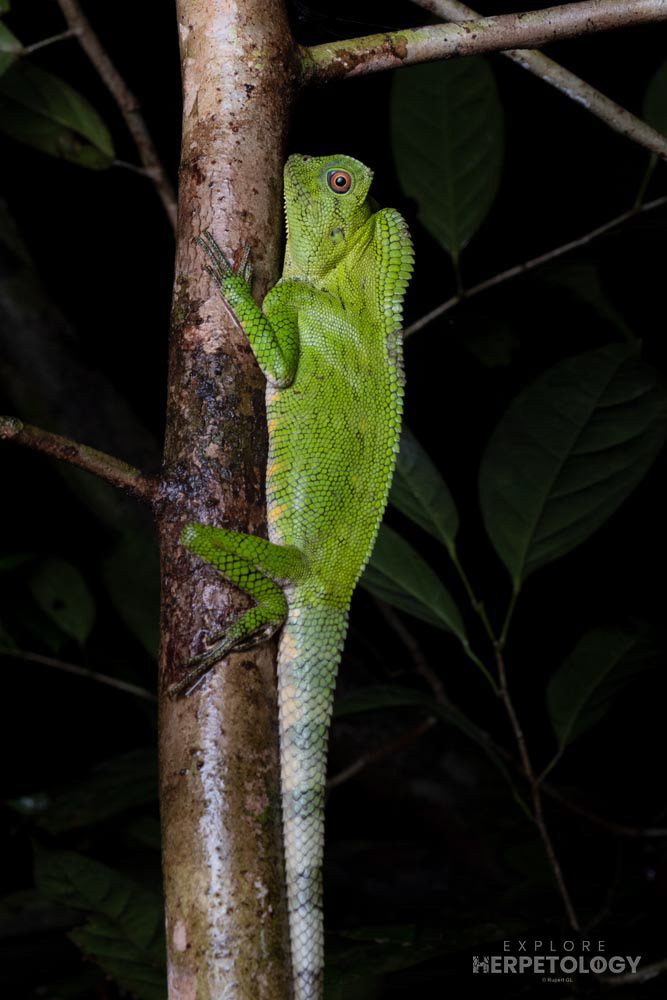
Male Abbott’s angle-headed lizard (Gonocephalus abbotti)
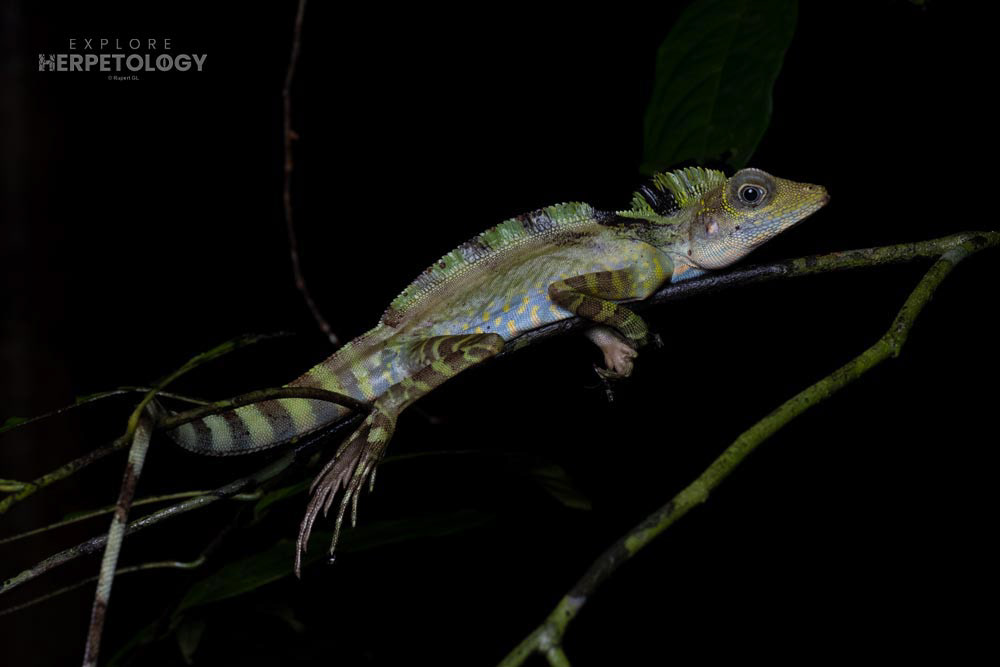
Great angle-headed lizards (Gonocephalus grandis)
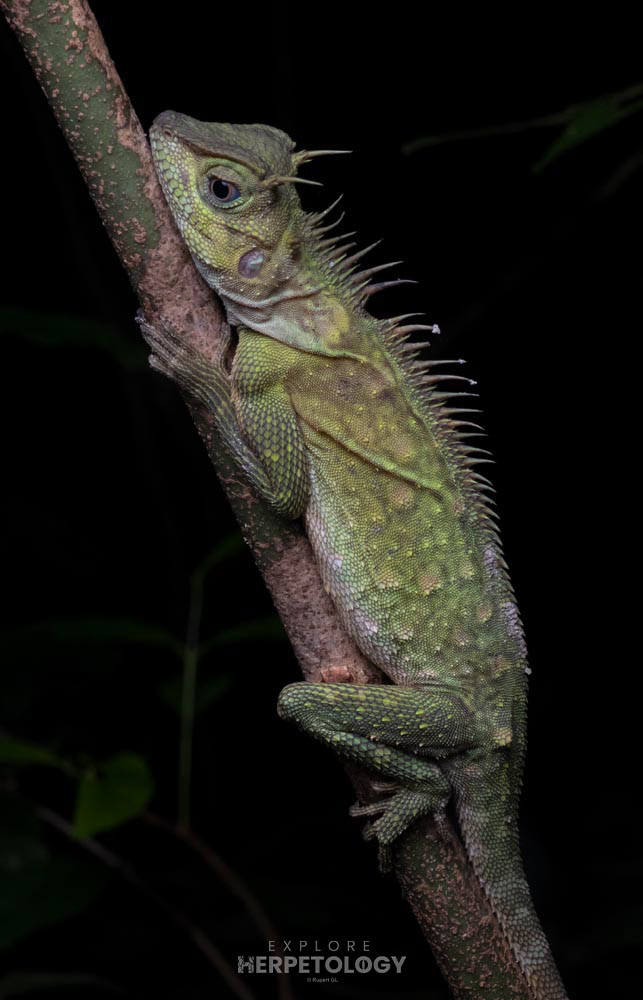
Armored horned lizards (Acanthosaura armata)
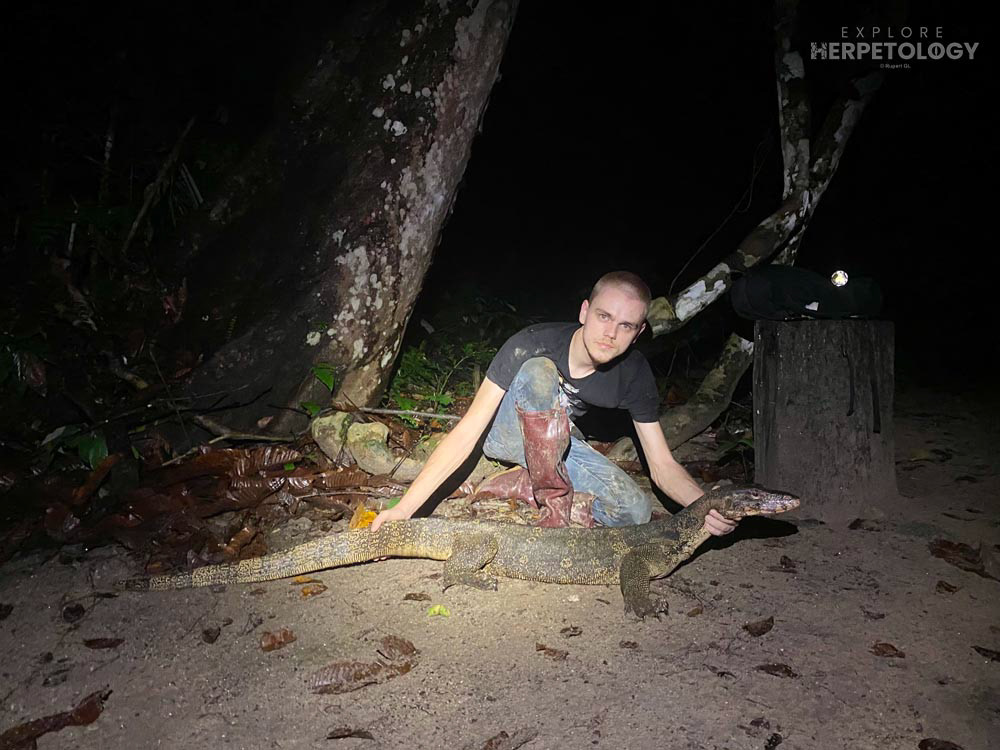
Water monitor (Varanus salvator)
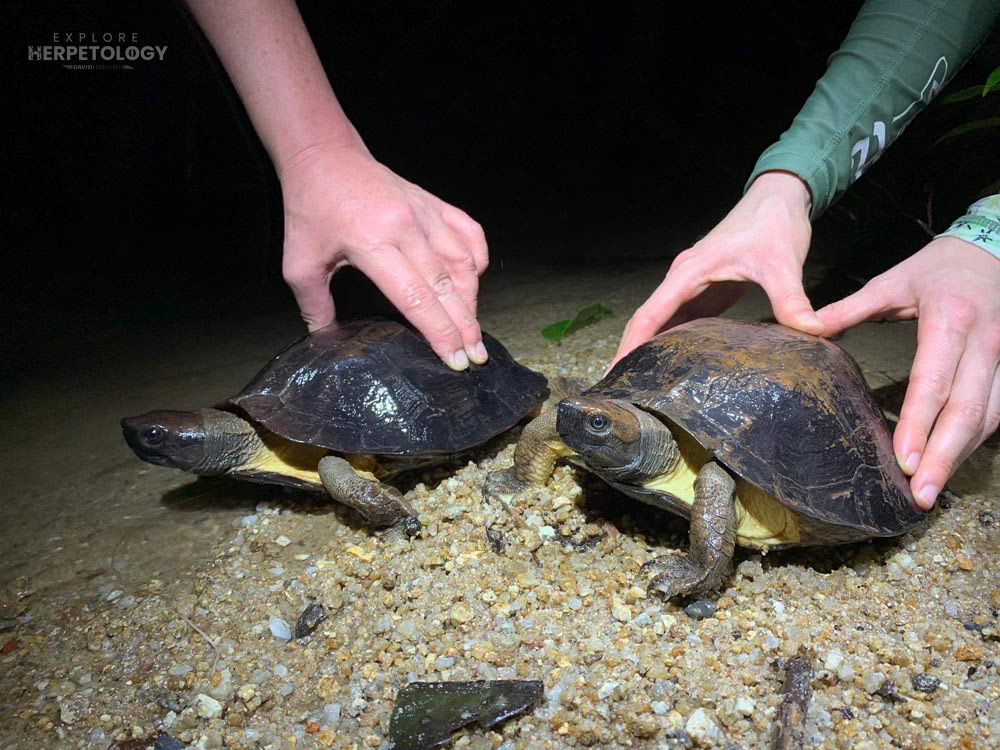
Enigmatic leaf turtles (Cyclemys enigmatica)
Thankfully, we got less rain during the second day in Satun which meant a lot less leeches and easier hiking during our second night, which in turn resulted in more snakes. The first snake of the night was a banded morph of the Malayan bridle snake (Lycodon subannulatus), followed by a couple keeled slug snakes (Pareas carinatus) and a reticulated python (Malayopython reticulatus) which was left in situ. A long time passed with no snakes until Harry looked down at the trail and spotted an adult red-headed krait (Bungarus flaviceps) almost at his feet. This was arguably the biggest target of the entire trip - the species we used as the promo image for it - and it had been months since we had seen one.
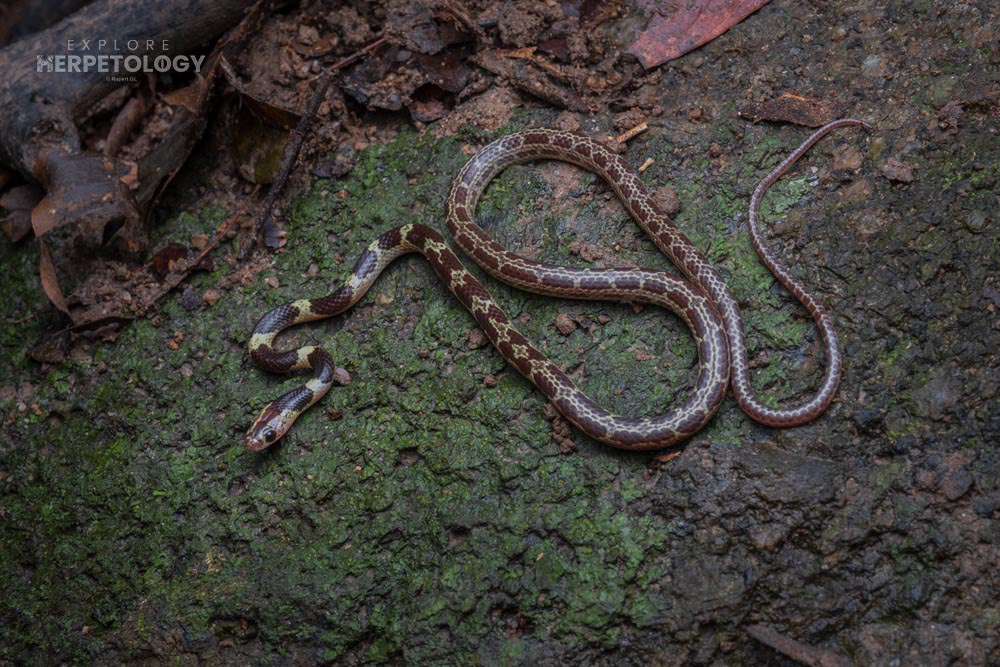
Malayan bridle snake (Lycodon subannulatus)
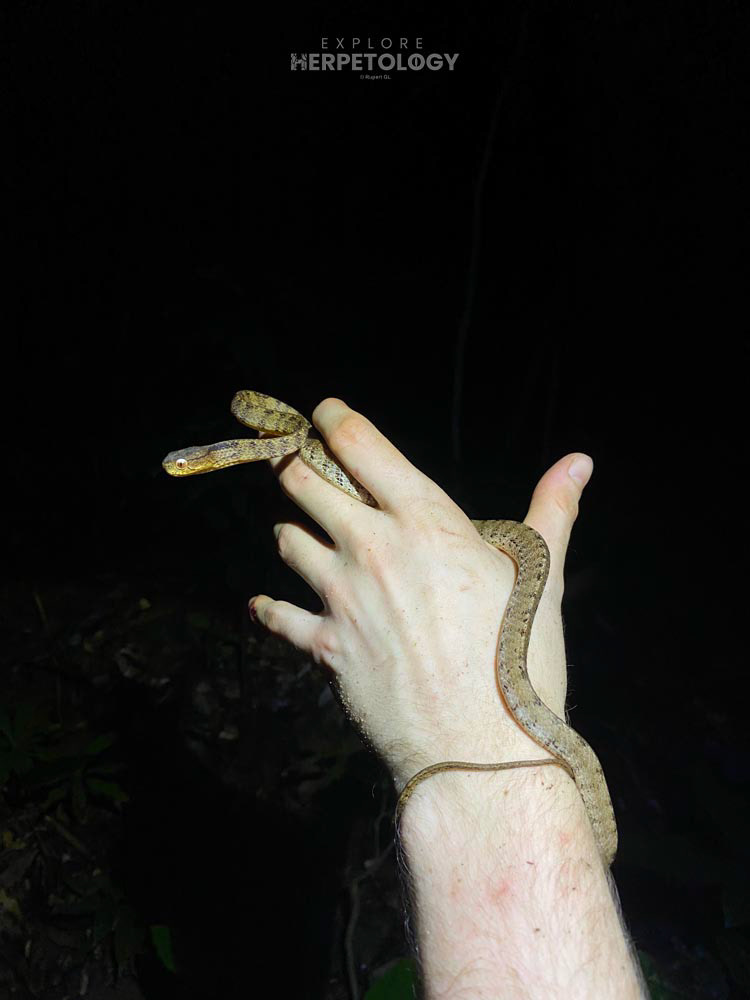
Keeled slug snake (Pareas carinatus)
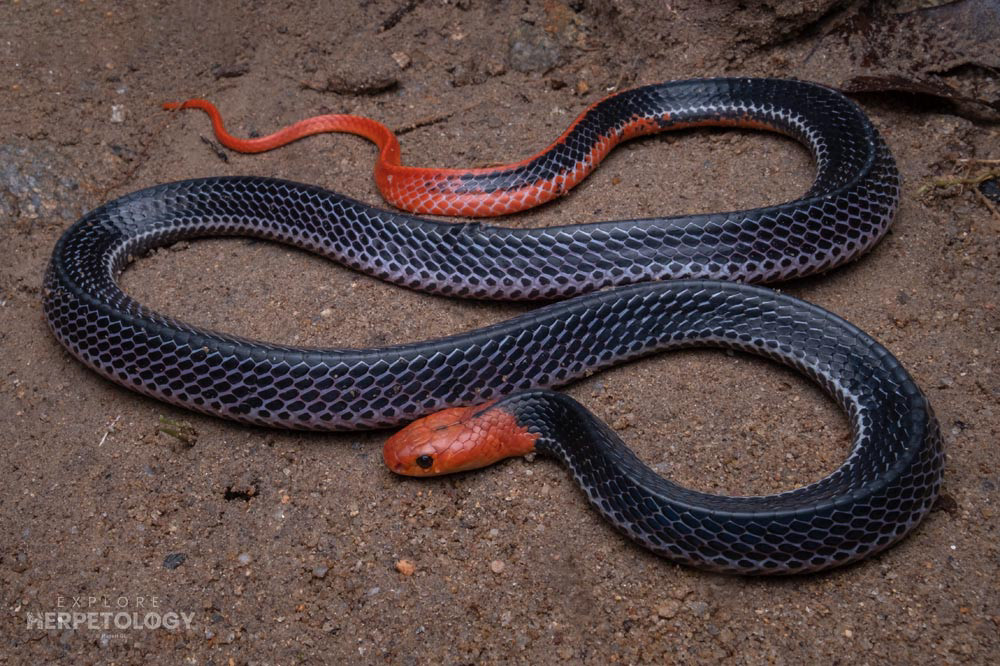
Red-headed krait (Bungarus flaviceps)
This was not the end of snakes for the night, as when we went to photograph the krait, a purple kukri snake (Oligodon purpuracens) crossed the trail right in front of us. Other interesting encounters that night included an earless agamid (Aphaniotis fusca) and a cinnamon frog (Nyctixalus pictus) which avoided photographs.
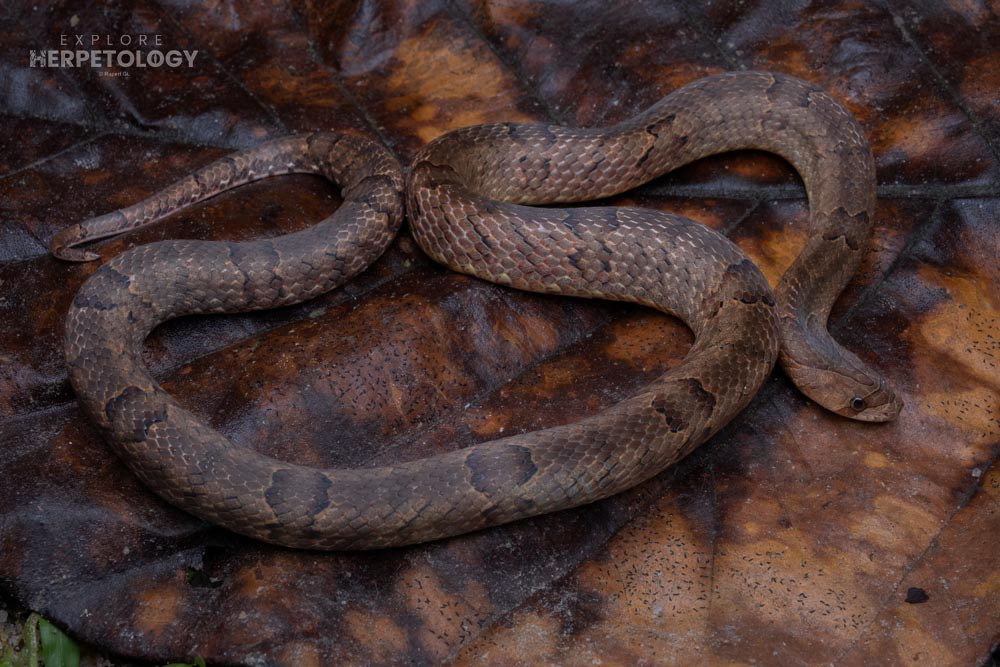
Purple kukri snake (Oligodon purpuracens)
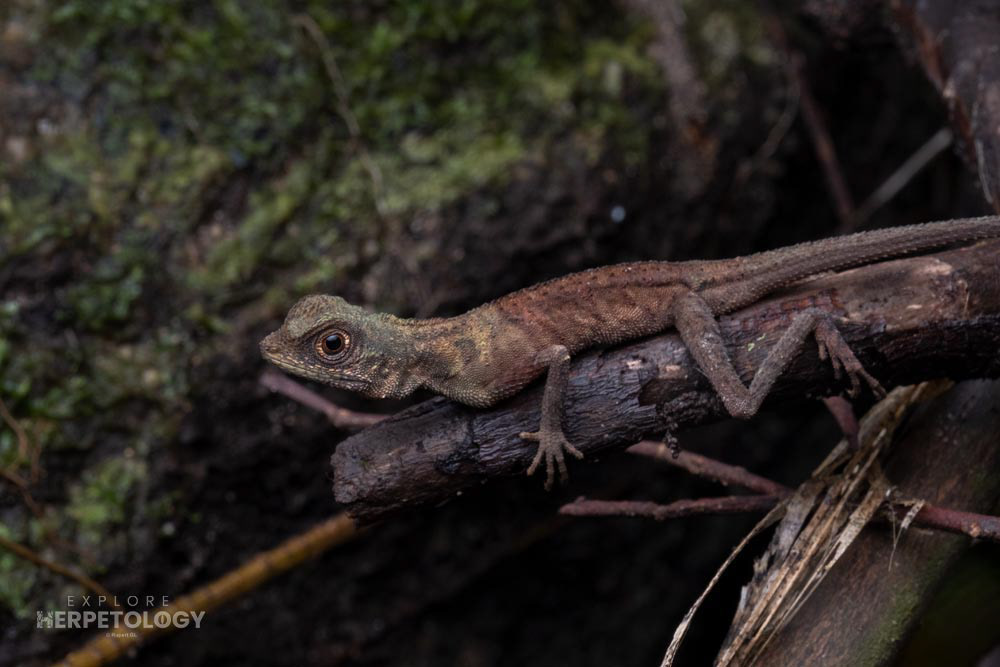
Earless agamid (Aphaniotis fusca)
From here it was onto the penultimate night and the final location of the trip, a remote yet extremely productive area in Phatthalung province. The night started rapidly with a mangrove cat snake (Boiga melanota), asian vine snake (Ahaetulla prasina) and reticulated python (Malayopython reticulatus) along a small area right outside our bungalows. Further along the path, I got completely soaked catching a large puff-faced water snake (Homalopsis buccata) and later, while investigating some puddles surrounded by breeding tree frogs, caught a juvenile dog-toothed cat snake (Boiga cynodon).
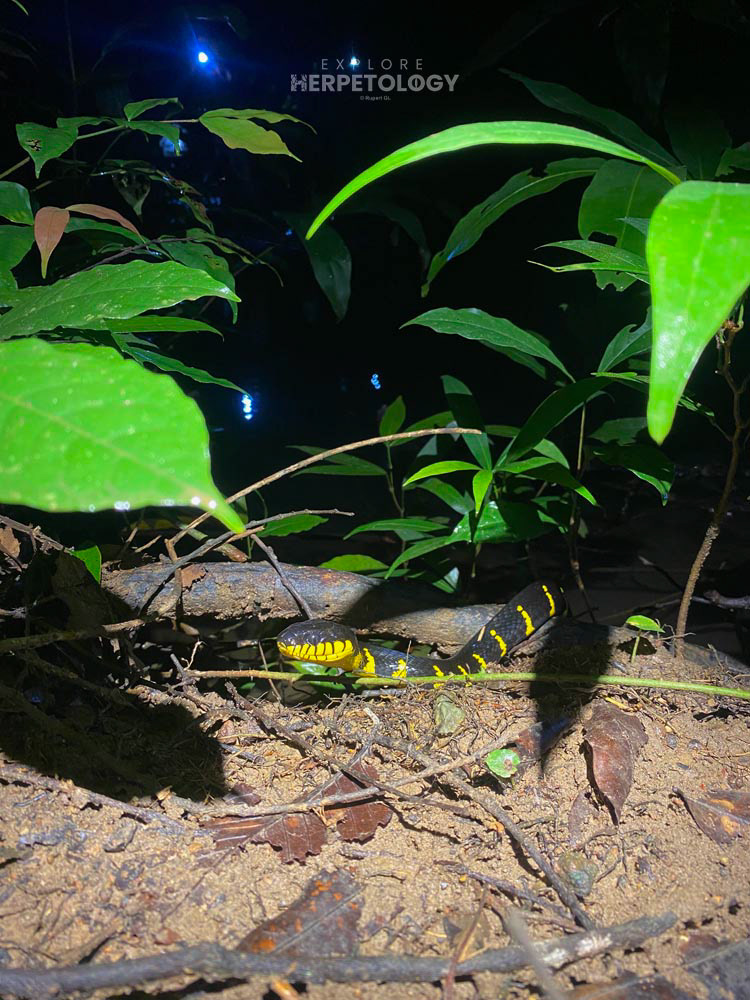
Mangrove cat snake (Boiga melanota)
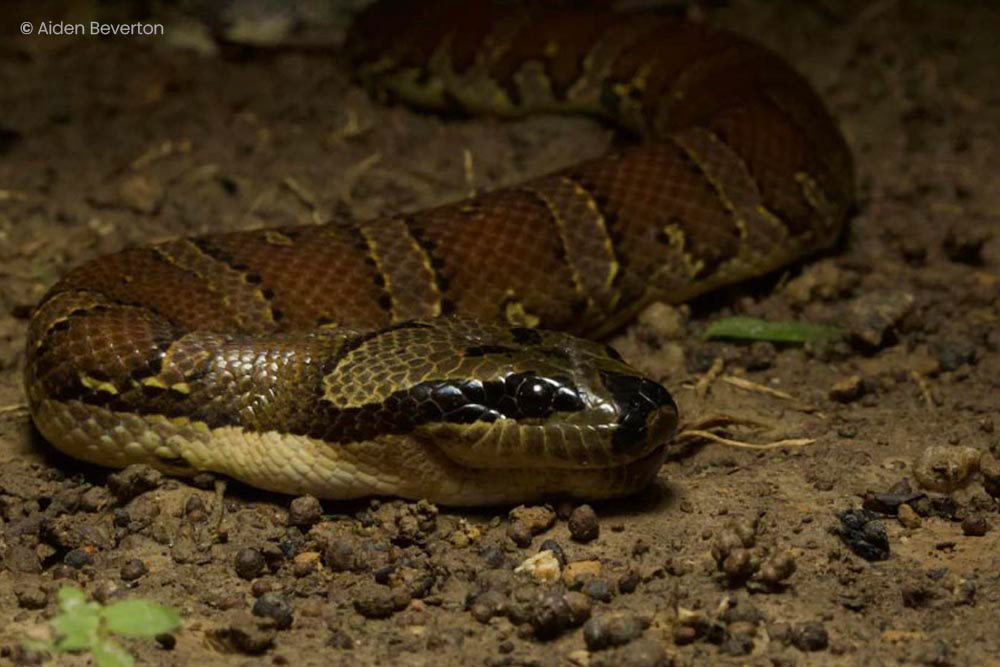
Puff-faced water snake (Homalopsis buccata)
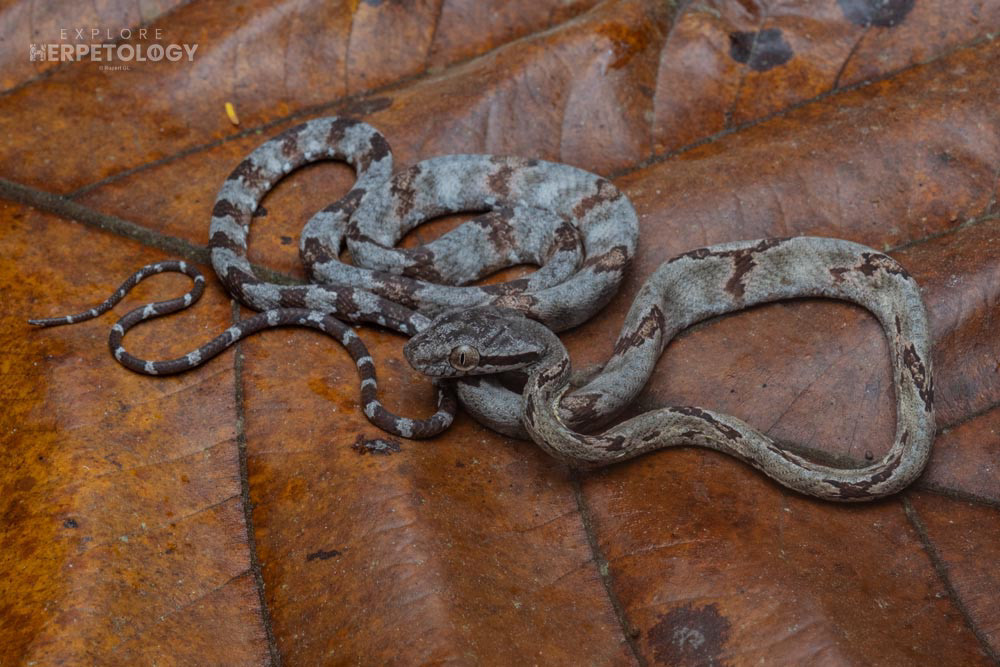
Juvenile Dog-toothed cat snake (Boiga cynodon)
The tree frogs calling around the small pools were Karin shrub frogs (Raorchestes parvulus) and frilled tree frogs (Rhacophorus appendiculatus).
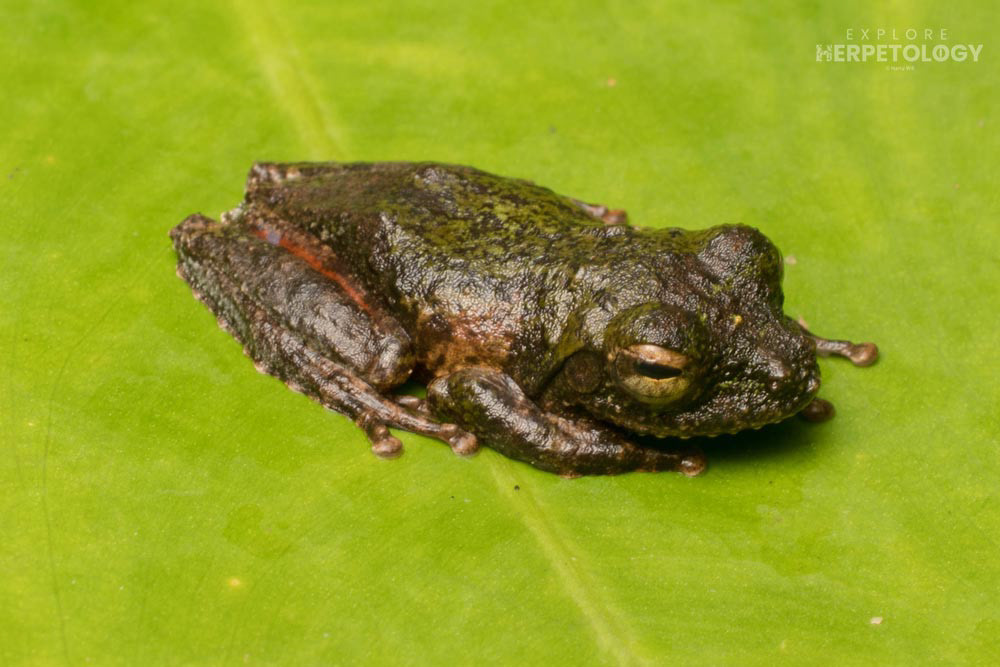
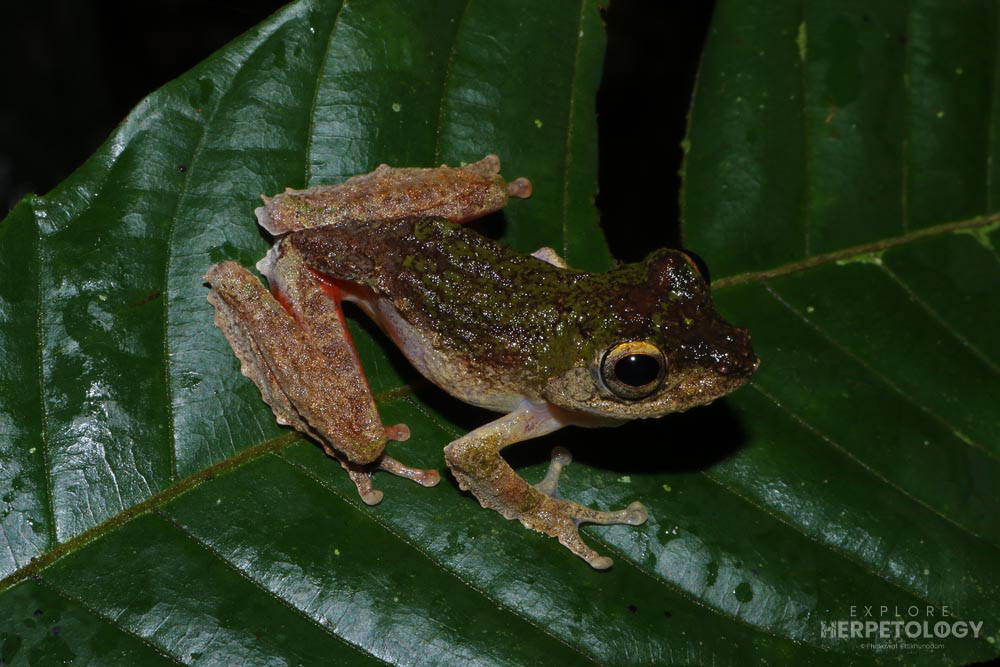
We encountered several more snakes that night. Repeat species included a Ridley’s cave racer (Elaphe taeniura ridleyi), a keeled slug snake (Pareas carinatus), a Malayan vine snake (Ahaetulla mycterizans) and yet another purple kukri snake (Oligodon purpurascens), while 2 white-spotted slug snakes (Pareas margaritophorus), a sunbeam snake (Xenopeltis unicolor), and a blue bronzeback (Dendrelaphis cyanochloris) were all new species for the trip.

Ridley’s cave racer (Elaphe taeniura ridleyi)
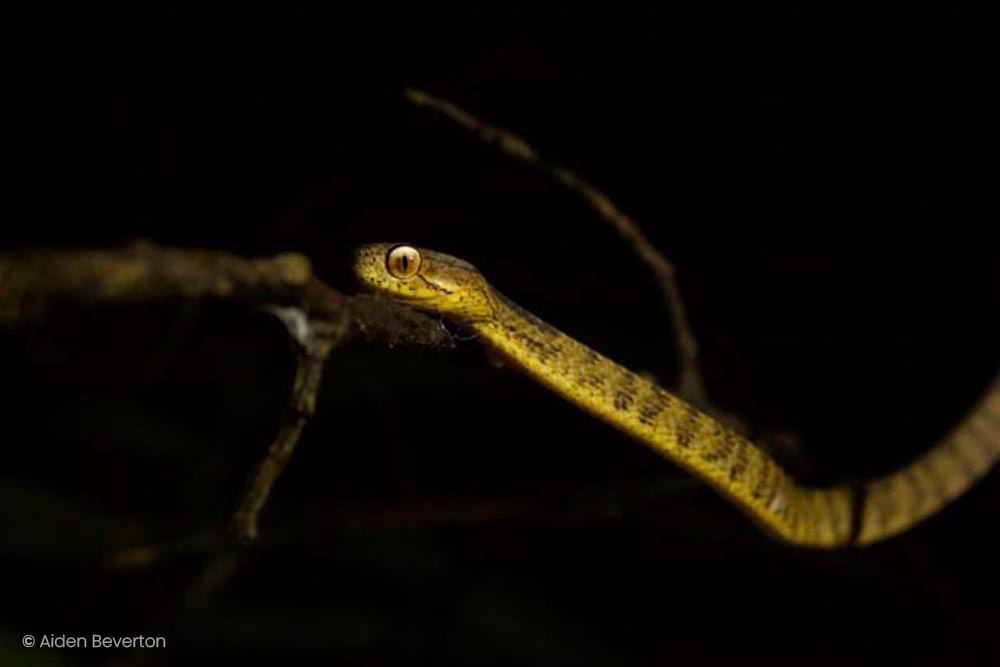
Keeled slug snake (Pareas carinatus)
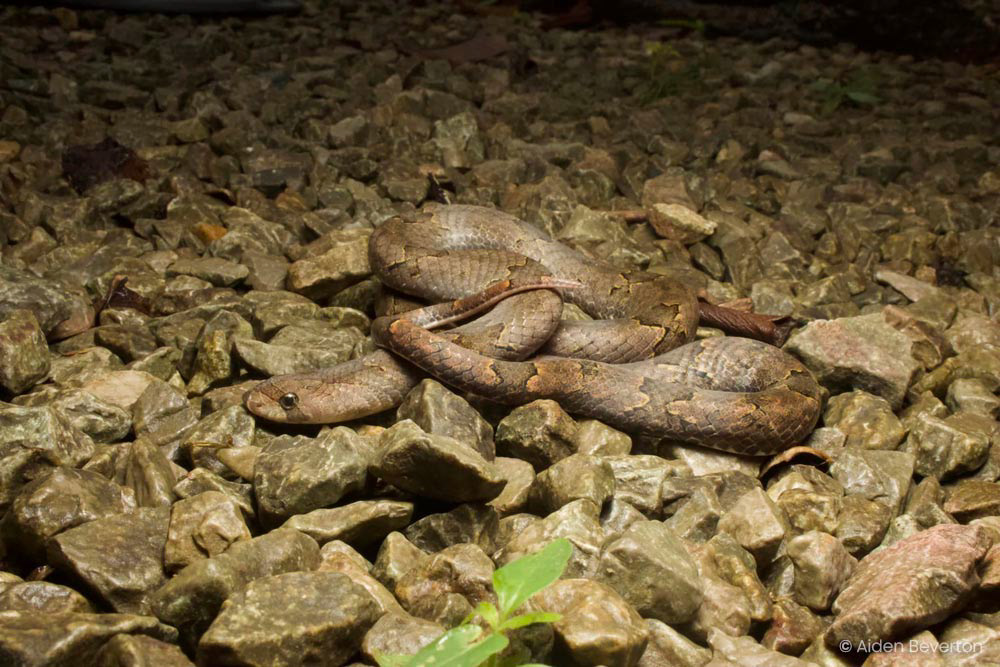
Purple kukri snake (Oligodon purpurascens)
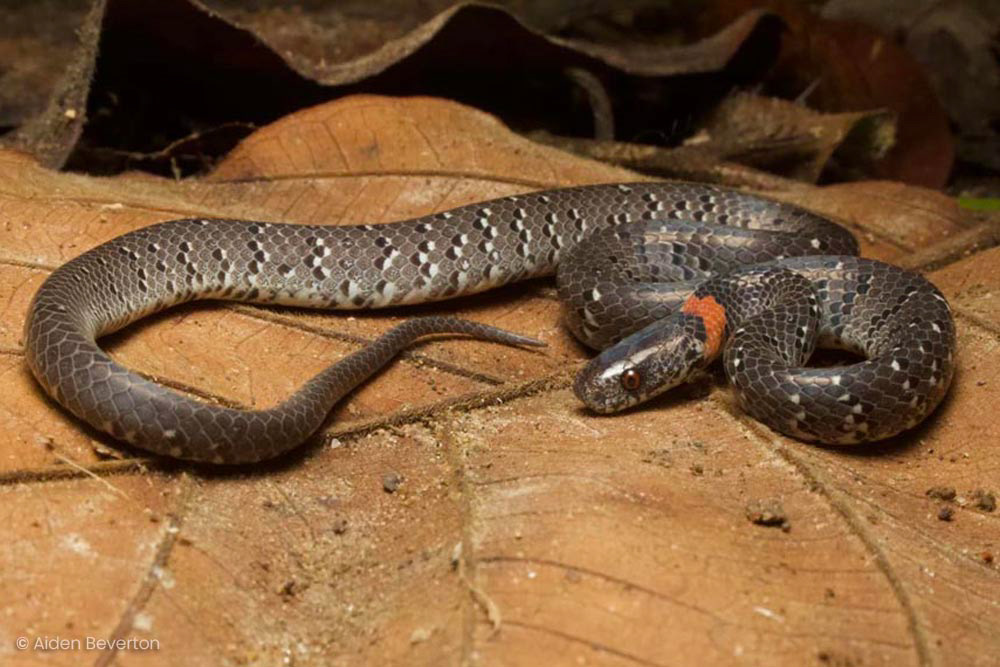
White-spotted slug snakes (Pareas margaritophorus)
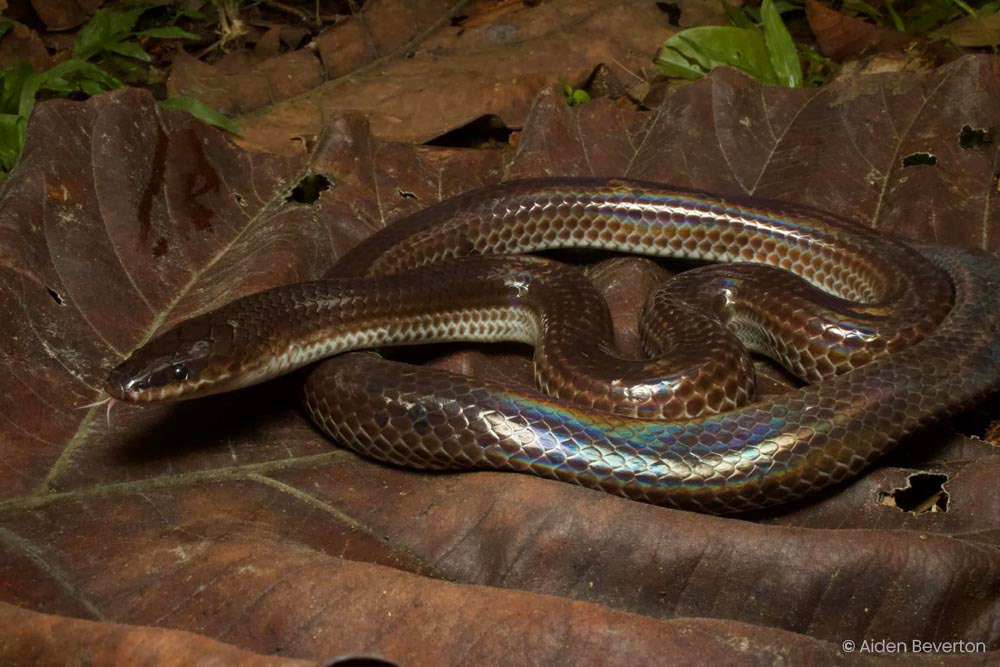
Sunbeam snake (Xenopeltis unicolor)
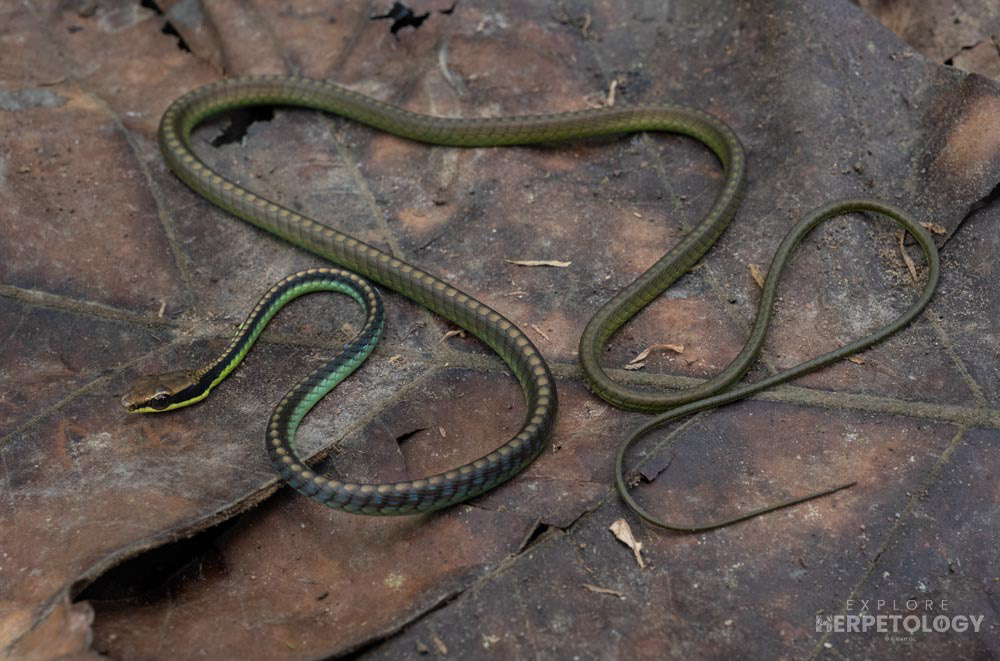
Blue bronzeback (Dendrelaphis cyanochloris)
After the initial hiking around our accommodation, some of us visited an adjacent waterfall and found two more Malayan vine snakes (Ahaetulla mycterizans), an adult dog-toothed cat snake (Boiga cynodon) and a hatchling Bengkulu cat snake (Boiga bengkuluensis).
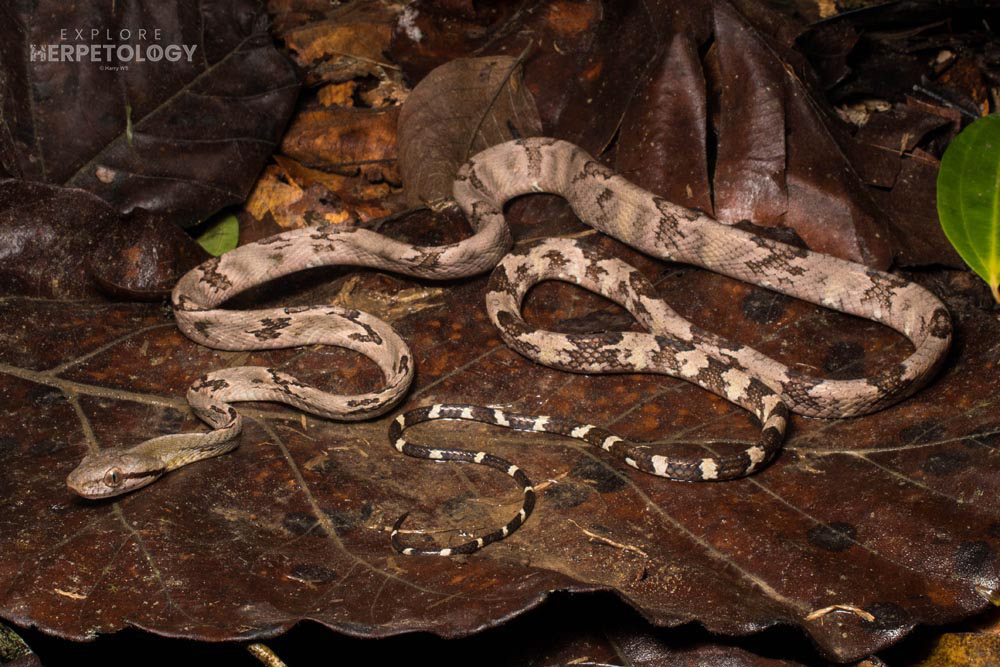
Dog-toothed cat snake (Boiga cynodon)
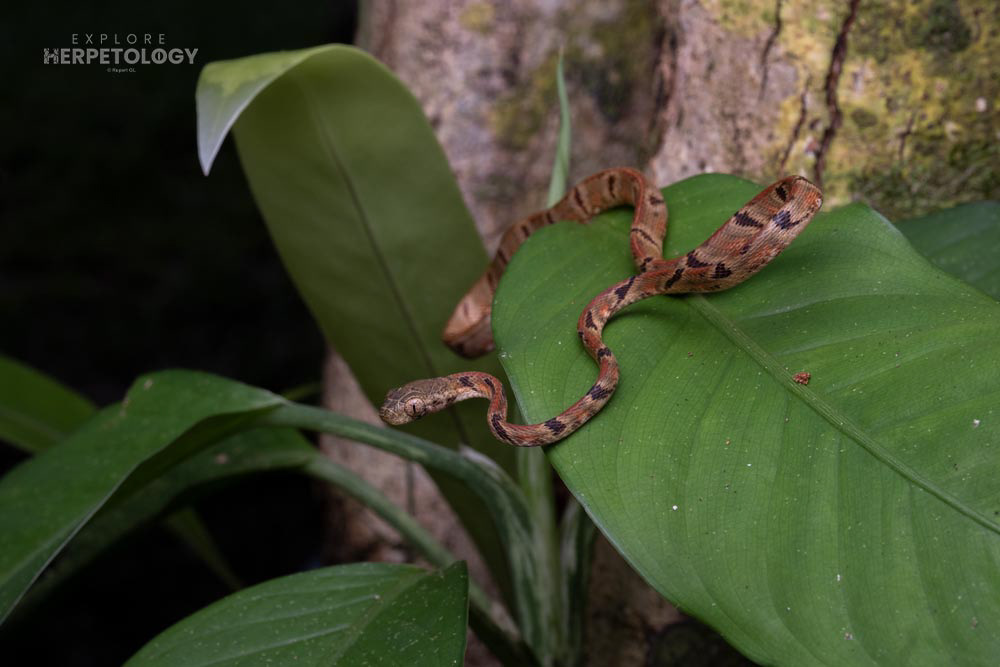
Hatchling Bengkulu cat snake (Boiga bengkuluensis)
It rained most of the final day, so we did not get a chance to herp, but come evening we drove to a swamp forest area to target some different species. Unfortunately, it was extremely flooded and our targets evaded us. We did however find several puff-faced water snakes (Homalopsis buccata) and mangrove cat snakes (Boiga melanota), as well as our 5th reticulated python (Malayopython reticulatus) of the trip. The only new species for the trip in this area was a yellow-spotted keelback (Fowlea flavipunctatus).
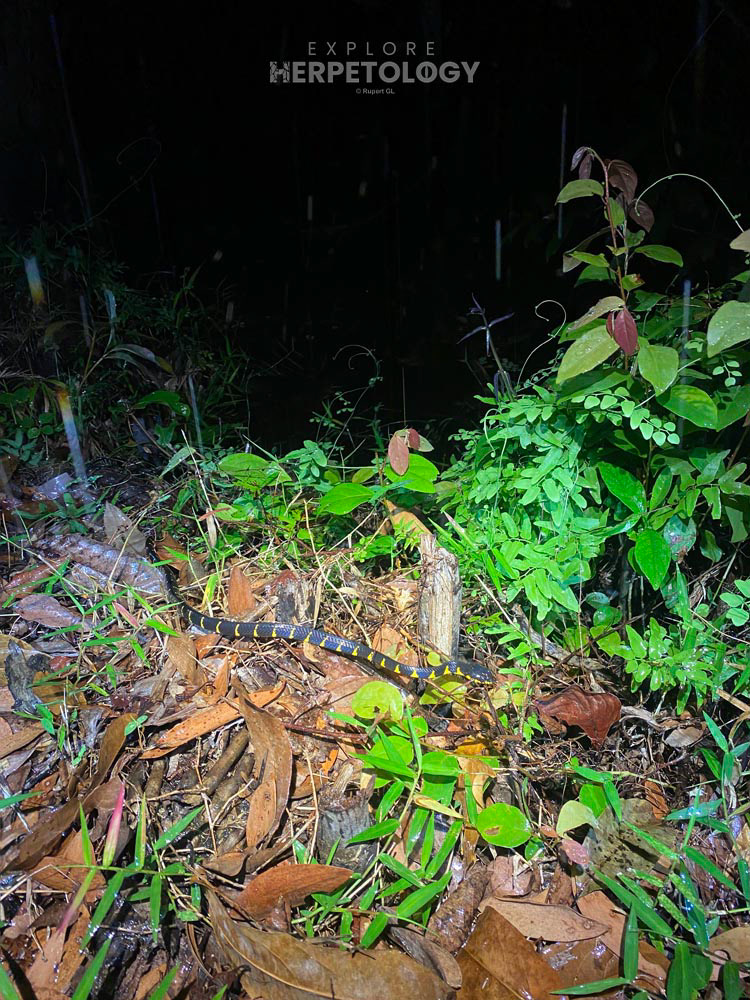
Mangrove cat snakes (Boiga melanota)
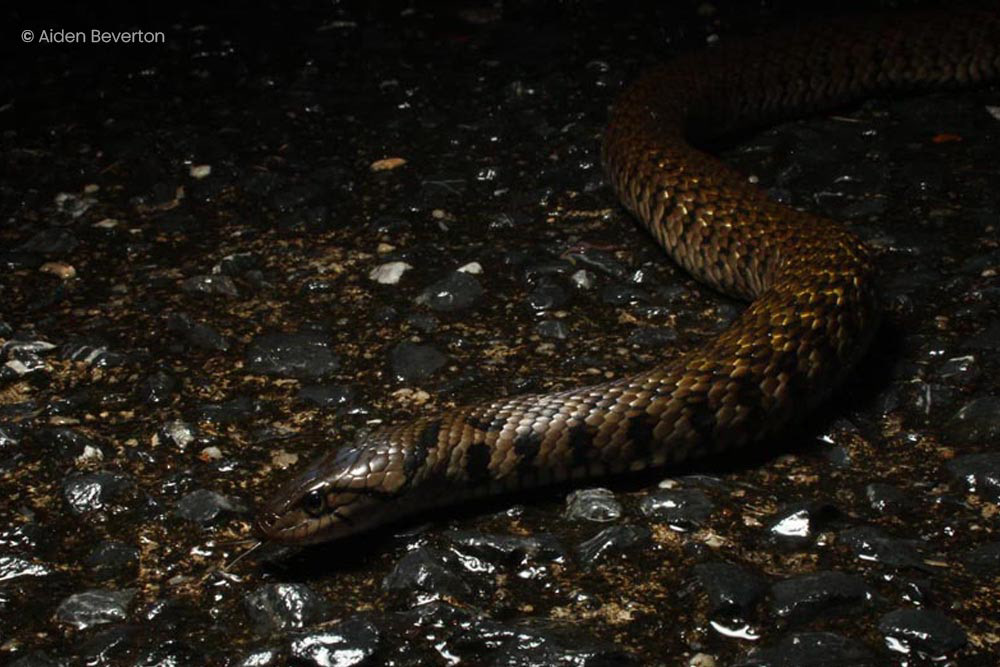
Yellow-spotted keelback (Fowlea flavipunctatus)
Back at our accommodation area, snakes were as abundant as usual. We found a large female Sabah pit viper (Trimeresurus sabahi/fucatus), more vine snakes (Ahaetulla sp.) and three new species for the trip. First was an elegant bronzeback (Dendrelaphis formosus) which escaped capture, followed by a large striped bronzeback (Dendrelaphis caudolineatus) and a red-tailed racer (Gonyosoma oxycephalum) which was too high to catch.
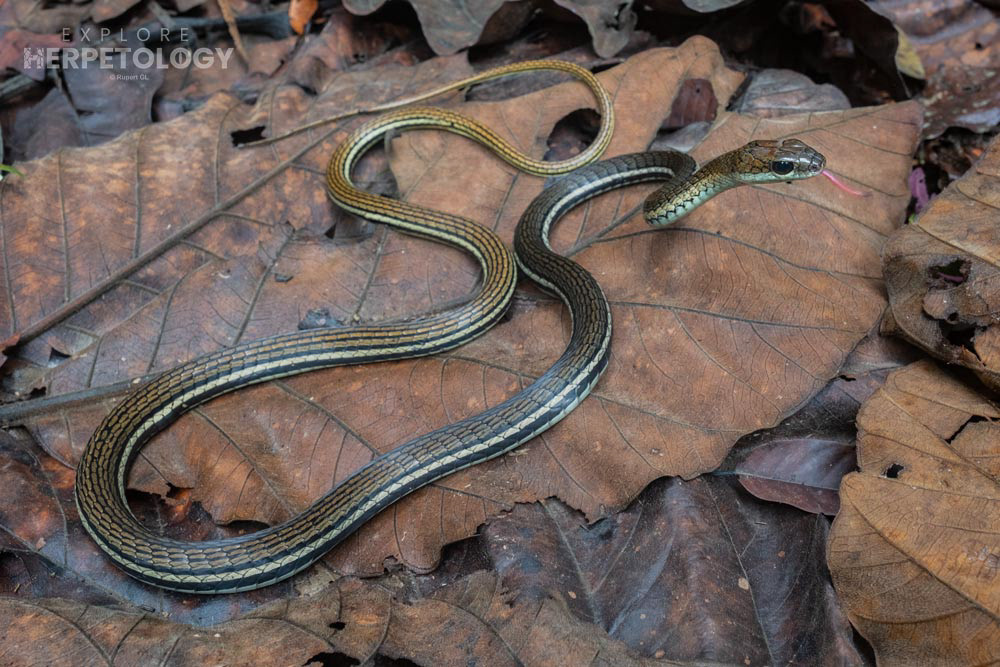
Striped bronzeback (Dendrelaphis caudolineatus)
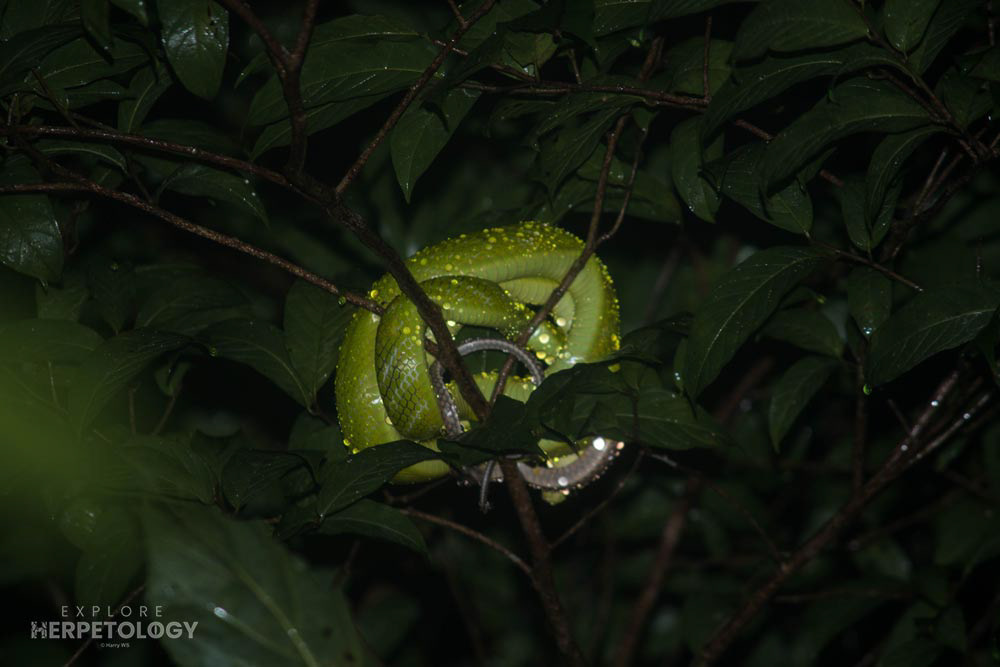
Red-tailed racer (Gonyosoma oxycephalum)
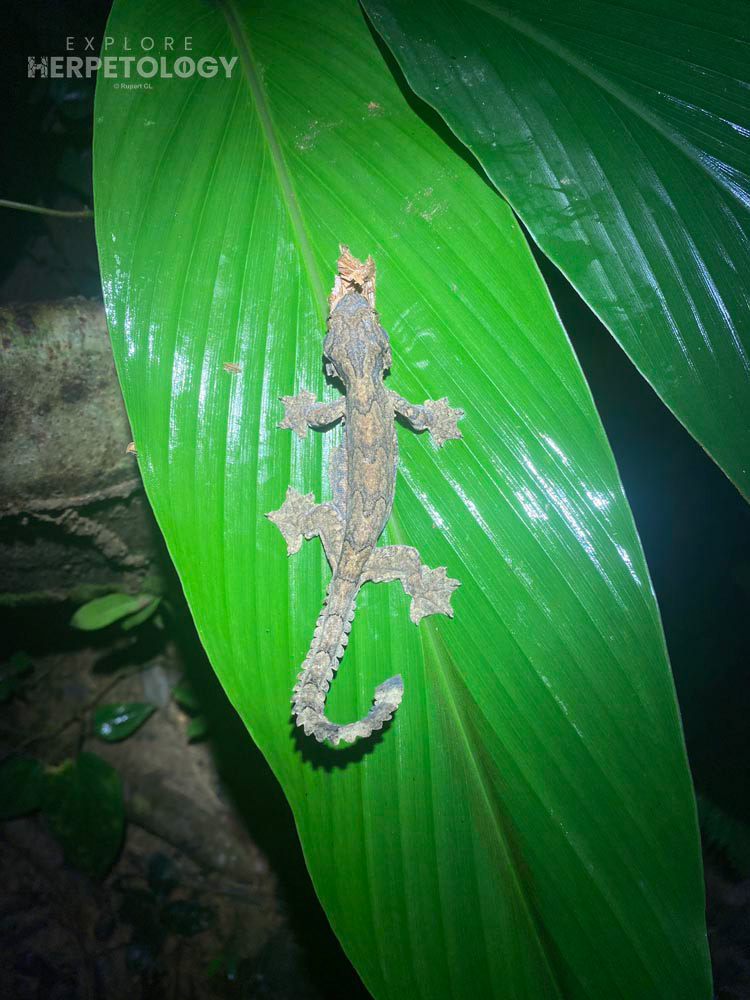
Kuhl's Gliding Gecko (Gekko kuhli)
These final snakes concluded the Thai Peninsula Herping Expedition and meant we found a total of 102 species of herpetofauna across 11 nights, including 39 species of snake. We made up for missing a few common species by several surprise encounters, and see this as the benchmark for future expeditions.
Complete Species List of the trip:
*Note: Species may appear in this list but not the above report if individuals were not photographed or observations were fleeting.
Snakes:
Ahaetulla mycterizans
Ahaetulla prasina
Boiga bengkuluensis
Boiga cynodon
Boiga melanota
Bungarus candidus
Bungarus flaviceps
Calloselasma rhodostoma
Cerberus schneiderii
Chrysopelea ornata
Coelognathus radiata
Dendrelaphis caudolineatus
Dendrelaphis cyanochloris
Dendrelaphis formosus
Dendrelaphis pictus
Elaphe taeniura ridleyi
Gonyosoma oxycephalum
Homalopsis semizonata
Lycodon albofuscus
Lycodon laoensis
Lycodon subannulatus
Lycodon subcinctus
Malayopython reticulatus
Naja kaouthia
Oligodon purpurascens
Pareas carinatus
Pareas margaritophorus
Psammodynastes pulverulentus
Ptyas fusca
Rhabdophis siamensis
Trimeresurus albolabris
Trimeresurus phuketensis
Ahaetulla prasina
Boiga bengkuluensis
Boiga cynodon
Boiga melanota
Bungarus candidus
Bungarus flaviceps
Calloselasma rhodostoma
Cerberus schneiderii
Chrysopelea ornata
Coelognathus radiata
Dendrelaphis caudolineatus
Dendrelaphis cyanochloris
Dendrelaphis formosus
Dendrelaphis pictus
Elaphe taeniura ridleyi
Gonyosoma oxycephalum
Homalopsis semizonata
Lycodon albofuscus
Lycodon laoensis
Lycodon subannulatus
Lycodon subcinctus
Malayopython reticulatus
Naja kaouthia
Oligodon purpurascens
Pareas carinatus
Pareas margaritophorus
Psammodynastes pulverulentus
Ptyas fusca
Rhabdophis siamensis
Trimeresurus albolabris
Trimeresurus phuketensis
Trimeresurus purpureomaculatus
Trimeresurus sabahi/fucatus
Trimeresurus venustus
Tropidolaemus wagleri
Xenochrophis flavipunctatus
Xenochrophis trianguligerus
Xenopeltis unicolor
Trimeresurus sabahi/fucatus
Trimeresurus venustus
Tropidolaemus wagleri
Xenochrophis flavipunctatus
Xenochrophis trianguligerus
Xenopeltis unicolor
Lizards:
Acanthosaura armata
Acanthosaura meridiona
Aphaniotis fusca
Bronchocela rayaensis
Calotes emma
Calotes versicolor
Cnemaspis phuketensis
Cnemaspis chanardi
Cnemaspis kumpoli
Cyrtodactylus brevipalmatus
Cyrtodactylus lekaguli
Cyrtodactylus macrotubercalus
Cyrtodactylus oldhami
Cyrtodactylus quadrivirgatus
Cyrtodactylus zebraicus
Draco blanfordii
Draco formosus
Eutropis multifasciata
Eutropis macularia
Gekko gecko
Gecko kuhli
Gekko tokehos
Gekko smithi
Gehyra mutilata
Gonocephalus abbotti
Gonocephalus grandis
Hemidactylus frenatus
Acanthosaura meridiona
Aphaniotis fusca
Bronchocela rayaensis
Calotes emma
Calotes versicolor
Cnemaspis phuketensis
Cnemaspis chanardi
Cnemaspis kumpoli
Cyrtodactylus brevipalmatus
Cyrtodactylus lekaguli
Cyrtodactylus macrotubercalus
Cyrtodactylus oldhami
Cyrtodactylus quadrivirgatus
Cyrtodactylus zebraicus
Draco blanfordii
Draco formosus
Eutropis multifasciata
Eutropis macularia
Gekko gecko
Gecko kuhli
Gekko tokehos
Gekko smithi
Gehyra mutilata
Gonocephalus abbotti
Gonocephalus grandis
Hemidactylus frenatus
Hemidactylus platyurus
Sphenomorphus maculatus
Varanus nebulosus
Varanus salvator
Sphenomorphus maculatus
Varanus nebulosus
Varanus salvator
Amphibians:
Alcalus tasanae
Chalcorana eschatia
Duttaphrynus melanosticus
Fejervarya limnocharis
Fejervarya cancrivora
Hylarana erythrea
Ichthyophis cf. supachaii
Ingerophrynus parvus
Kaloula pulchra
Leptobrachium hendricksoni
Leptobrachium smithii
Limnonectes blythii
Limnonectes khasiense
Limnonectes malesianus
Microhyla berdmorei
Microhyla heymonsi
Microhyla butleri
Micryletta lineata
Nyctixalus pictus
Occidozyga martensii
Odorrana hosii
Phrynoidis asper
Polypedates leucomystax
Polypedates discantus
Pulchrana glandulosa
Raorchestes parvulus
Rhacophorus appendiculatus
Sylvirana nigrovittata
Xenophrys aceras
Xenophrys parva
Chalcorana eschatia
Duttaphrynus melanosticus
Fejervarya limnocharis
Fejervarya cancrivora
Hylarana erythrea
Ichthyophis cf. supachaii
Ingerophrynus parvus
Kaloula pulchra
Leptobrachium hendricksoni
Leptobrachium smithii
Limnonectes blythii
Limnonectes khasiense
Limnonectes malesianus
Microhyla berdmorei
Microhyla heymonsi
Microhyla butleri
Micryletta lineata
Nyctixalus pictus
Occidozyga martensii
Odorrana hosii
Phrynoidis asper
Polypedates leucomystax
Polypedates discantus
Pulchrana glandulosa
Raorchestes parvulus
Rhacophorus appendiculatus
Sylvirana nigrovittata
Xenophrys aceras
Xenophrys parva
Turtles:
Cyclemys enigmatica
Indotestudo elongata
Indotestudo elongata


